
The sinking of the Titanic continues to captivate people more than 100 years after the tragedy due to several factors. The ship’s discovery in 1985, the release of James Cameron’s blockbuster film in 1997, and the 100th anniversary of the sinking in 2012 have all contributed to a resurgence of interest in the Titanic. So has the sinking of the super yacht Bayesian, the SS United States final voyage to serve as an artificial reef and the Titan submersible implosion.
The story of the Titanic is often described as implausible and dramatic, involving the largest ship in the world, which was deemed unsinkable, and was carrying many rich and famous individuals. The ship’s slow descent into the ocean over the course of two hours and forty minutes allowed for a full development of the drama of human choices, making the disaster particularly compelling. The sinking of the Titanic occurred on April 15, 1912, in the Atlantic Ocean after hitting an iceberg1235.
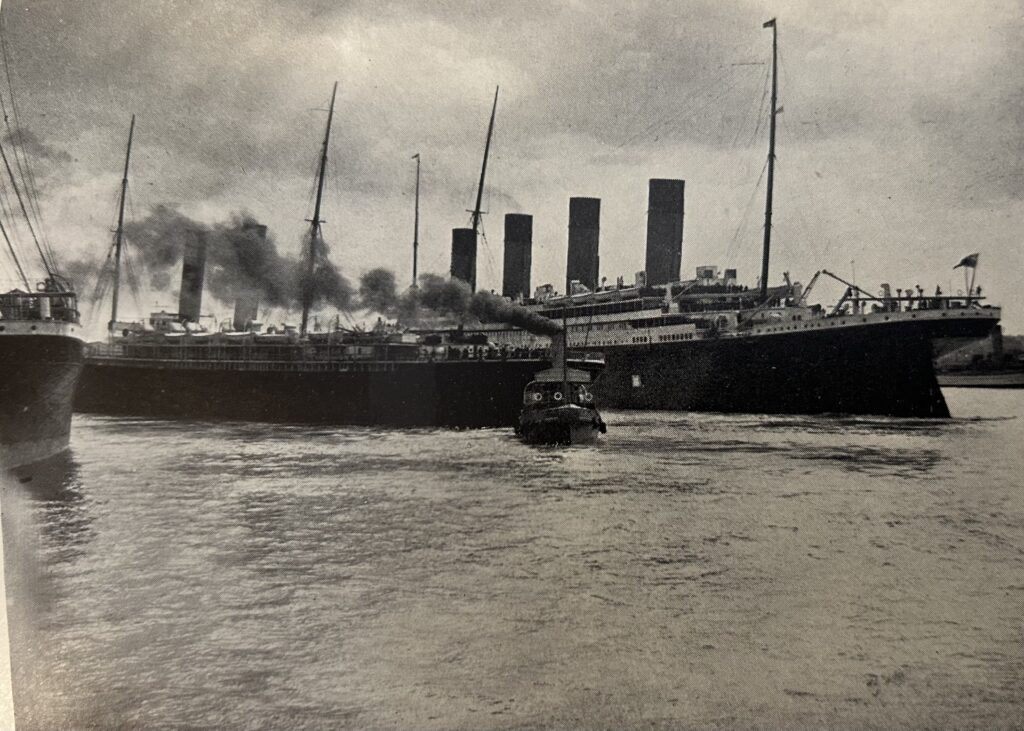
THE TITANIC NARROWLY ESCAPES COLLISION AT SOUTHAMPTON
A full-scale replica of the Titanic, named “Titanic II,” has been under construction. It is being built by the company Blue Star Line in China and is intended to be a close replica of the original ship. The Titanic II is designed to have enough lifeboats for all passengers and crew, in compliance with modern safety regulations. The ship is expected to provide a unique experience for passengers while incorporating modern safety features to ensure a safe voyage5.
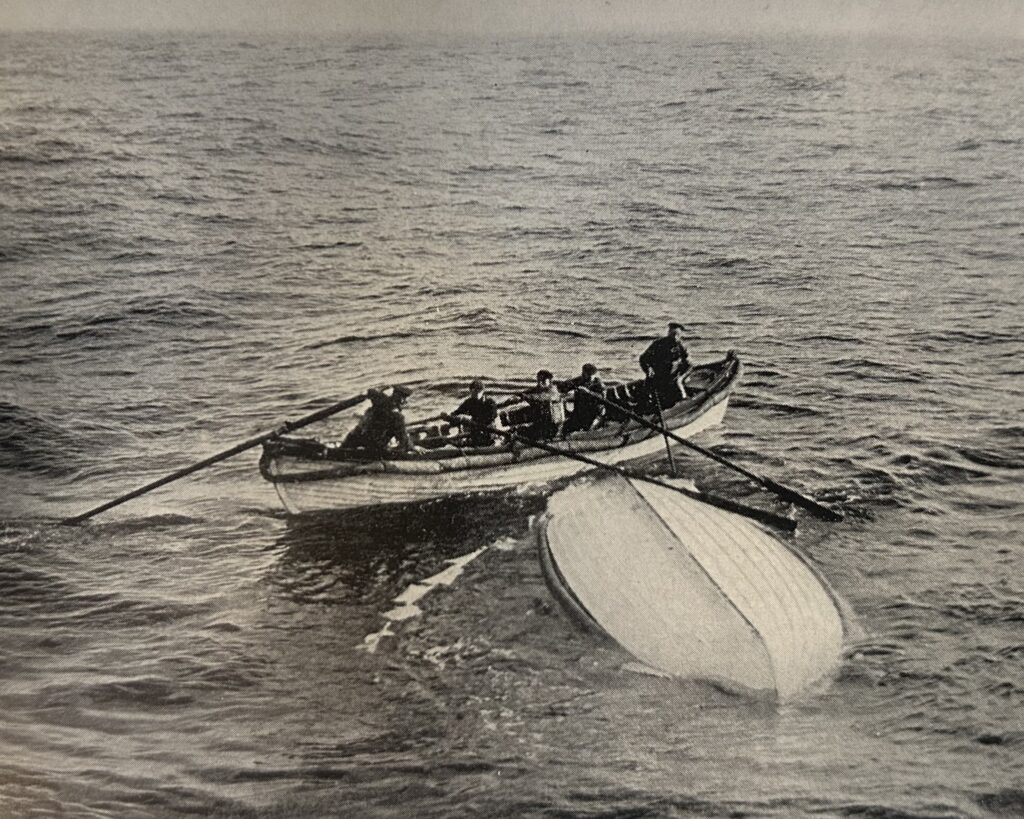
The Titanic wreckage remains located about 350 miles off the coast of Newfoundland, Canada, at a depth of roughly 12,500 to 13,000 feet below the ocean’s surface. The ship fell to the seabed in two parts, and the observed damage can offer clues about its condition. The site has been explored and studied by various expeditions, and the wreckage has been visited multiple times over the years.
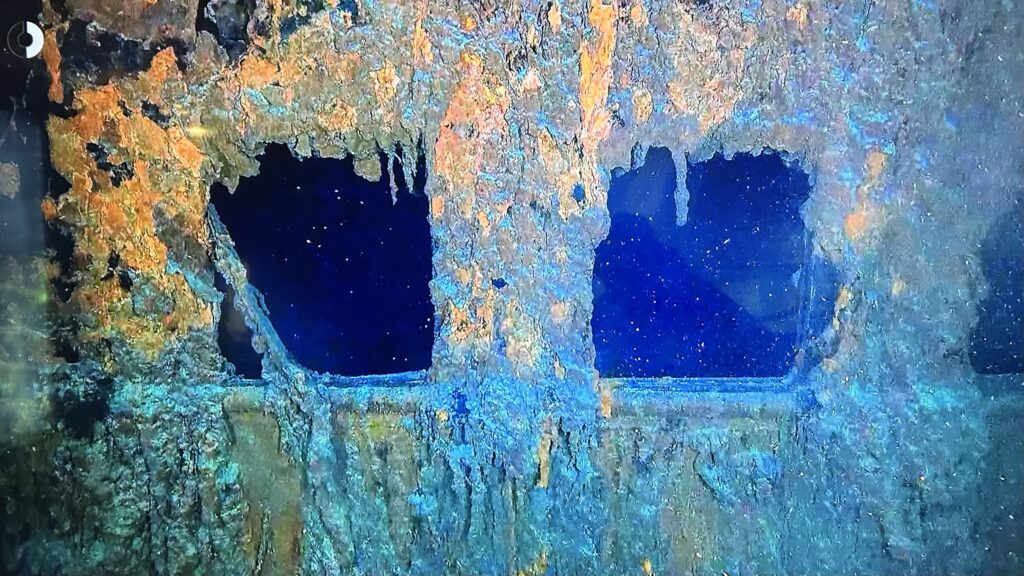
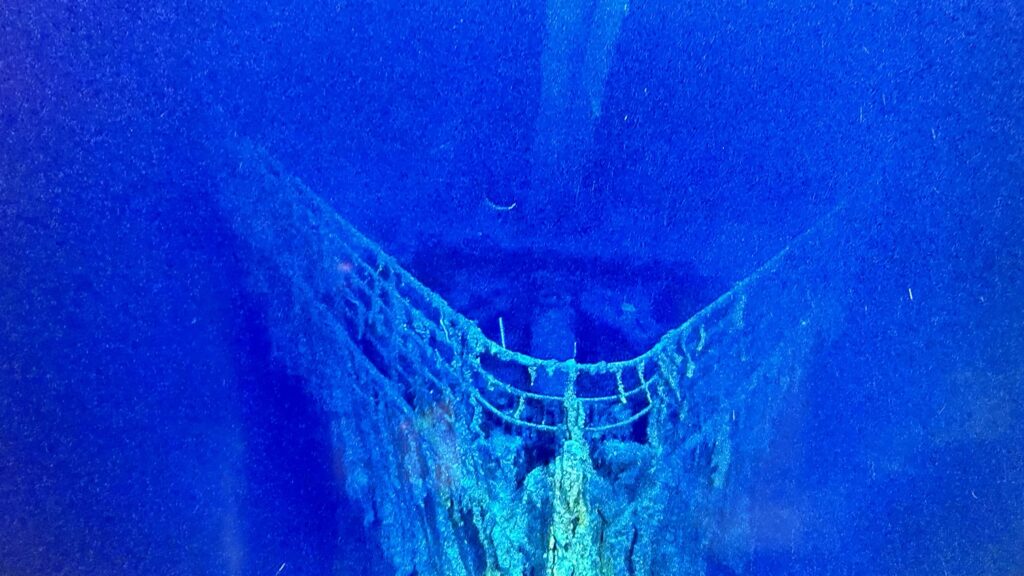
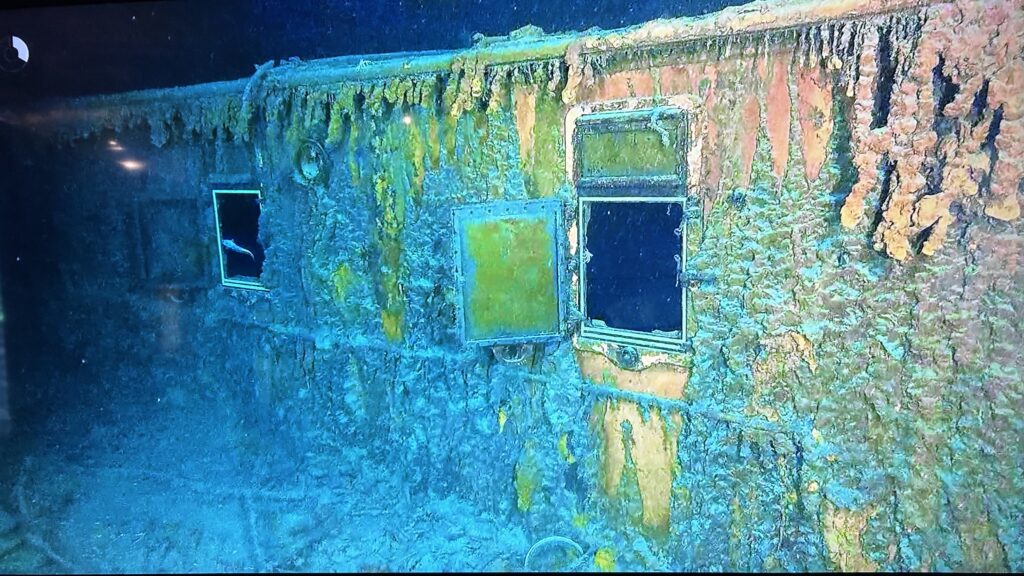
The Titanic’s resting place has become a UNESCO cultural heritage site, and efforts have been made to track and memorialize its location. The wreckage is gradually deteriorating, and its condition is expected to worsen over time. The site has been the focus of preservation and mapping projects to document and study the ship’s elemental form as it continues to deteriorate. The Titanic’s location and the ongoing interest in its preservation have contributed to its enduring significance more than a century after it sank.
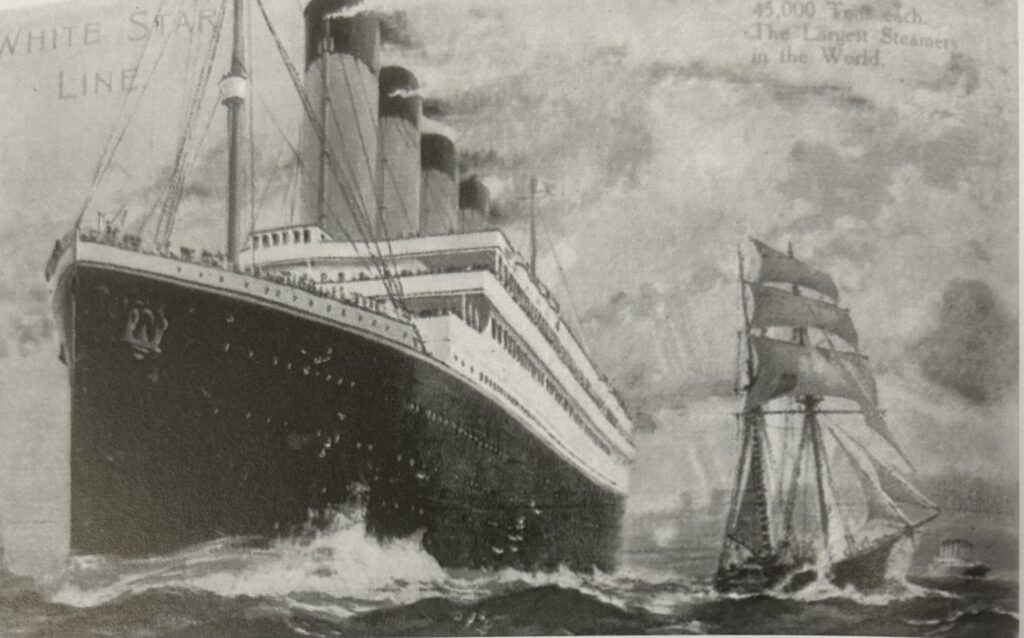
The Titanic museums around the world offer unique features and exhibits that provide visitors with an in-depth look at the history and legacy of the iconic ship. Here are some of the unique features of each Titanic museum:
- Titanic Branson – Located in Branson, Missouri, USA. This museum offers authentic Titanic artifacts and unique stories of survivors of the wreck. It covers a broad scope of the ship’s history, including its construction, passengers, and the tragic sinking.
- SeaCity Museum – Located in Southampton, UK. The museum’s Titanic exhibition is home to one of the most poignant pieces of Titanic history. It offers an immersive experience where visitors can walk the decks, experience the ship’s opulent interior, and discover a full-sized replica of one of the lifeboats.
- Titanic: The Artifact Exhibition – Located in Las Vegas, Nevada, USA. This exhibition features a wide range of artifacts recovered from the Titanic wreckage, including a deck chair. Visitors are given an identity of one of the 2,344 passengers on board and only discover at the end if they make it off the ship safely.
- Maritime Museum of the Atlantic – Located in Nova Scotia, Canada. The museum offers a unique, in-depth perspective on the Titanic’s history and features extensive Titanic exhibitions.
- Titanic Belfast – Located in Belfast, Northern Ireland. This museum is recognized as the premier Titanic museum in the world and is situated at the very site where the iconic RMS Titanic was built and launched. It offers nine interactive galleries that explore everything from Belfast’s shipbuilding industry to the ship’s tragic end.
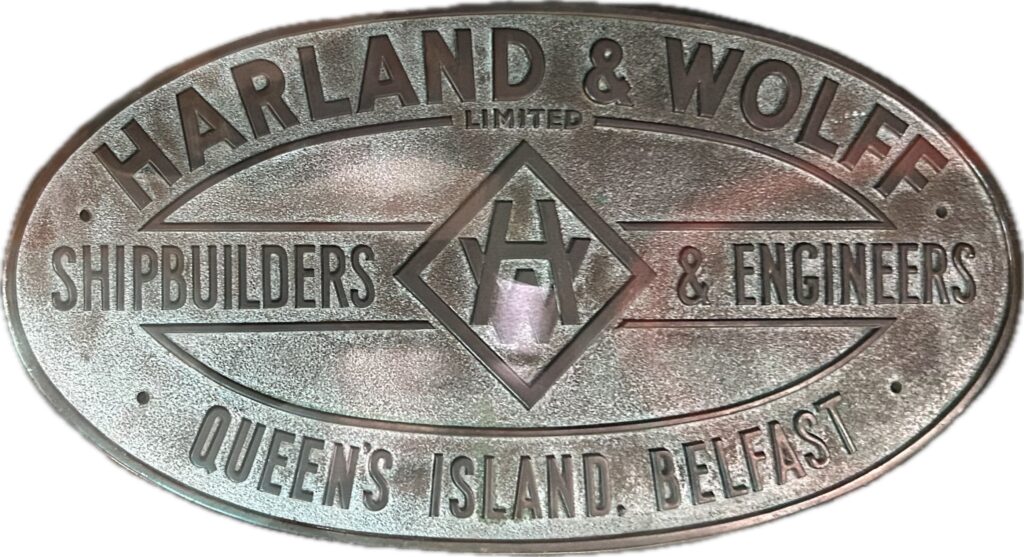

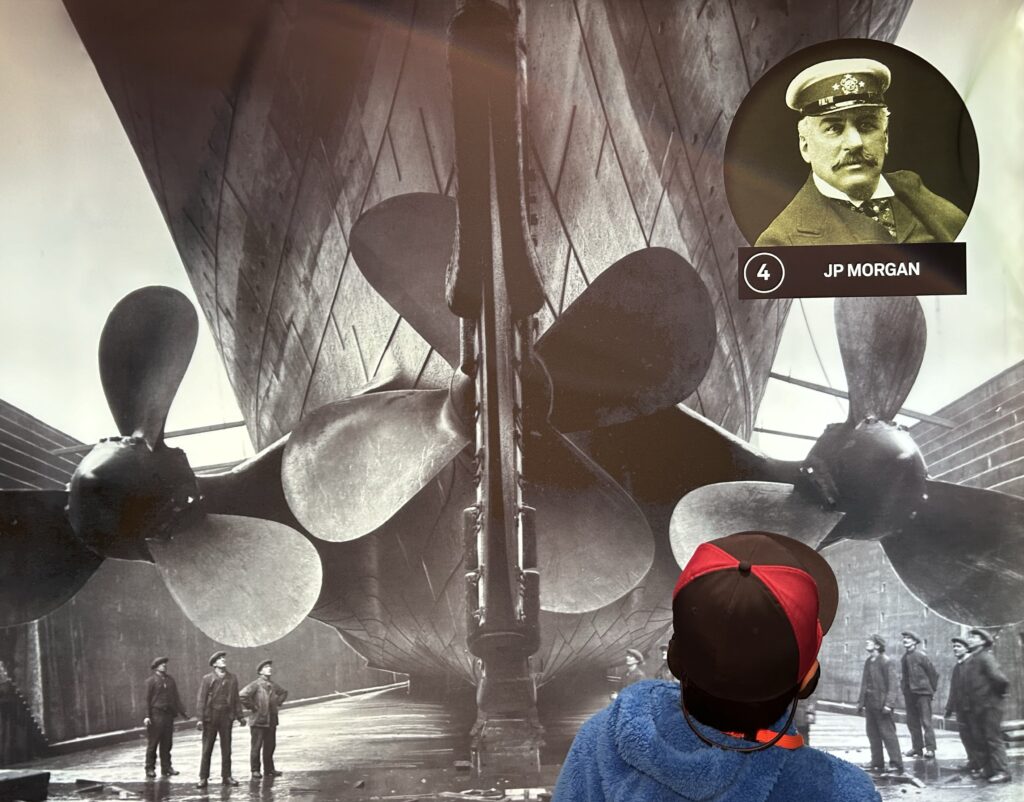
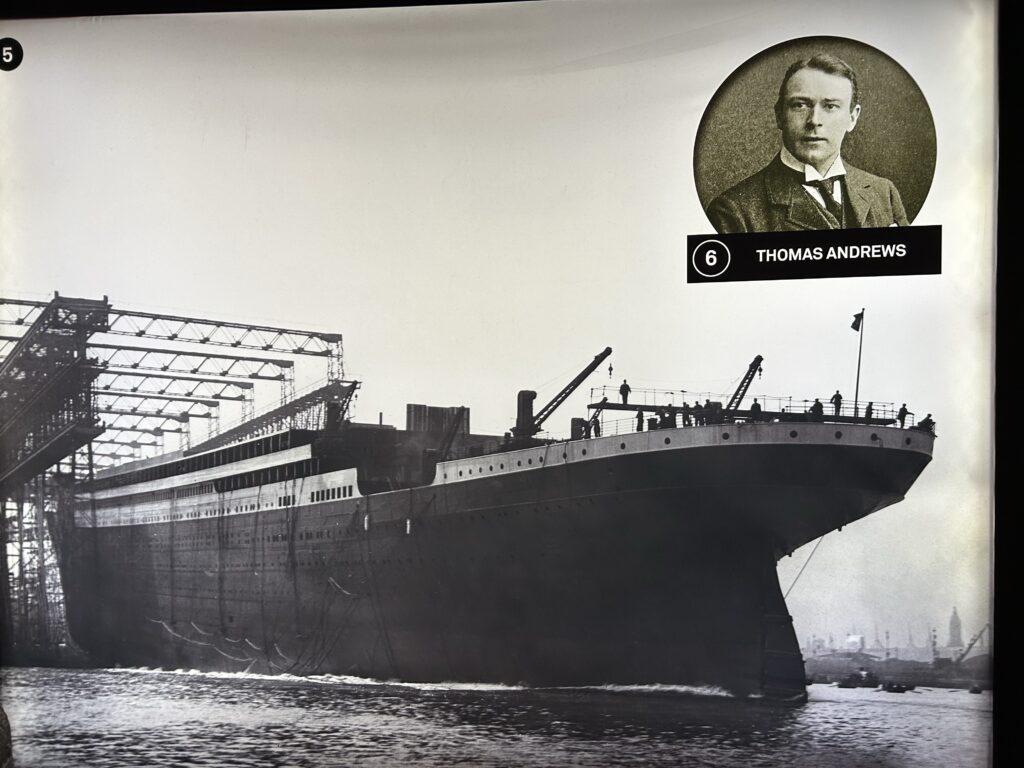
These museums provide a range of experiences, from authentic artifacts and stories of survivors to immersive recreations of the ship’s interior, making them popular destinations for those interested in the history of the Titanic.
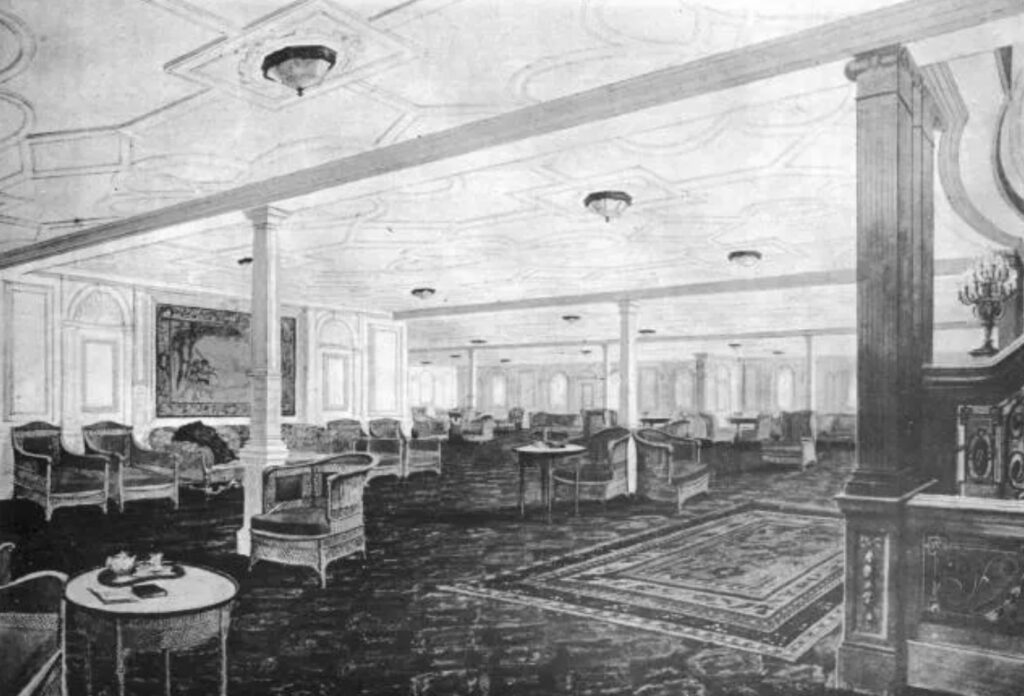
Yacht Clubs model Titanic Opulance
When passengers booked passage on the Titanic, they looked forward to a variety of experiences, including culinary excellences. The Titanic was considered the epitome of luxury and opulence, and this was reflected in its dining options and food offerings6.

First-class passengers were treated to a lavish dining experience. The menu was extensive and included the latest French cuisine. The ship also had a la carte restaurants and a café open to all classes of passengers, offering a variety of dishes including sandwiches, pastries, and tea62. The ship’s chefs were experienced and well-trained, and the food was prepared using fresh ingredients6.

In addition to the regular dining options, first-class passengers could dine in Titanic’s Restaurant for an extra charge. This exclusive dining service and cuisine were on par with the finest European hotels like the Ritz or Hotel Cecil3.

As new money rose to prominence — the white collar working class — so did the concept of the restaurant. Old money was often welcome in these establishments, but families from new money had to book months in advance.
According to the RMS Titanic Hotel, before the turn of the 20th century, it was considered uncouth for rich families to eat in public.
Second-class passengers also had a good dining experience, with menu selections that rivalled most regional hotels2.
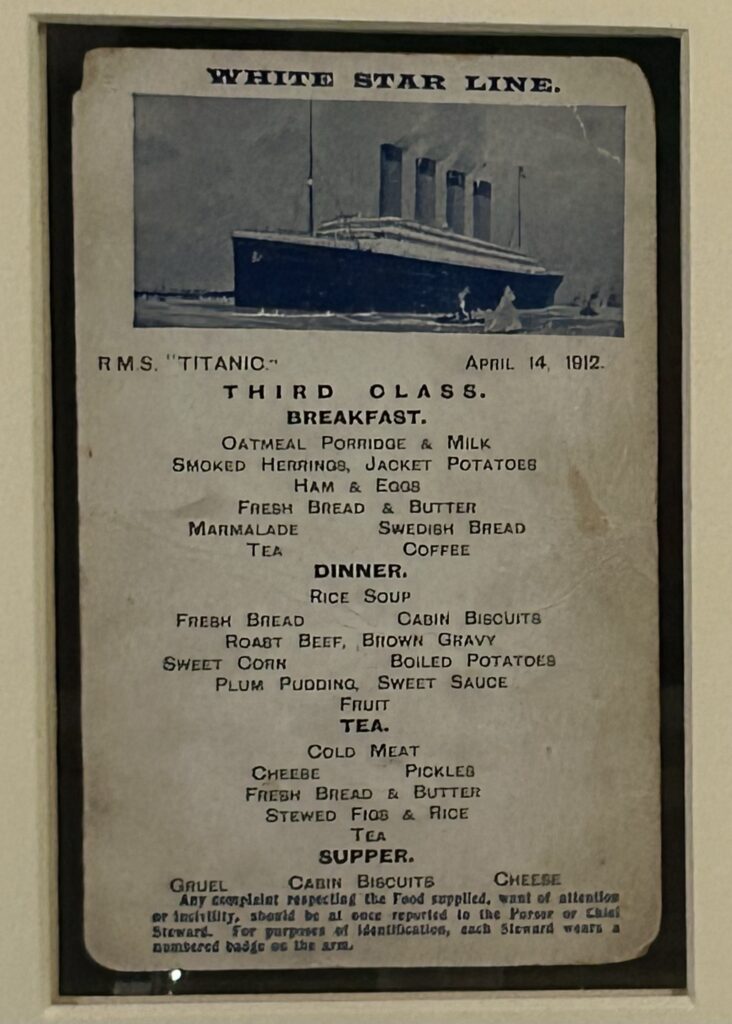
Even third-class passengers, who had a more basic and less varied menu, enjoyed better accommodations and food than had been offered by other ships at the time16.
It is important to note that all passengers on the Titanic were well to do. Less expensive means to travel across the Atlantic could be obtained.
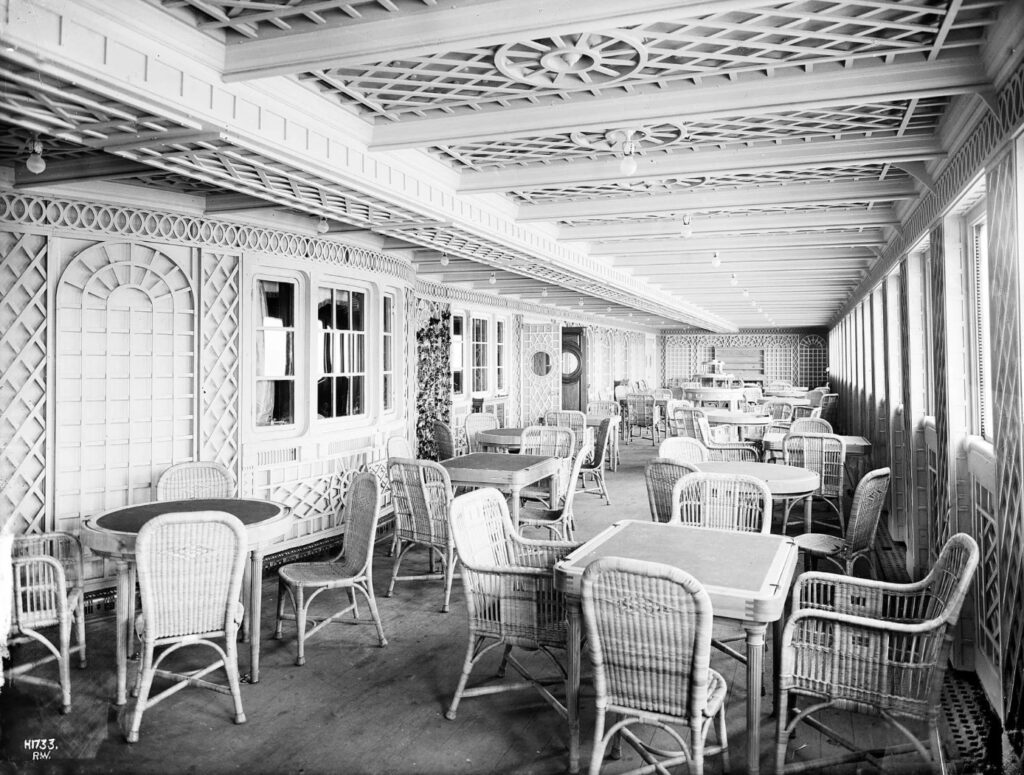
Remember Miss Brown (Kathy Bates) in James Cameron’s 1997 blockbuster hit? Being of new money, she would have needed to book months in advance to eat at First Class Dining.
There are a few restaurants in the USA that offer a Titanic-themed dining experience. One such restaurant is Cafe Jack, located in Southern California, which provides a unique Titanic-themed dining experience2. Another example is the Rayanne House in Belfast, which offers a recreation of the last menu rserved in the first-class restaurant on board the Titanic, providing a unique dining experience in a period dining room4. There are occasional special events or dinners hosted by Titanic groups or societies including yacht clubs in the USA that feature recreated Titanic menus, offering diners a chance to experience a taste of the luxury and opulence that defined dining on the historic ship1.
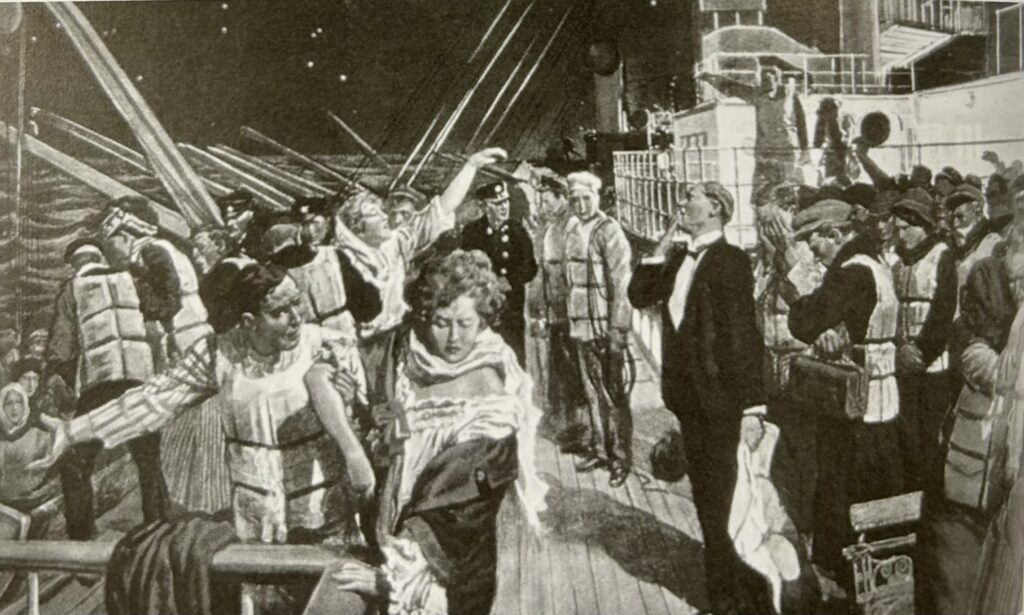
The first yacht clubs like the Royal Cork and the Royal Thames started out as dining clubs and the more prestigious clubs like those two, The York Yacht Club, the San Diego Yacht Club, The Saint Francis Yacht Club and the Seattle Yacht Club continue the fine dining tradition.
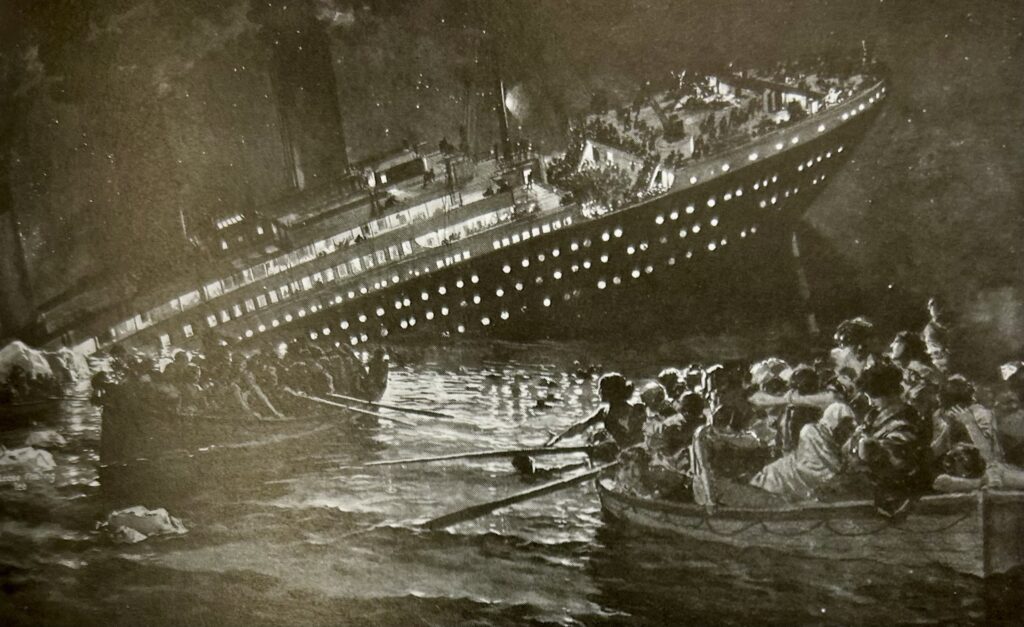
It is relatively common for yacht clubs to host Titanic-themed events, particularly around Halloween. These events often take the form of Titanic Masquerade parties and cruises, where attendees dress in period costumes and enjoy a night of entertainment and dining on board a yacht. Such events have been held in various locations, including San Diego, Seattle and Los Angeles, and they typically feature music, dancing, and other themed activities. While these events are not exclusive to yacht clubs, they do reflect a broader trend of Titanic-themed entertainment on the water.
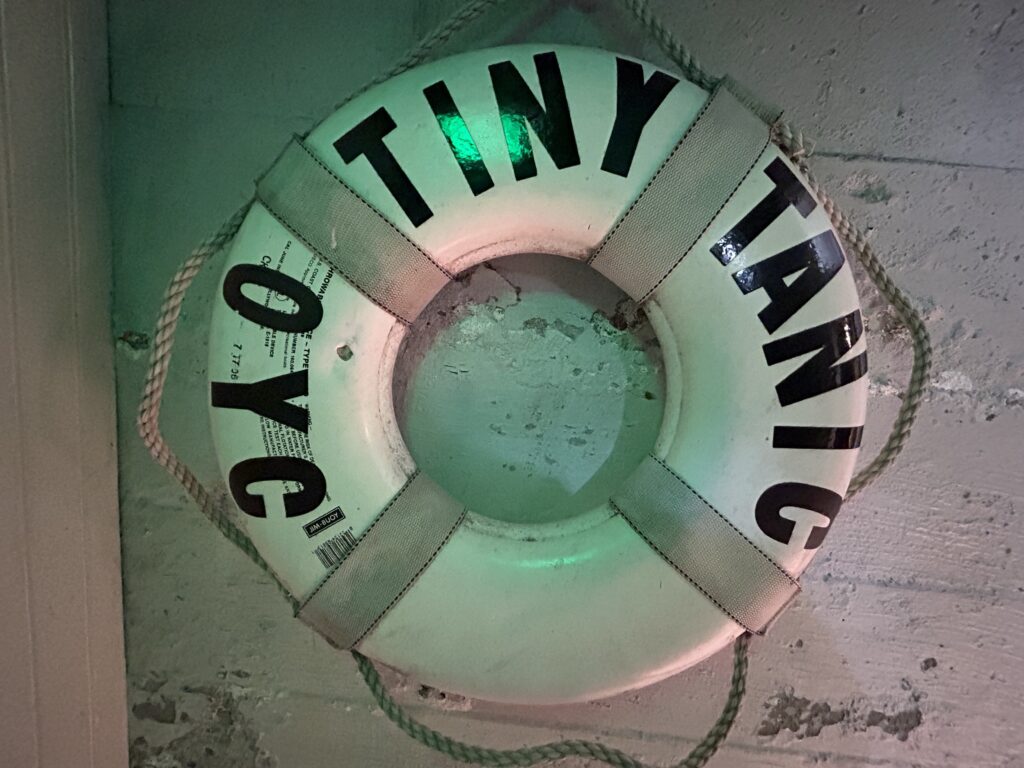
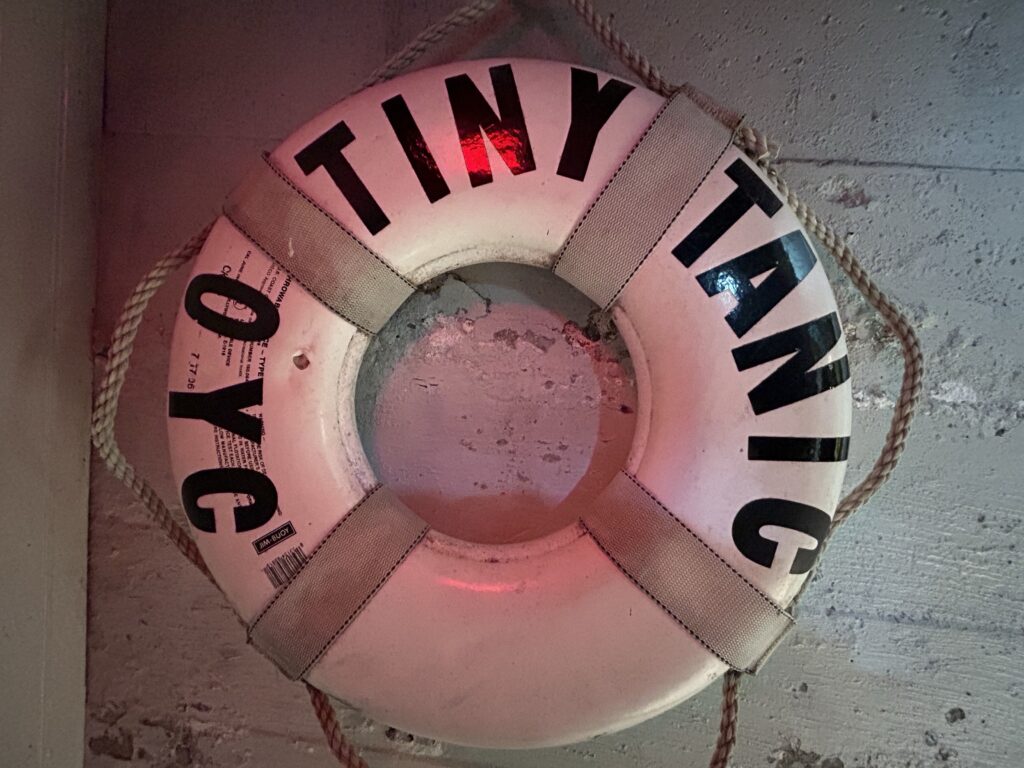
First-class passengers on the Titanic enjoyed a truly luxurious dining experience. The first-class menu was extensive and included multiple courses, reflecting the opulence and grandeur associated with first-class travel at the time. Some of the dishes served to first-class passengers included:
- Hors D’Oeuvres
- Oysters
- Consommé Olga
- Cream of Barley
- Poached Salmon with Mousseline Sauce
- Filet Mignons Lili
- Sauté of Chicken, Lyonnaise
- Vegetable Marrow Farci
- Lamb with Mint Sauce
- Roast Duckling with Apple Sauce
- Sirloin of Beef
- Chateau Potatoes
- Green Pea
- Creamed Carrots
- Boiled Rice Parmentier
- Boiled New Potatoes
- Punch Romaine
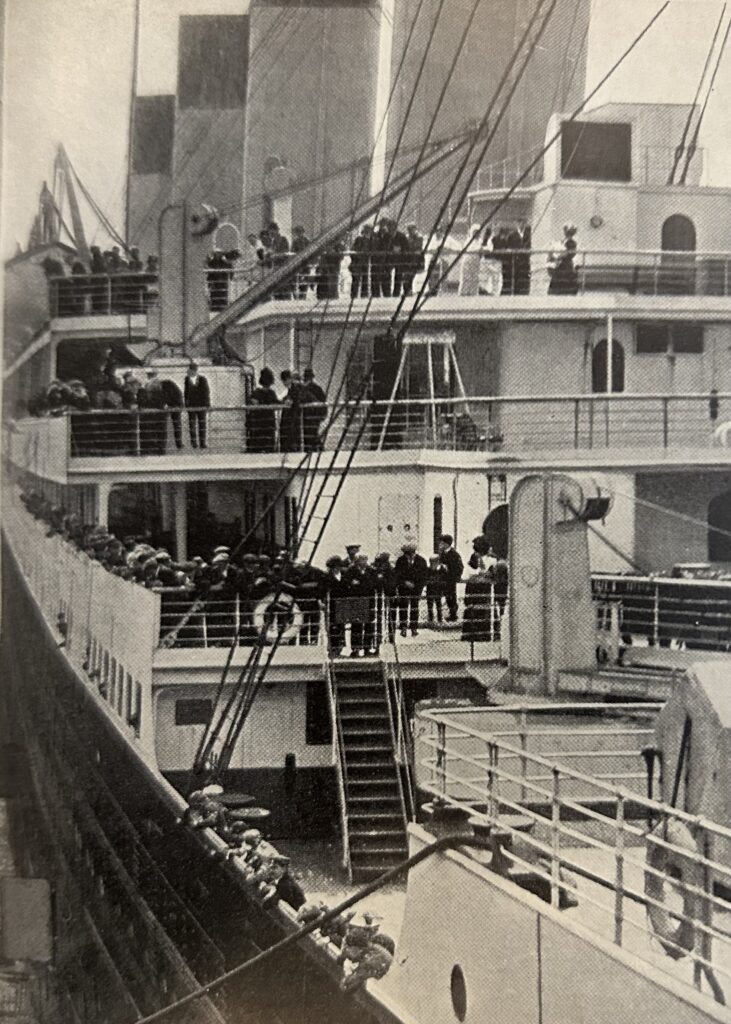
The first-class dining experience was a true reflection of luxury, with an emphasis on the finest and most indulgent culinary offerings123.
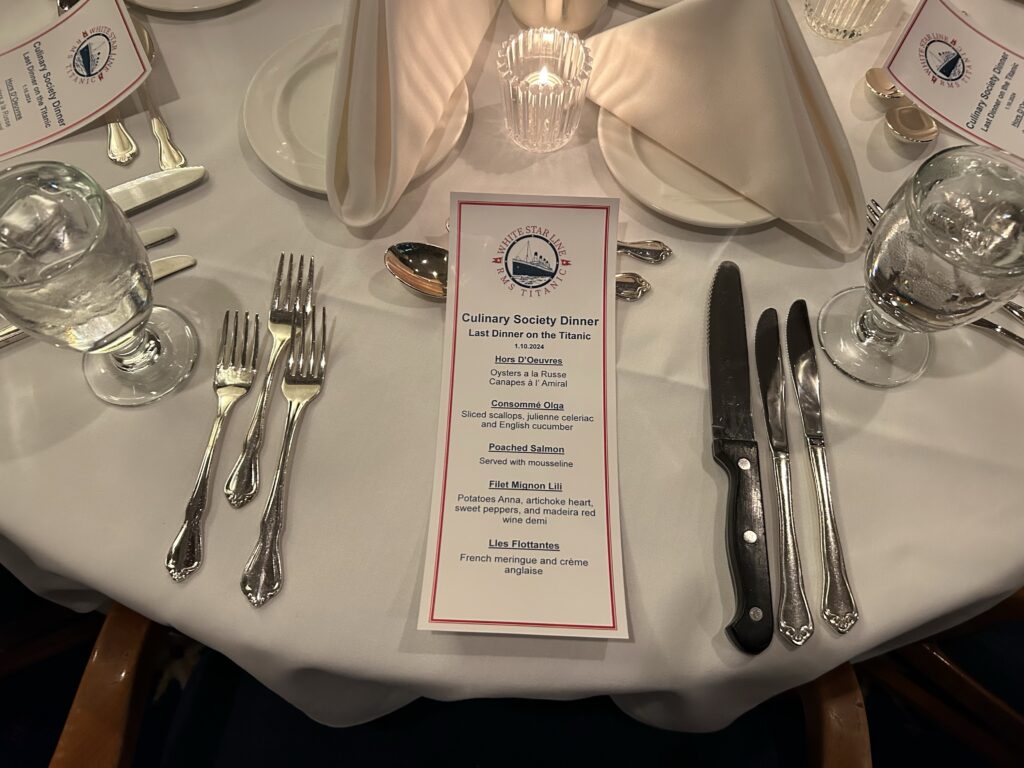



The following are some of the more well-known passengers in first class:
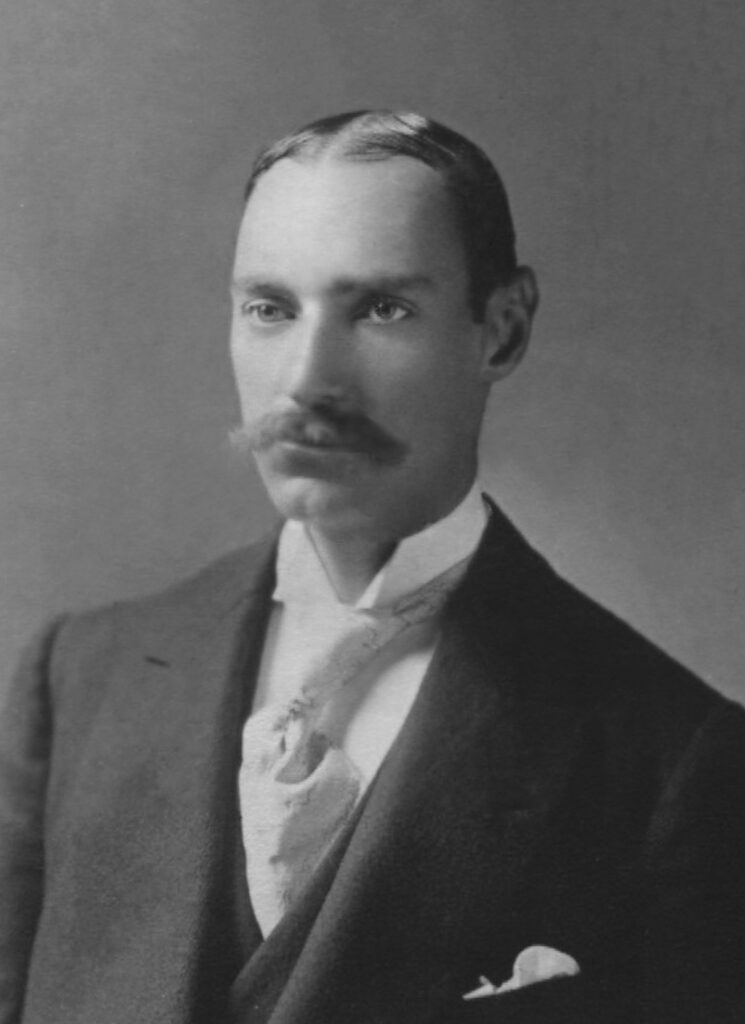
The richest passenger aboard was multi-millionaire John Jacob Astor. He was travelling with his second wife, Madeleine, who was five months pregnant. JJ Astor did not survive but his wife did.
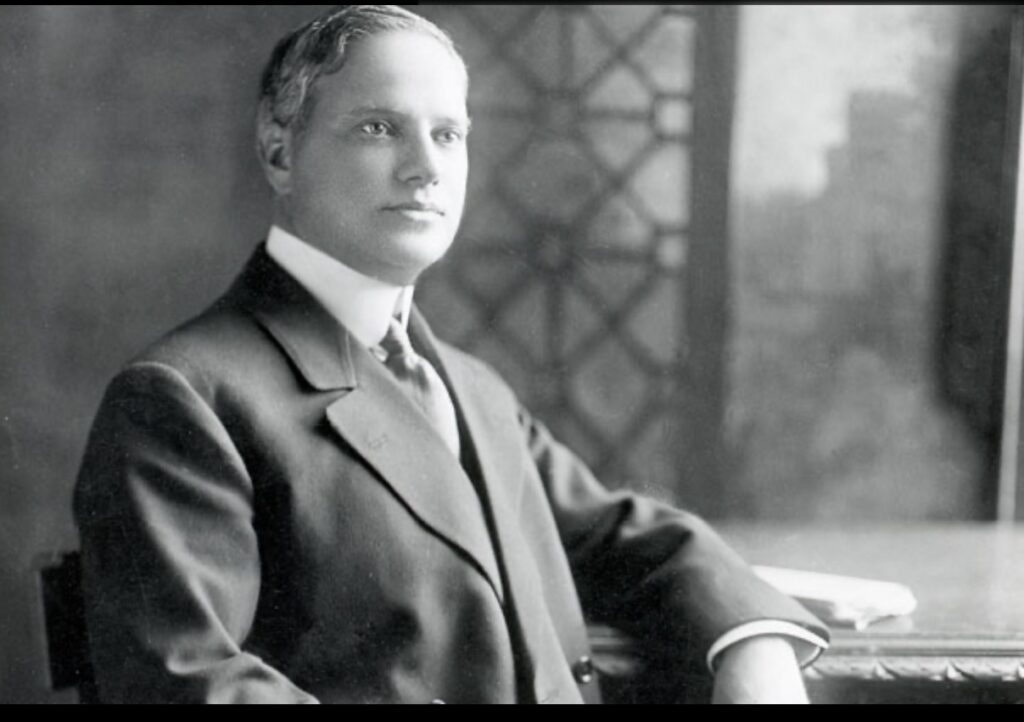
Millionaire Benjamin Guggenheim was travelling on the Titanic with a lady friend. His wife and family were at home in New York. Guggenheim and his manservant helped women and children into lifeboats. When all the boats had gone they changed into their best clothes and prepared to “Die like gentlemen.”

Sir Cosmo and Lady Duff Gordon
Lady Duff Gordon was a notable dress designer whose clientele included Isadora Duncan, Oscar Wilde and the British royal family. The Duff Gordons both survived but were called to testify at the court of inquiry and explain why their boat contained only twelve people. During the inquiry they were accused and cleared of bribing crew members not to allow more people into the boat. The press referred to their boat (#1) as money boat.
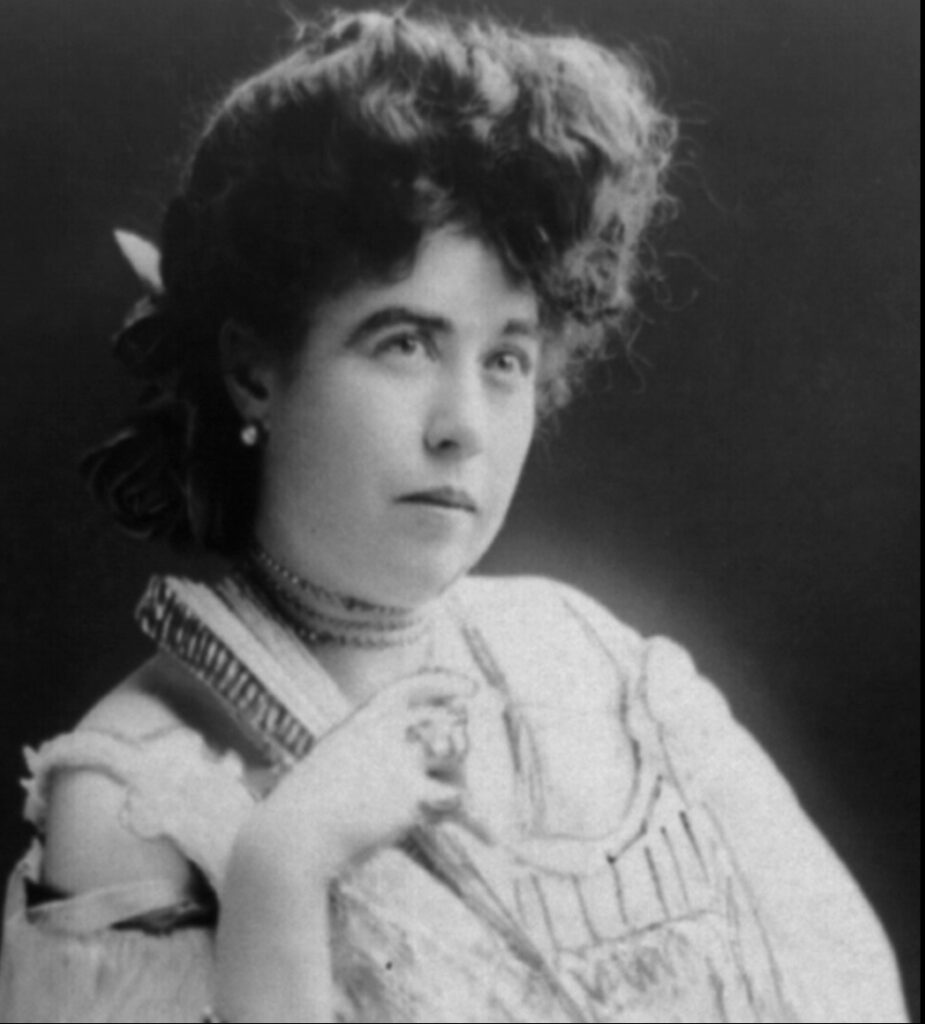
The ‘Unsinkable’ Molly Brown
Molly was the daughter of a poor Irish immigrant family whose husband struck rich when mining for silver. She was travelling home to America aboard the Titanic. She survived the disaster in lifeboat number 6 and earned her nickname because she took control of the boat, kept the women rowing for seven hours and gave her furs to keep others warm.
Molly Brown’s background played a significant role in her fame and influence after the Titanic disaster. Born Margaret Tobin in 1867 to Irish immigrant parents in Hannibal, Missouri, she grew up in a modest, working-class environment. Her early life was marked by hard work; she started working in a factory at the age of 13. In 1886, she moved to Leadville, Colorado, where she worked in a department store and met her future husband, James Joseph “J.J.” Brown, a mining engineer.
The couple’s fortunes changed dramatically when J.J. discovered a substantial ore seam at the Little Jonny Mine, leading to significant wealth. This newfound prosperity allowed Molly to become involved in social and philanthropic activities. She helped establish soup kitchens for miners’ families and became active in the women’s suffrage movement, co-founding a branch of the Alliance Française in Denver and working to improve conditions for women and children.
Molly’s experience and character were crucial during the Titanic disaster. Known for her courage and leadership, she helped command a lifeboat and urged the crew to return to the debris field to search for survivors. Her actions during the sinking earned her the nickname “The Unsinkable Molly Brown,” a moniker that became widely known posthumously.

Margaret “Molly” Brown, famously known as the “Unsinkable Molly Brown,” boarded the Titanic on April 10, 1912, at Cherbourg, France. She was returning to the United States after receiving news that her grandson was ill.
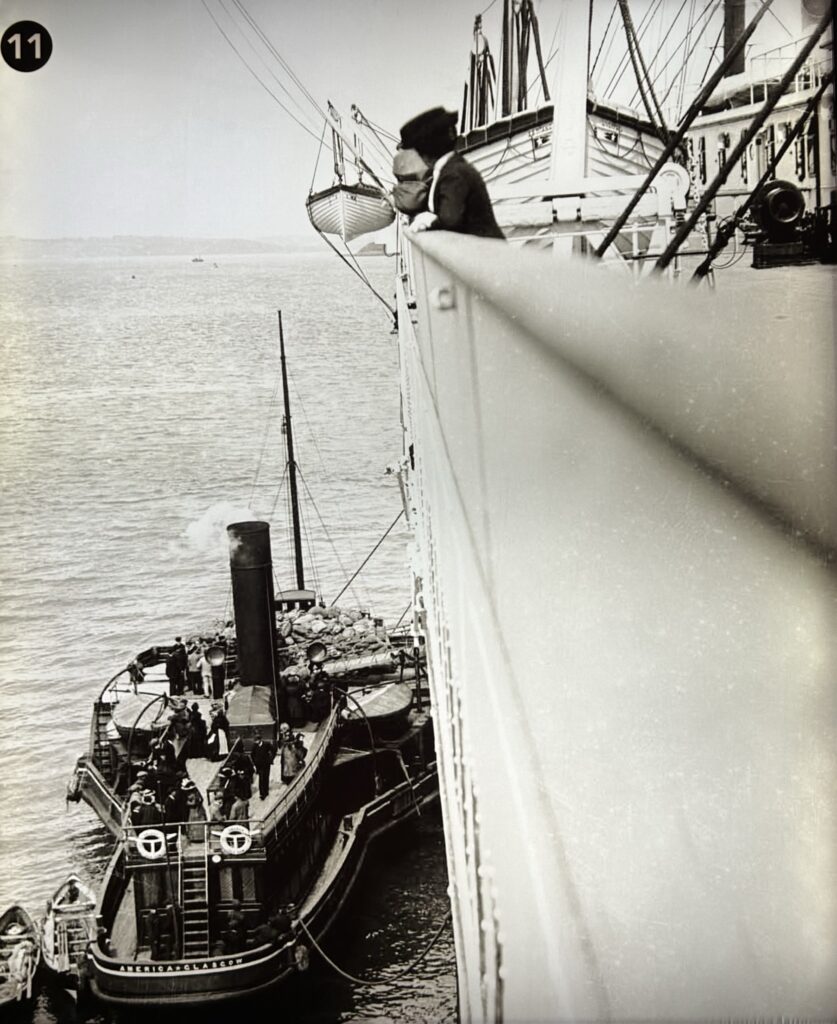
After surviving the Titanic disaster, Molly Brown became well-known for her efforts to assist fellow survivors. She was instrumental in organizing the Titanic Survivors’ Committee and played a significant role in raising funds for those who had lost everything in the sinking. On May 29, 1912, she and the committee honored Captain Arthur Rostron and the crew of the RMS Carpathia, the ship that rescued many Titanic survivors, by presenting them with a silver loving cup and medals.
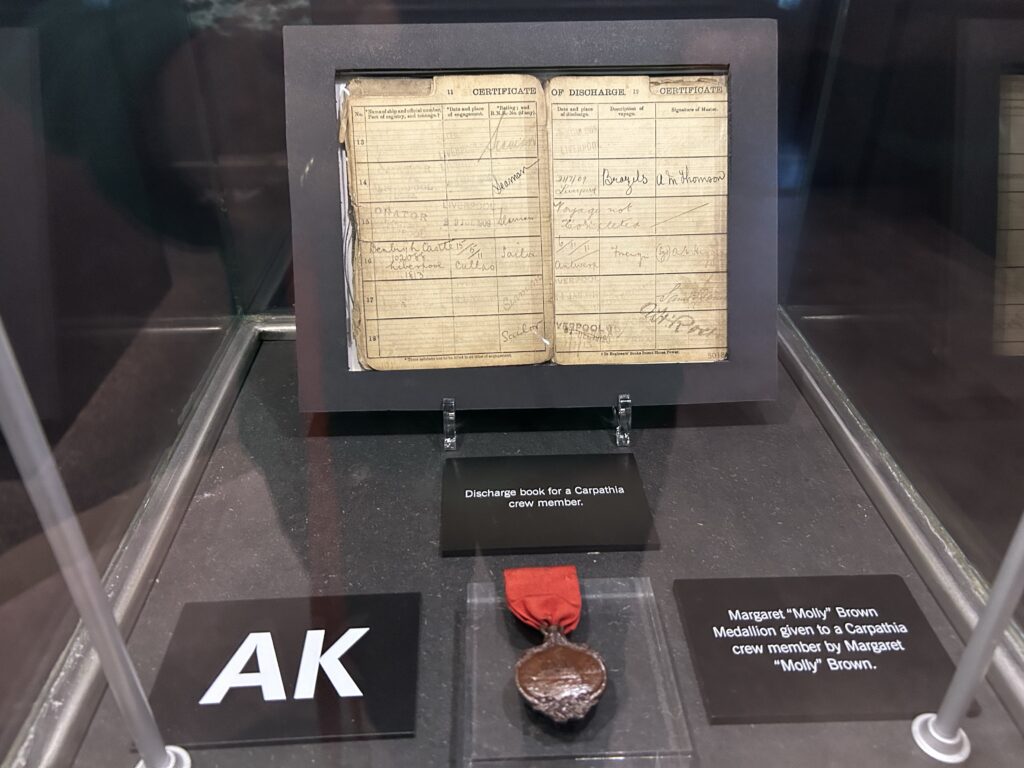
Molly Brown’s legacy extends beyond the Titanic disaster. She was a dedicated philanthropist and activist, involved in various social causes, including women’s rights and miners’ rights.
After the Titanic, Molly used her activism to enter into politics, where she made an unsuccessful bid for the U.S. Senate before World War I. During the war, she ran a relief station in France and was awarded the French Legion of Honor for her efforts.
Molly Brown’s background of resilience, philanthropy, and activism not only contributed to her fame but also enabled her to leverage it for significant social impact, making her a celebrated figure in American history.
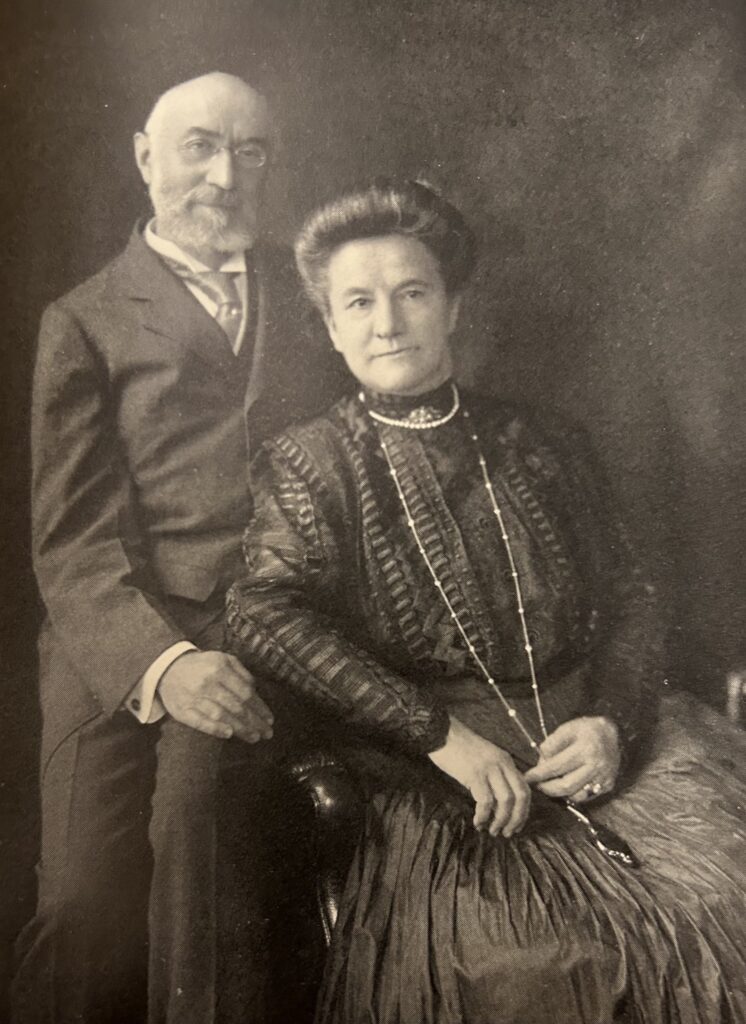
Isador and Ida Straus
Isador Straus was a partner of Macey’s department store, New York. He and his wife were returning from a European holiday. Both died on the Titanic. Ida nearly got into lifeboat number 8 but refused saying to her husband “We have been living together for many years. Where you go, I go.”
Isidor Straus, co-owner of Macy’s department store and a former U.S. Congressman, and his wife Ida were among the wealthiest and most distinguished first-class passengers aboard the RMS Titanic in 1912.
Following the disaster, the Straus family received life insurance payouts—part of a broader $4 million in claims U.S. insurers paid out for Titanic victims—but these sums were modest compared to the family’s overall vast fortune derived from their business empire.
Fast forward to the 21st century, the Straus legacy unexpectedly tied to Seattle through his descendant by marriage, Wendy Rush, wife of Stockton Rush. Stockton Rush was the CEO and co-founder of OceanGate, the company that built the Titan submersible. Titan was designed to visit Titanic’s wreck site but tragically imploded in 2023, killing all five aboard. For more on Titan, see below.
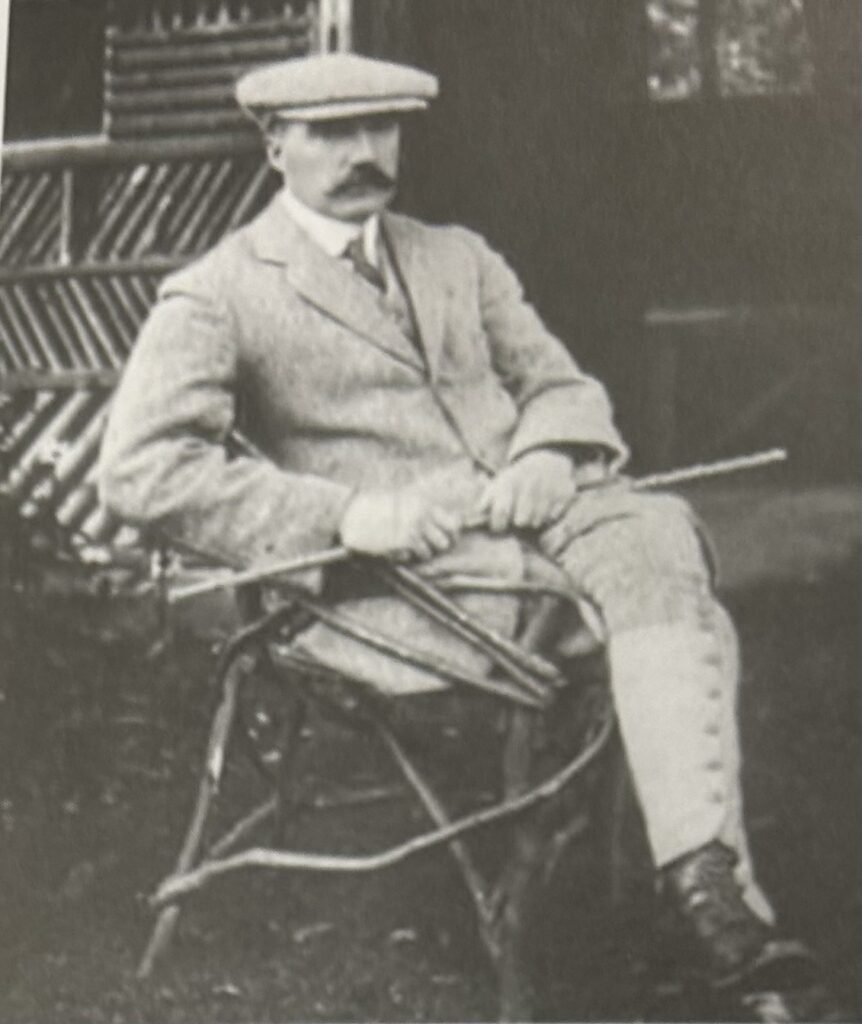
First Class survivor Algernon Barkworth stepped into the water as Titanic took her final plunge. After some time in the water he reached the overturned Collapsible B and managed to pull himself on board despite concerns about the boat being swamped.

Perhaps one of the most colourful of Titanic’s survivors was Thomas Whitely. Having served as a saloon steward, Whitely would go on to serve in the RFC during the First World War and as an actor in Hollywood and elsewhere, appearing in the 1930 film adaptation of R.C. Sherriff’s play, Journey’s End. He died in 1943, while en route to Italy while serving with the RAF.
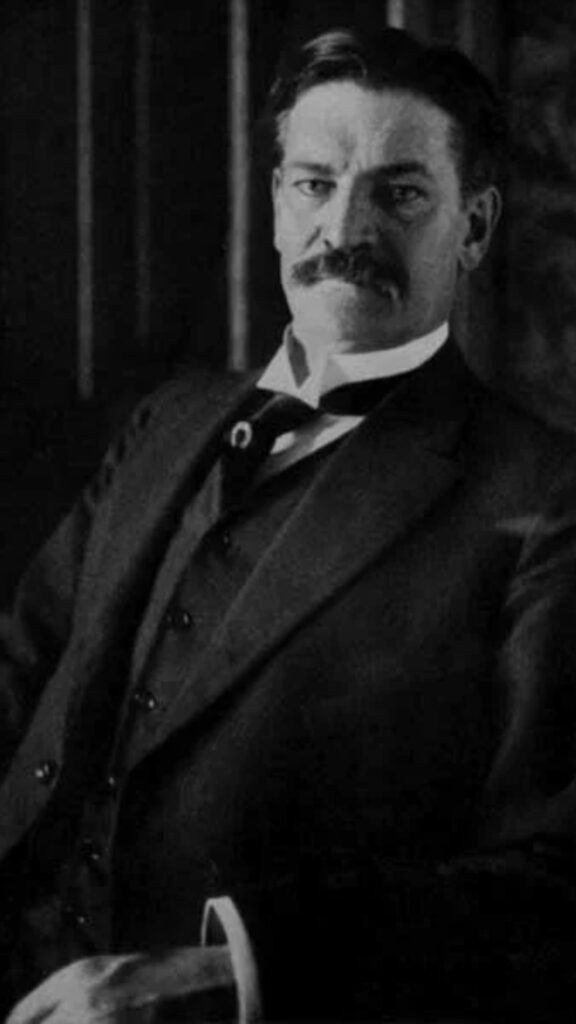
Colonel Archibald Gracie IV was a prominent American author, historian, and society figure, known for his detailed firsthand account of the Titanic disaster. He was a first-class passenger. Gracie’s father was a Confederate officer during the Civil War, and his great-grandfather built Gracie Mansion, now the official residence of New York City’s mayor.
Archibald Gracie survived the sinking of the Titanic. As the ship went down, Gracie was on the upper deck, holding onto a railing. He was “swirled” beneath the surface but managed to find and climb onto an overturned collapsible lifeboat (a canvas-and-cork raft), where he spent hours in the freezing North Atlantic waters. He and other survivors on the raft were eventually rescued by the R.M.S. Carpathia. Gracie later described that more than half the men who initially reached the overturned lifeboat died from exhaustion or cold.
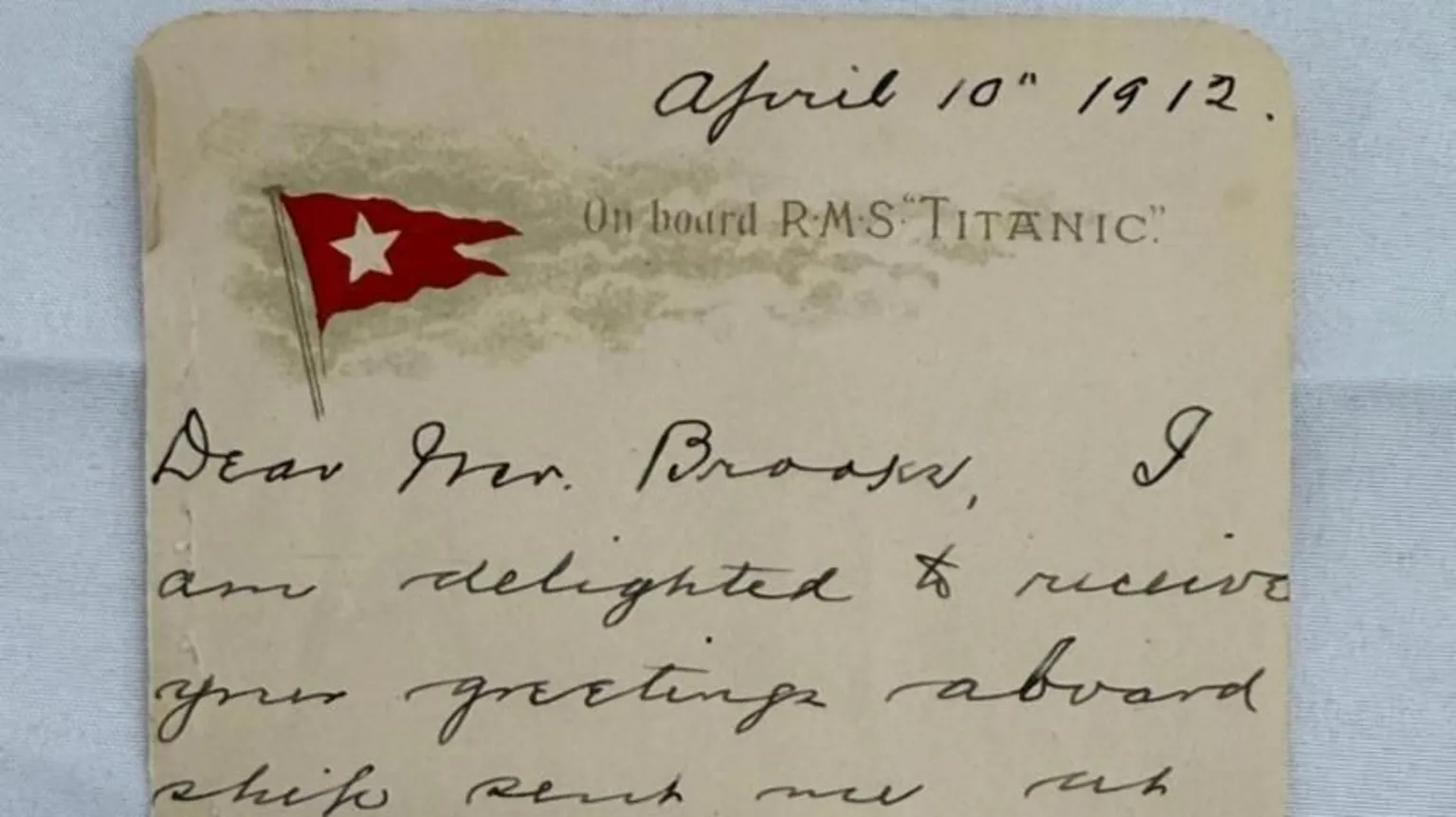
Gracie’s letter, dated April 10, 1912, was written on Titanic stationery the day he boarded in Southampton. In it, he famously wrote, “It is a fine ship but I shall await my journey’s end before I pass judgment on her.” The letter was mailed when Titanic stopped in Queenstown (now Cork), Ireland, on April 11, and postmarked in London on April 12-days before the ship struck the iceberg. This timing meant the letter was safely delivered to its recipient, the seller’s great-uncle, who was an acquaintance of Gracie, at the Waldorf Hotel in London.
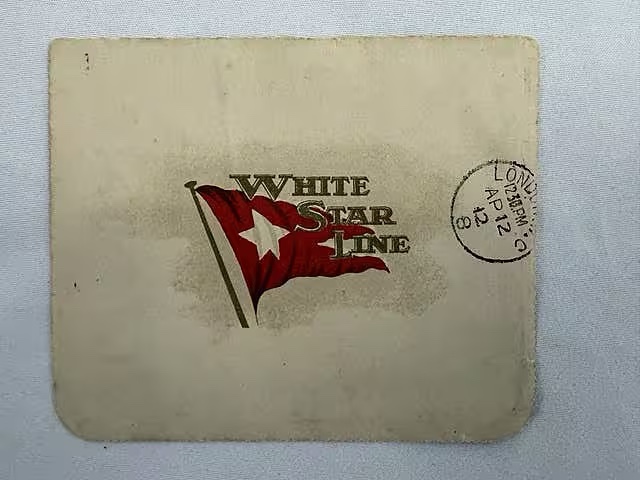
The letter was described as “museum grade” and “prophetic,” given Gracie’s cautious optimism just days before the disaster. Its rarity-being the only known letter from Gracie written aboard the Titanic-and its direct connection to a prominent survivor contributed to its extraordinary value. At auction in April 2025, it sold for a record-breaking £300,000 (about $400,000), five times its estimated price, to a private collector from the United States.
After his rescue, Gracie wrote one of the most recognized and detailed accounts of the disaster in his book, The Truth About The Titanic, published posthumously in 1913. He recounted the chaos, the struggle for survival, and the harrowing hours spent adrift. Gracie’s last reported words, reflecting his actions during the sinking, were: “We must get them into the boats. We must get them all into the boats”. His narrative remains a key historical source on the tragedy.

Kate Phillips’ is said to have inspired elements of the fictional love story depicted in James Cameron’s 1997 film Titanic. The film’s narrative, featuring a love affair and a significant necklace, mirrors aspects of Kate’s real-life story.
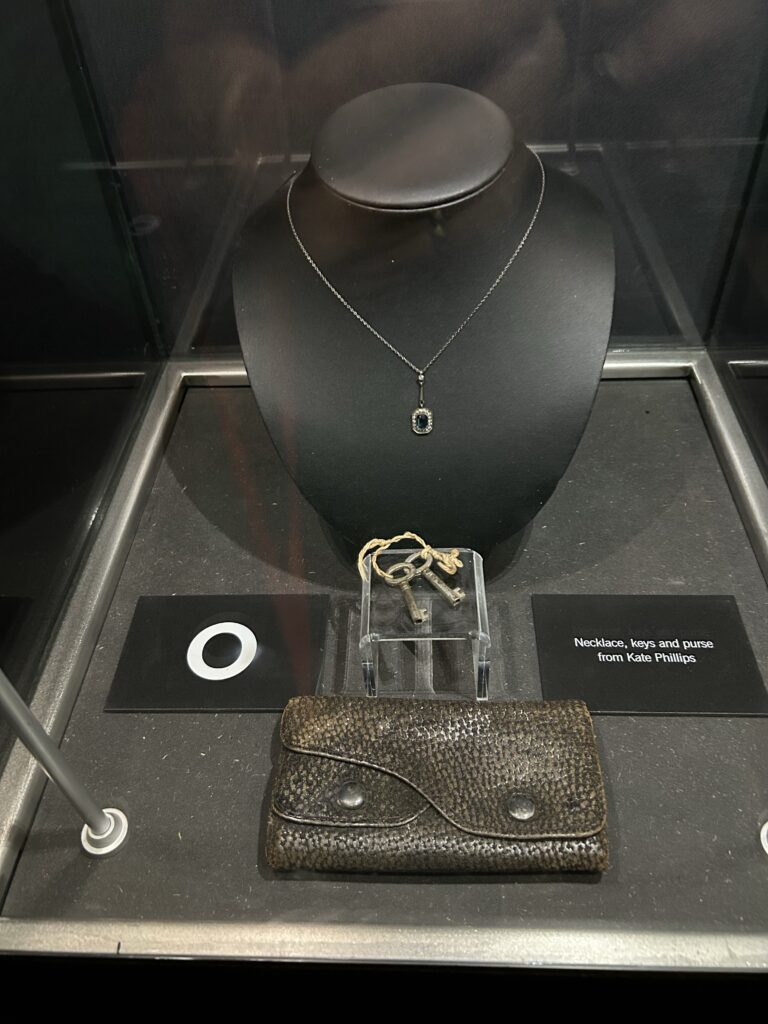
Kate Florence Phillips, a 19-year-old Englishwoman, is known for her poignant story connected to the Titanic disaster. She was involved in a romantic affair with Henry Samuel Morley, a confectionery shop owner from Birmingham who was 20 years her senior. Morley, who was married and had a daughter, decided to elope with Kate to start a new life in America. They boarded the Titanic under the assumed names of Mr. and Mrs. Marshall as second-class passengers.
During the tragic sinking of the Titanic on April 15, 1912, Henry Morley perished, while Kate survived after being placed in a lifeboat, reportedly Lifeboat 11. Before the disaster, Henry had given Kate a sapphire necklace, known as the “Love of the Sea,” which she managed to keep with her during the ordeal.
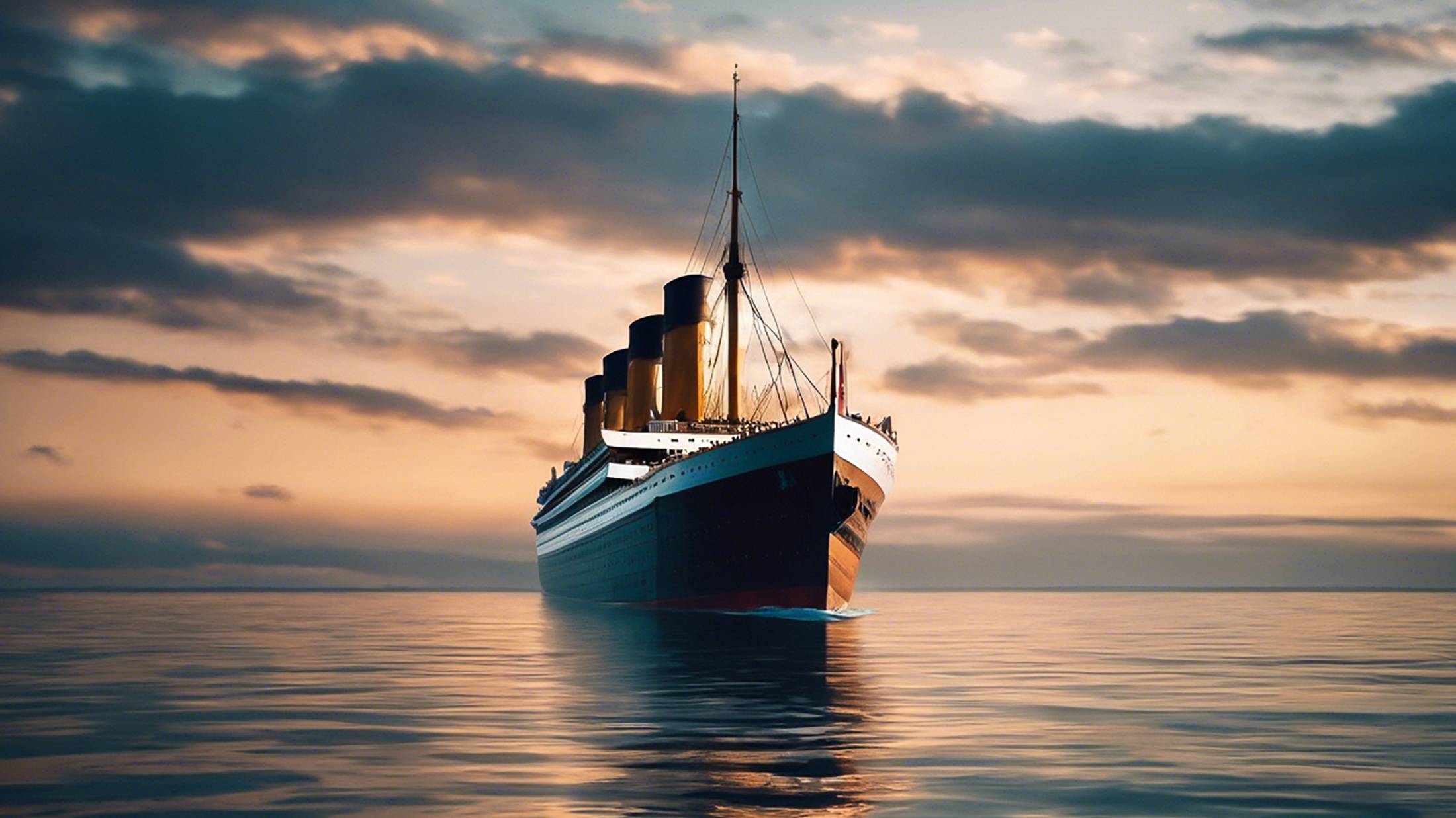
After the Titanic tragedy, Kate discovered she was pregnant with Henry’s child. She returned to England, where she gave birth to a daughter named Ellen Mary on January 11, 1913, approximately nine months after the Titanic sank. Ellen’s paternity was never officially recognized, but it was acknowledged through financial support from Henry Morley’s family for Ellen’s upbringing.
Kate’s story, particularly her romance with Henry and the birth of their child, is said to have inspired elements of the fictional love story depicted in James Cameron’s 1997 film Titanic. The film’s narrative, featuring a love affair and a significant necklace, mirrors aspects of Kate and Henry’s real-life story.
More on Titanic Cuisine
The Titanic’s menu was a reflection of the culinary tastes of the early 20th century, some of which might seem strange to modern diners. One such dish was “Chicken à la Maryland,” which was essentially fried chicken served with gravy and sometimes accompanied by corn fritters3. Another unusual dish was “potted shrimps,” a traditional British dish consisting of brown shrimp flavored with nutmeg and cayenne pepper, then cooked in clarified butter2.
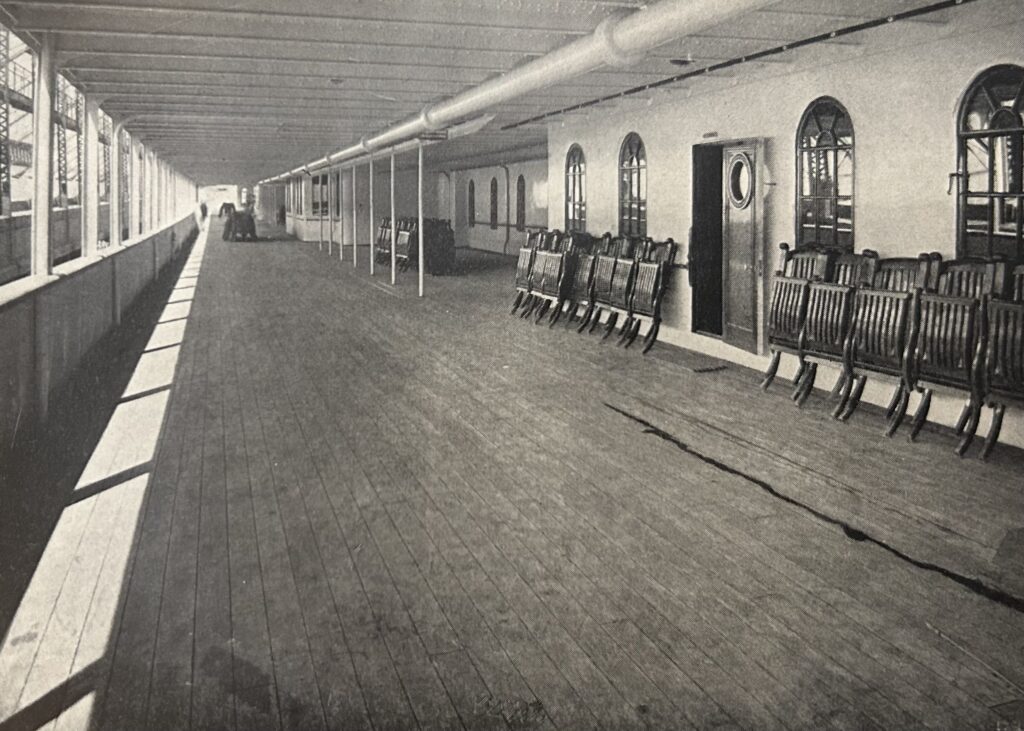
The first-class menu also included “Corned ox tongue,” a dish that involved curing an ox tongue with salt (corns of salt, hence the name ‘corned’), then boiling it and serving it cold, often with a variety of cheeses7. This dish might seem unusual to many today, given that offal and cured meats are less commonly consumed in many cultures now compared to the early 20th century.
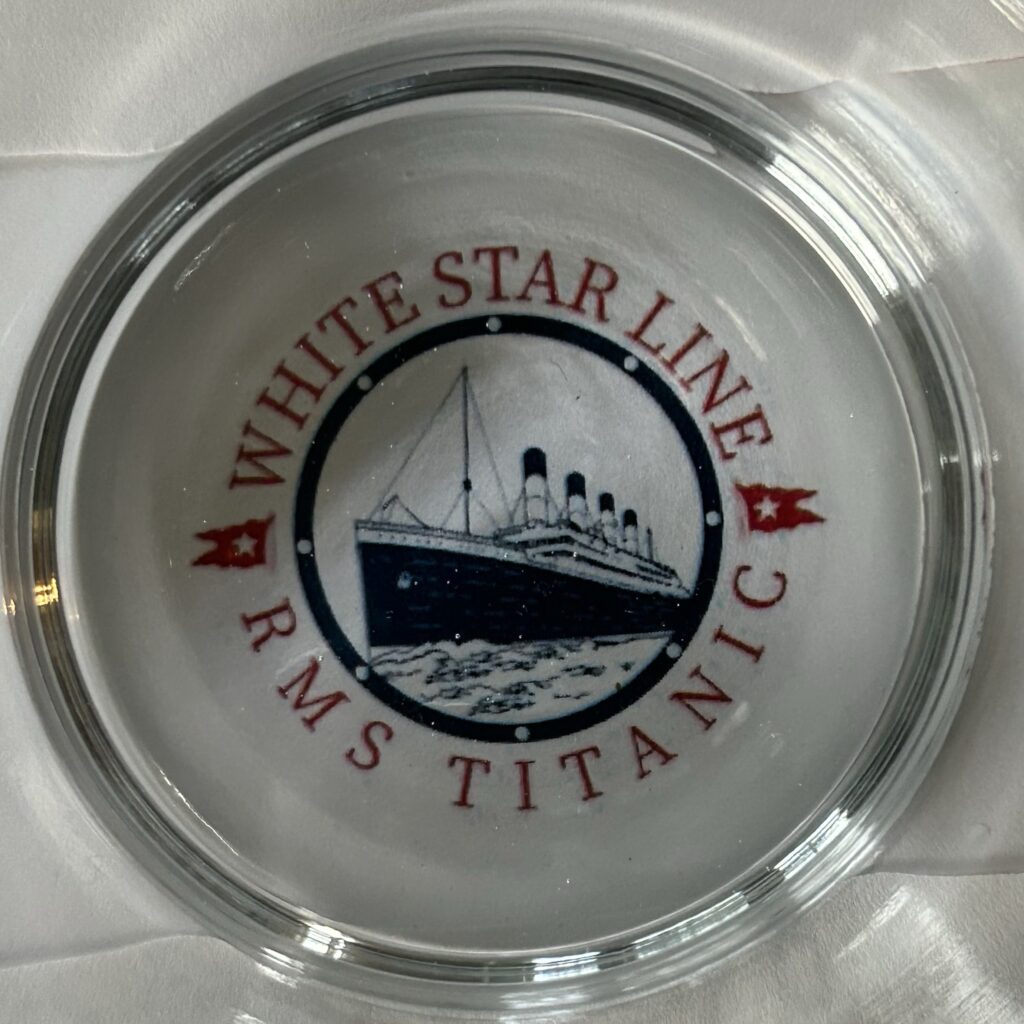
It’s important to note that these dishes, while perhaps strange to some contemporary tastes, were considered delicacies during the Titanic’s time and reflect the culinary preferences of that era137.

The last meal served in the first-class restaurant on the Titanic (called the Ritz) was an extravagant and decadent affair. For first-class passengers, the final dinner included delicacies like oysters, salmon, filet mignon, sautéed chicken, rack of lamb with mint sauce, sirloin of beef, and roast duckling5. According to the book “The Last Dinner on the Titanic,” the menu consisted of no less than 10 courses for the VIPs3. The menu included:
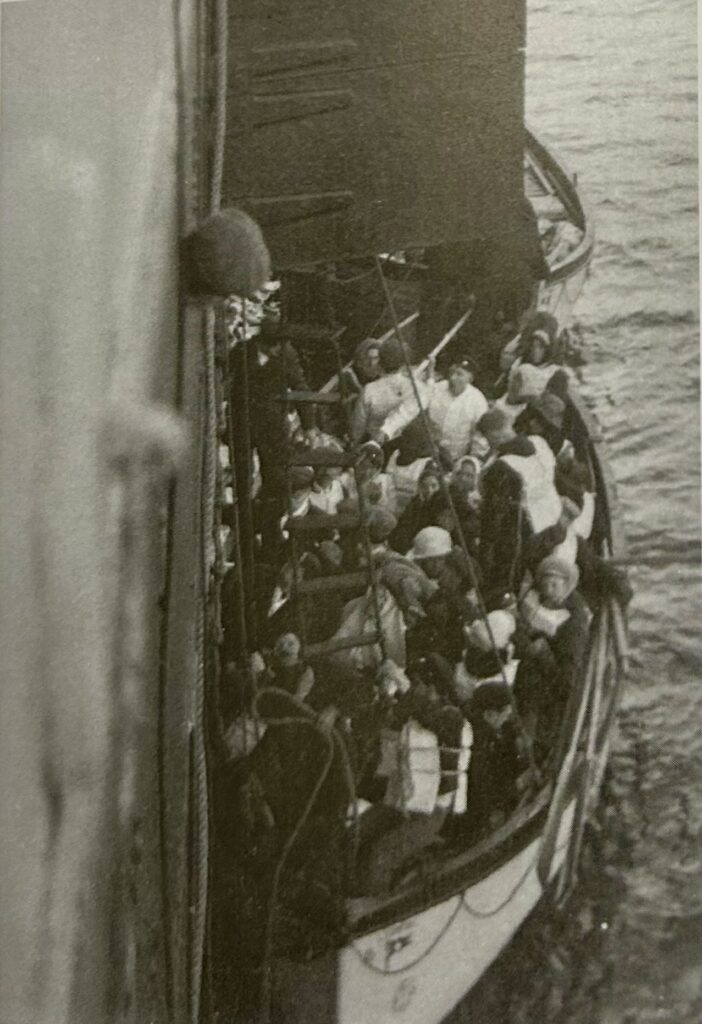
- First Course: Hors D’Oeuvres
- Second Course: Consommé Olga, Cream of Barley
- Third Course: Poached Salmon with Mousseline Sauce, Cucumbers
- Fourth Course: Filet Mignons Lili, Sauté of Chicken, Lyonnaise, Vegetable Marrow Farci
- Fifth Course: Lamb, Mint Sauce, Roast Duckling, Apple Sauce, Sirloin of Beef, Chateau Potatoes, Green Pea, Creamed Carrots, Boiled Rice Parmentier & Boiled New Potatoes
- Sixth Course: Punch Romaine
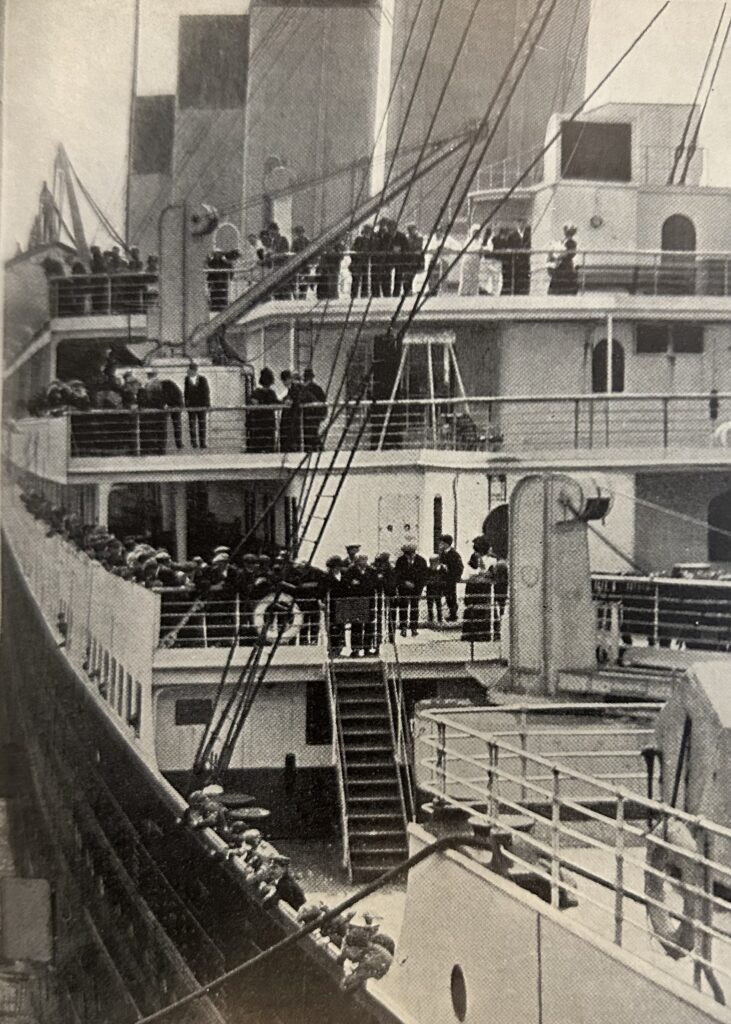
Mousseline sauce is a luxurious and rich variation of the classic hollandaise sauce. It is made by creating a hollandaise base, which is an emulsion of egg yolks, lemon juice, and butter, and then folding in whipped cream to create a light and airy texture. The addition of whipped cream gives the sauce a smooth and velvety consistency, making it an elegant accompaniment to dishes such as fish, eggs, and vegetables. The sauce is known for its delicate and light texture, and it is often used to complement equally delicate textured foods. The process of making mousseline sauce involves carefully emulsifying the hollandaise base and then gently folding in the whipped cream to maintain the airy structure of the sauce.
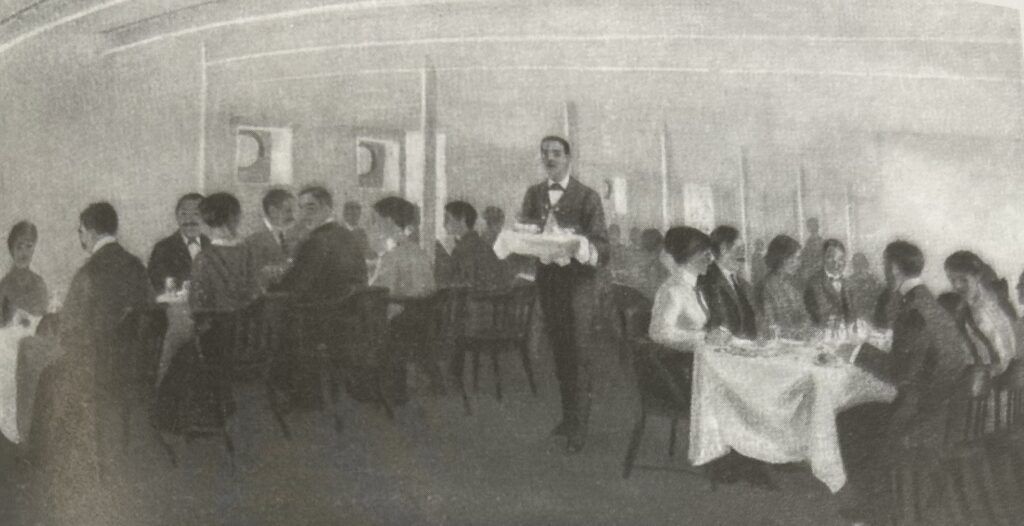
Consommé Olga was a first-class soup served on the Titanic’s final dinner. It was a clarified beef consommé, garnished with a few slices of scallops and finely diced vegetables such as celeriac, carrot, and cucumber. The consommé was then flavored with a splash of port. The dish was considered a glamorous and elegant part of the opulent 10-course meal served to the ship’s VIP passengers5.

Harland & Wolf’s Works
Lyonnaise, in the context of food, refers to a French culinary style associated with the city of Lyon. One of the well-known dishes in this style is “Lyonnaise Potatoes,” which are potatoes that are boiled and then sliced and shallow-fried, served together with fried onions. The term “à la lyonnaise” generally means that onions are a key part of the recipe. In the case of Lyonnaise Potatoes, the dish is sautéed and served with fried onions, creating a flavorful and comforting side dish. The dish is often made with ingredients such as potatoes, onions, and butter, and it is a popular accompaniment to a variety of main courses.
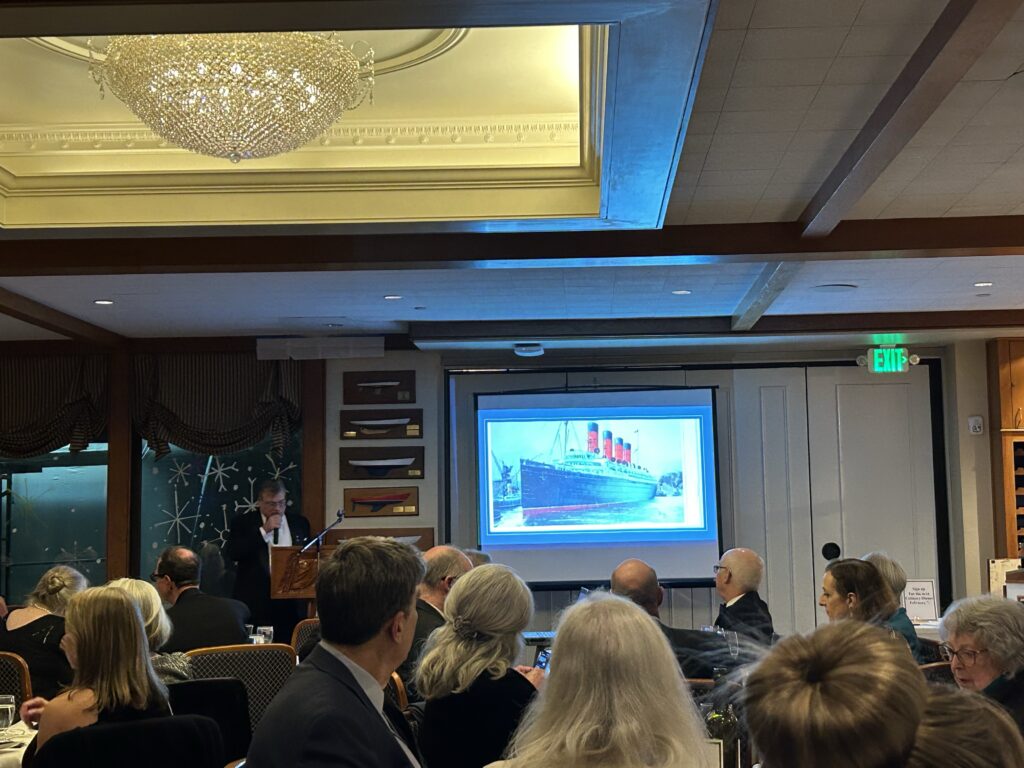
Punch Romaine was a rum-spiked shaved-ice palate cleanser served to first-class passengers during the last dinner aboard the Titanic on April 14th, 1912. It was based on a recipe from the famed French chef Georges Auguste Escoffier, who championed alcoholic shaved ices during the early twentieth century. The original recipe was essentially a granita and has been updated as a drinkable, citrusy cocktail poured over an iceberg of crushed ice. The ingredients typically include egg white, white rum, white wine, simple syrup, lemon juice, orange juice, and champagne or sparkling wine. It was a refreshing and elegant drink that formed part of the extravagant 10-course final meal served to the ship’s VIP passengers34.
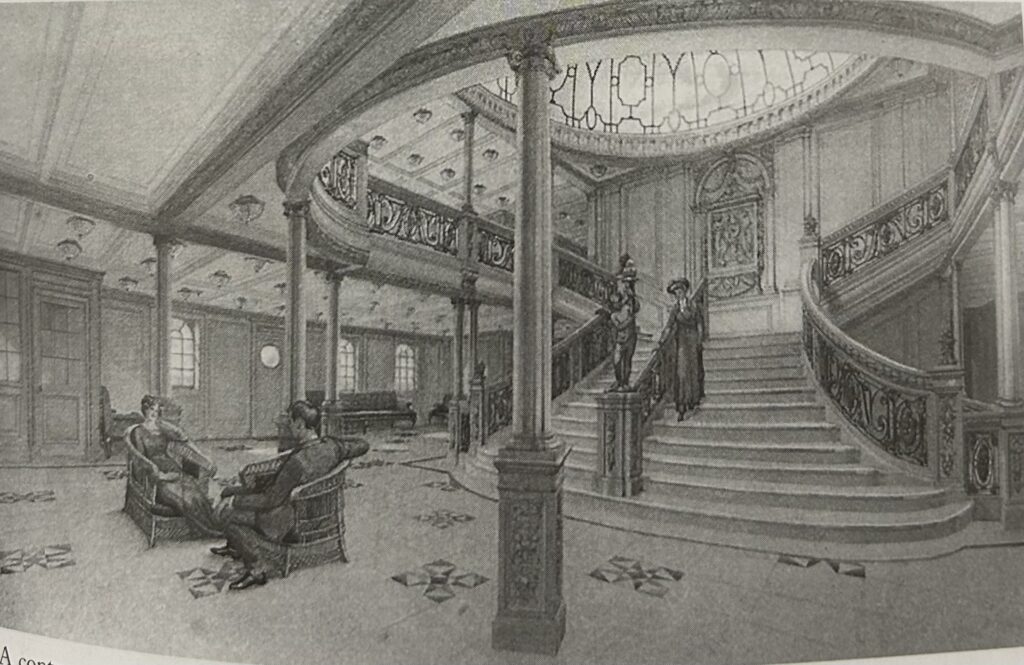
The Titanic Museum is located in Pigeon Forge, Tennessee, and Branson, Missouri. The museum offers a variety of exhibits and experiences related to the Titanic, including a replica of the Grand Staircase, a first-class dining experience, and artifacts from the ship.
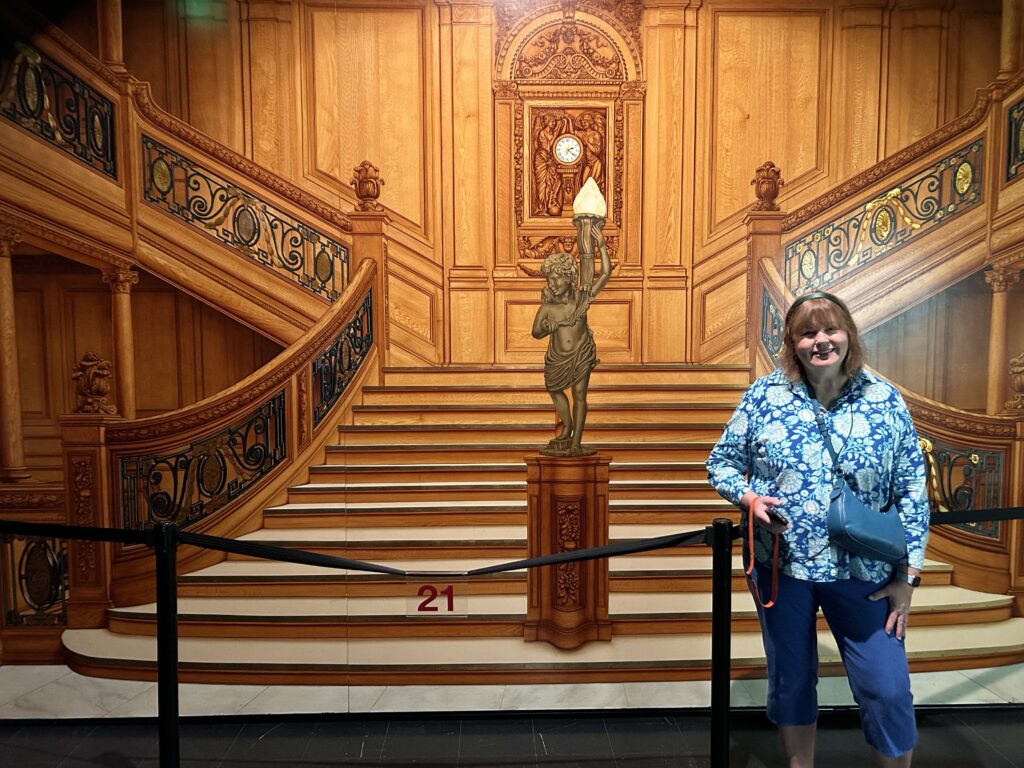
The first-class dining experience at the museum is designed to replicate the opulence and grandeur of the original Titanic dining experience. The cost of dining at the museum varies depending on the specific package or event, and it is recommended to check the official website or contact the museum directly for the most up-to-date information on dining options and pricing.
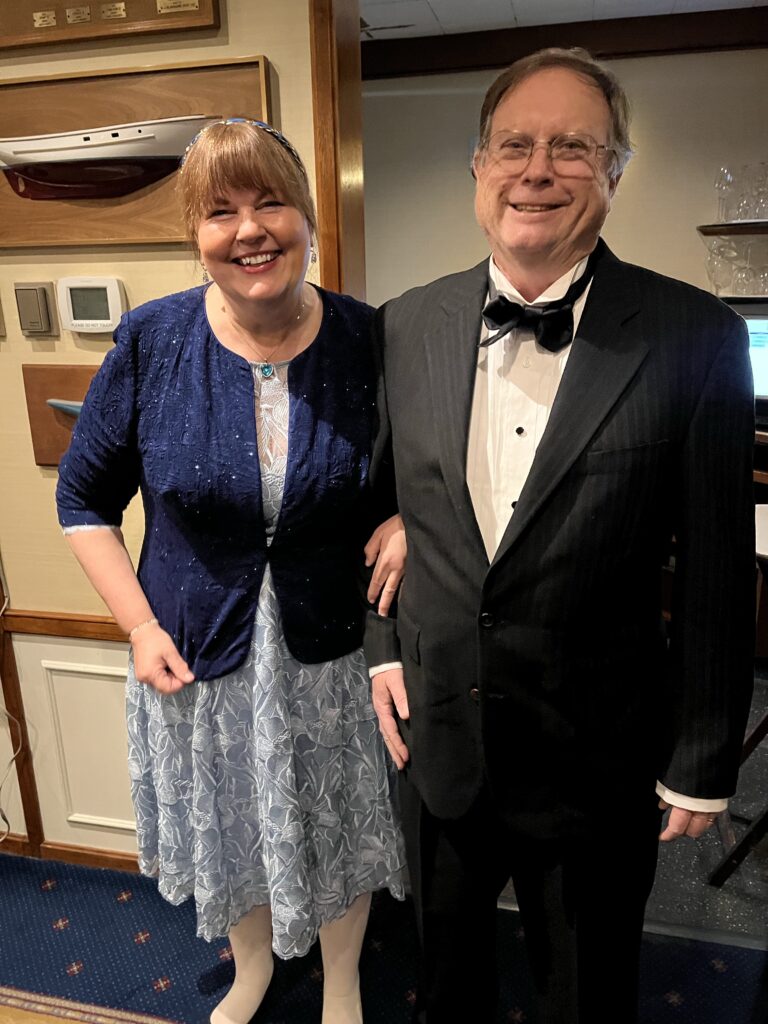
While there is no explicit mention of vegetarian or vegan options in the menus of the Titanic, it is likely that some dishes could have been suitable for vegetarians. For instance, the first-class menu included vegetable marrow farci, a dish typically made with stuffed vegetables311. The third-class menu included vegetable soups and potatoes3. However, it’s important to note that the concept of vegetarianism and veganism as we understand it today was not as prevalent in the early 20th century, and the menus were not designed with these dietary preferences in mind.
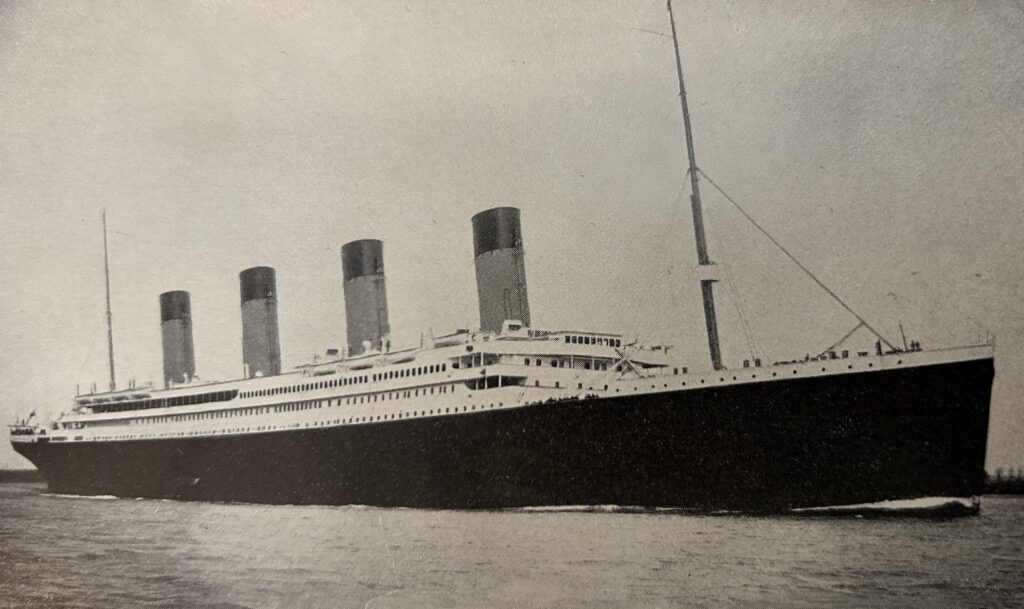
In addition to the food, passengers also looked forward to the luxurious amenities and services offered on the ship. First-class passengers enjoyed amenities such as a gymnasium, a squash court, a saltwater swimming pool, electric and Turkish baths, and a barbershop3.
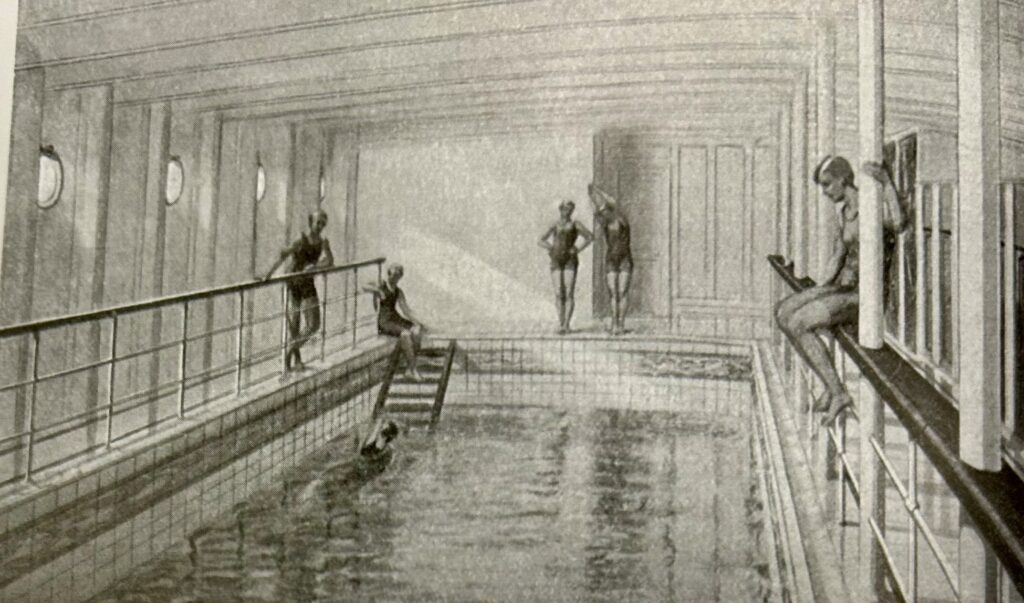
Most of the first-class bathroom facilities were shared. Communal lavatories with illuminated signage could be found along the passageways divided by gender3
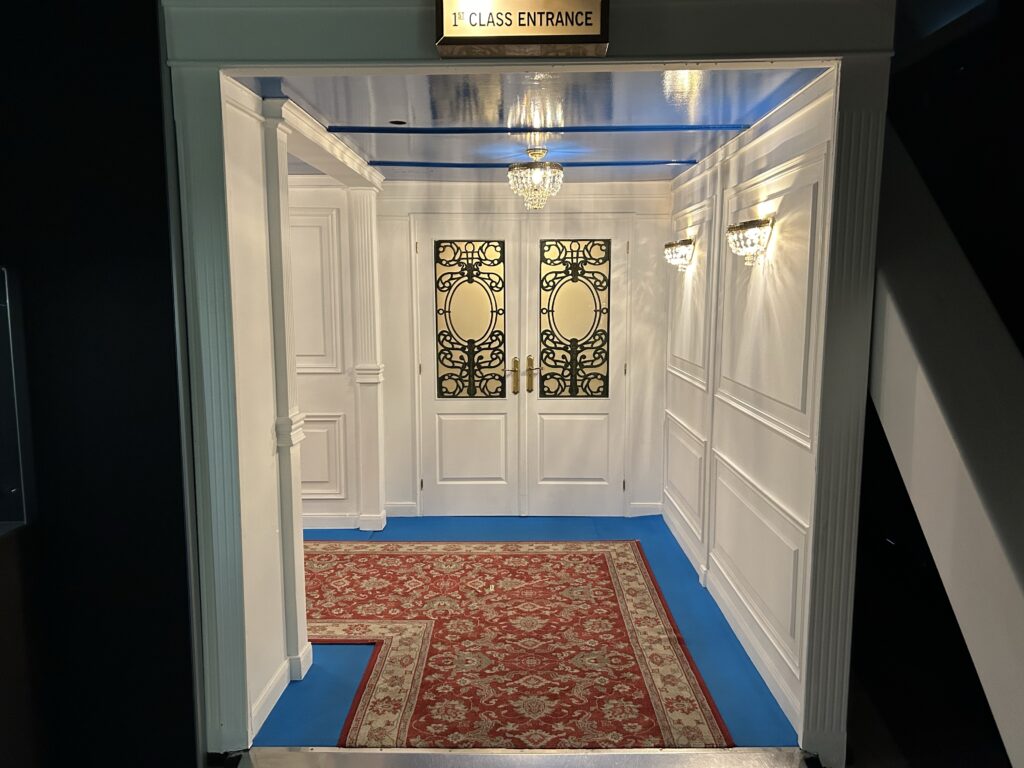
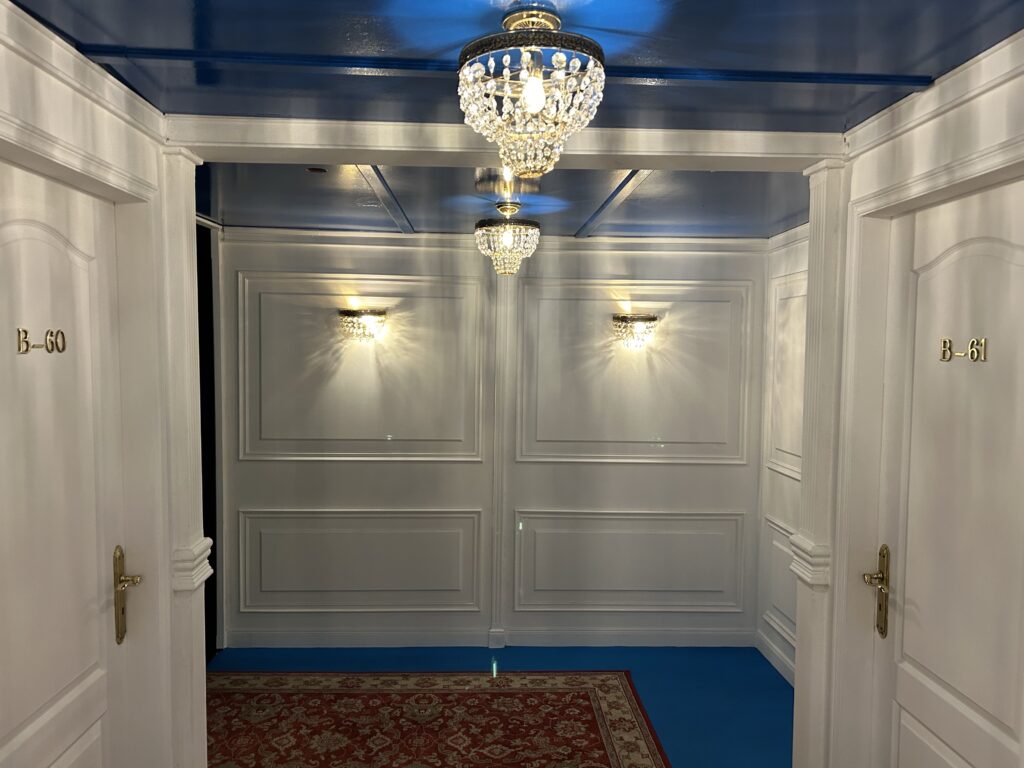
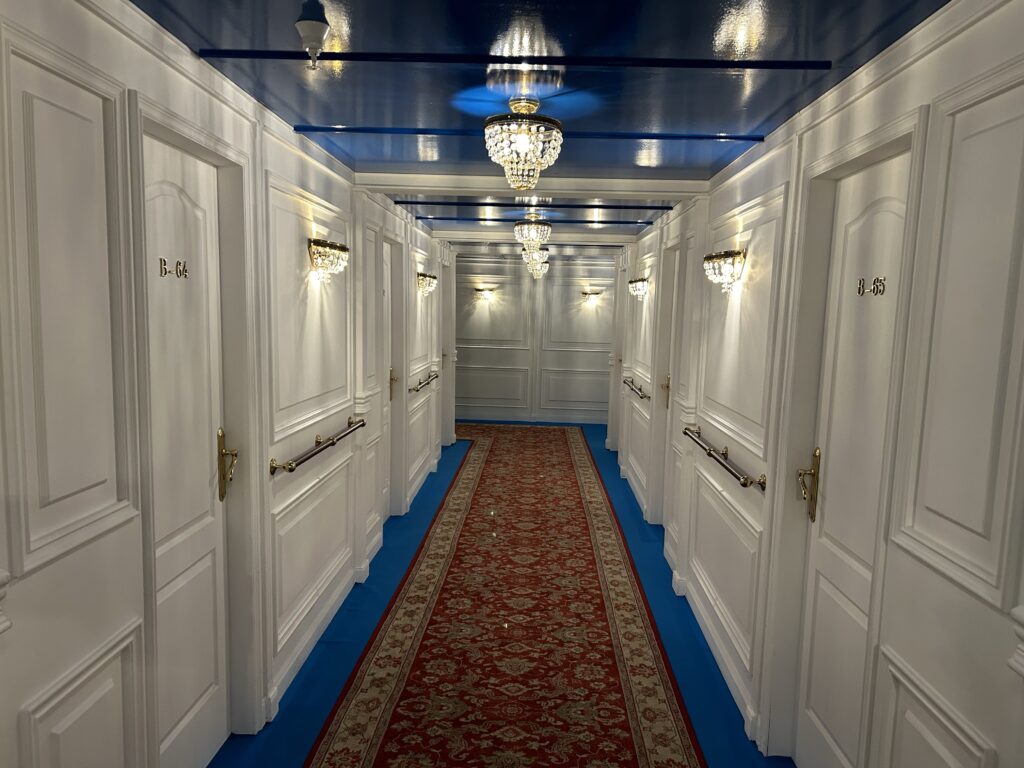
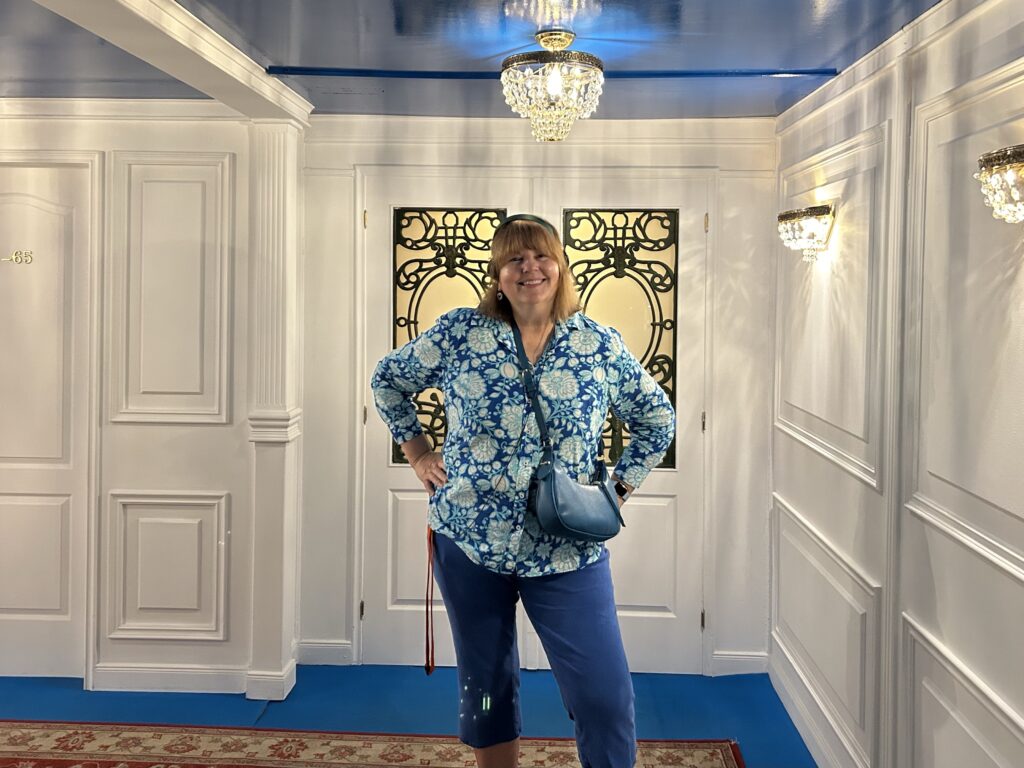

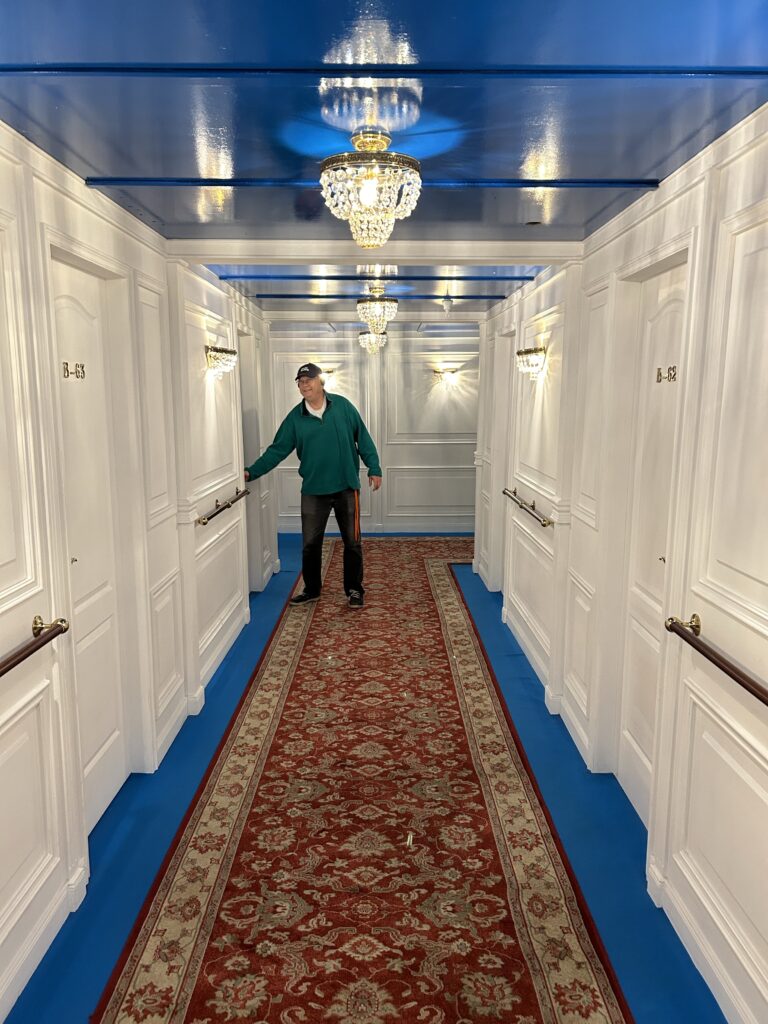
Two B-Deck “Deluxe” Parlour Suites, or Promenade Suites, because they each contained a private promenade deck 50 feet (15 m) in length, were advertised.
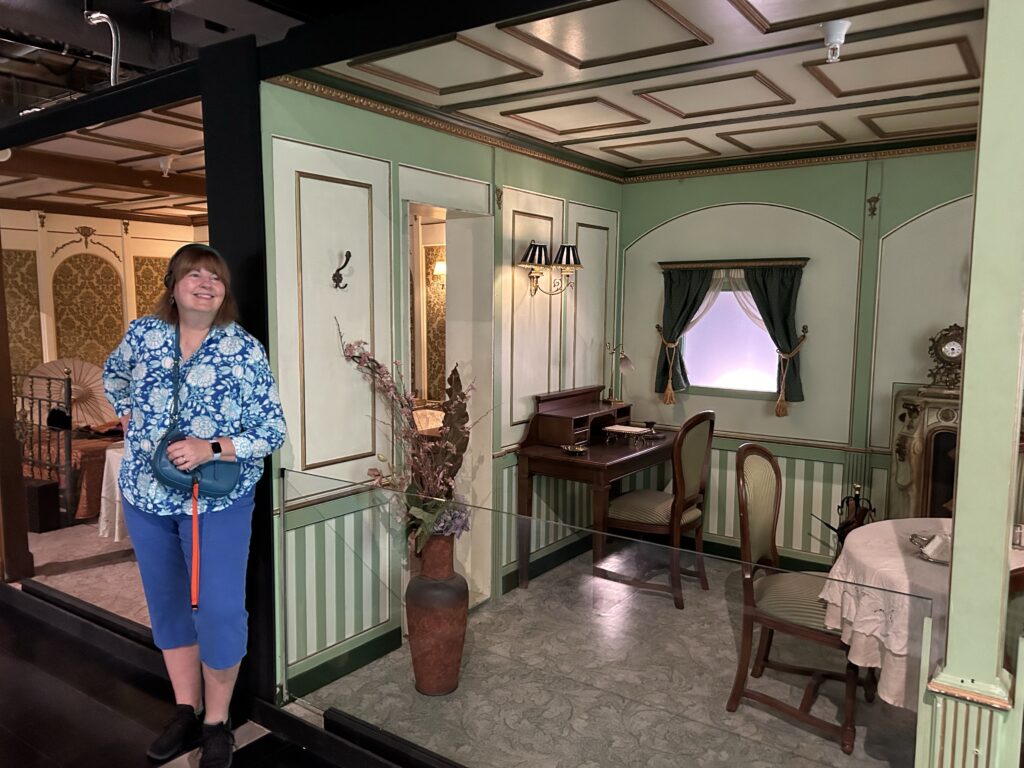
Second-class passengers had their own library and access to a private smoking room3. They also had a kosher chef.
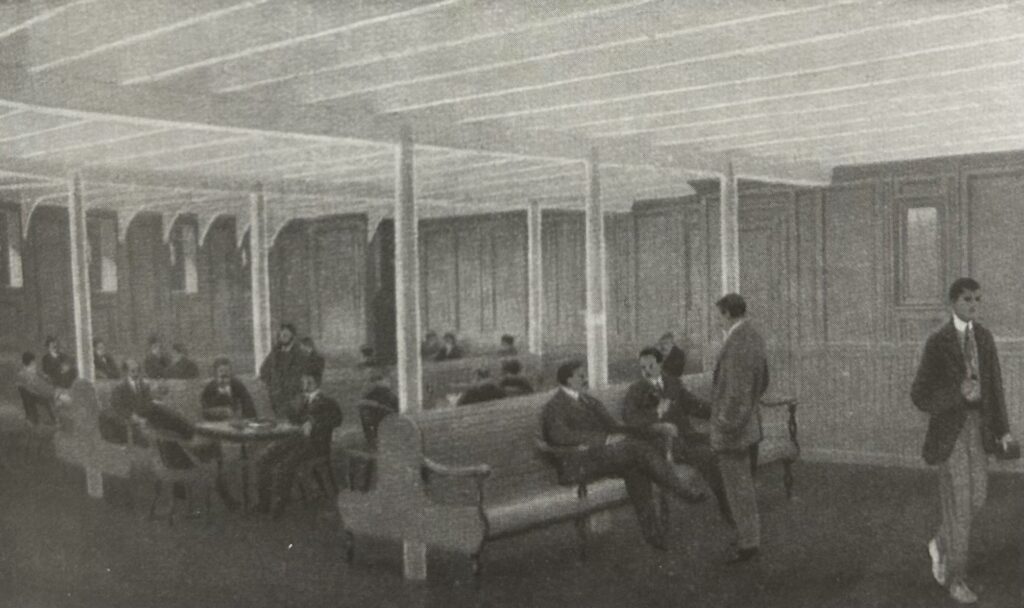
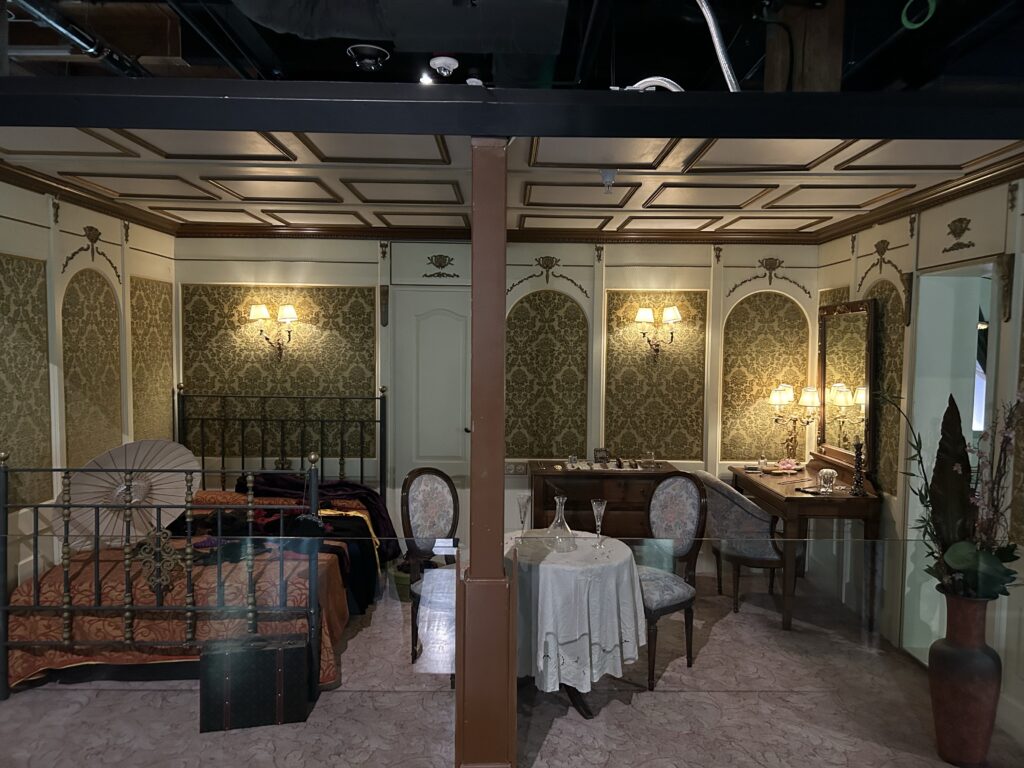
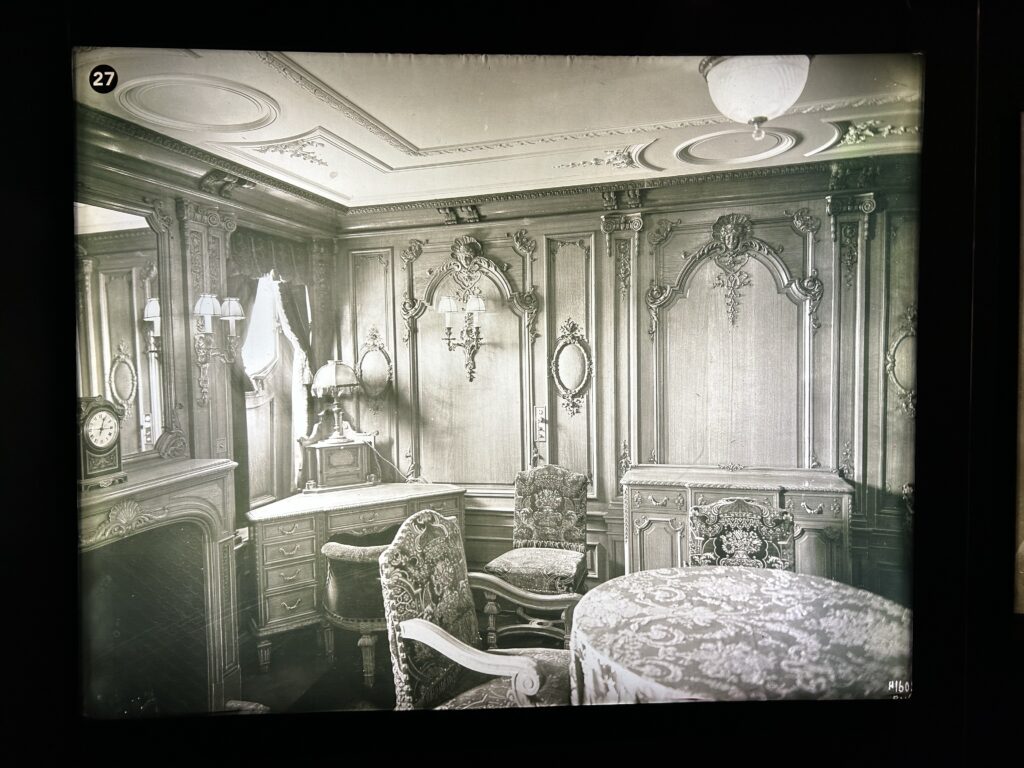
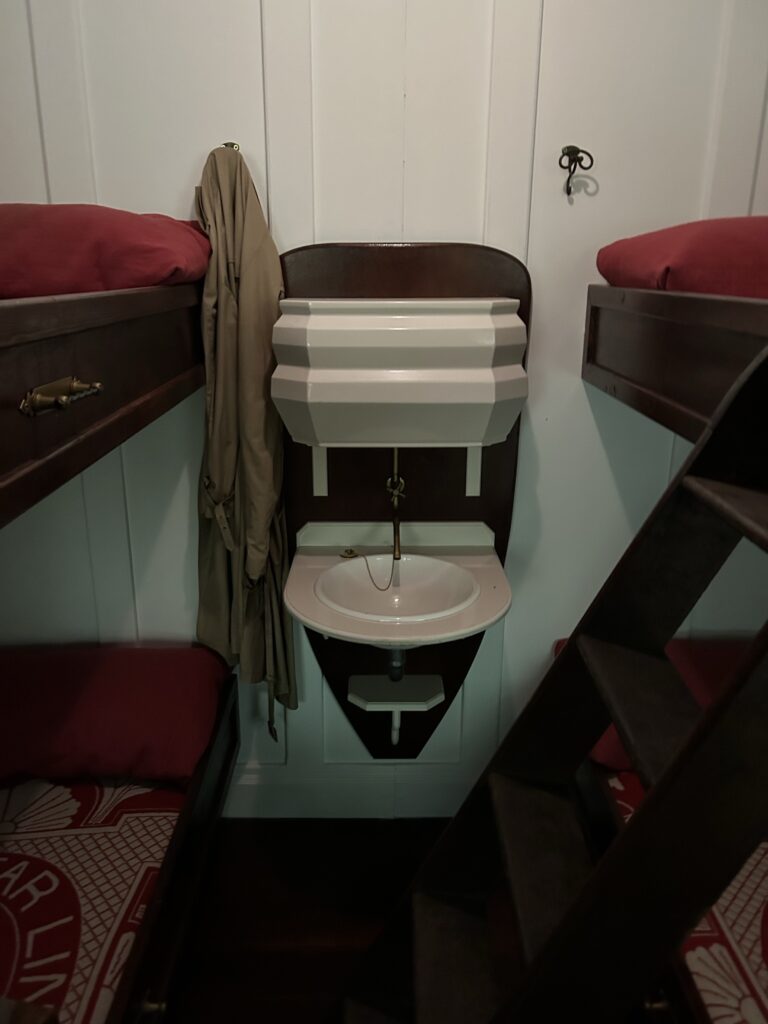
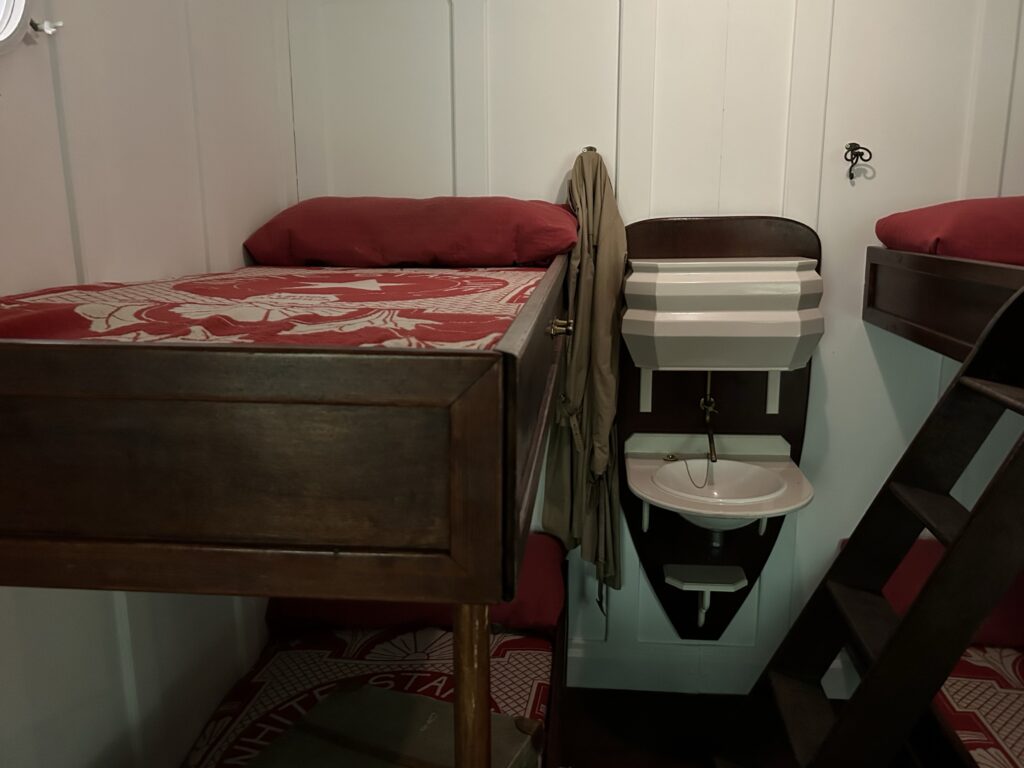
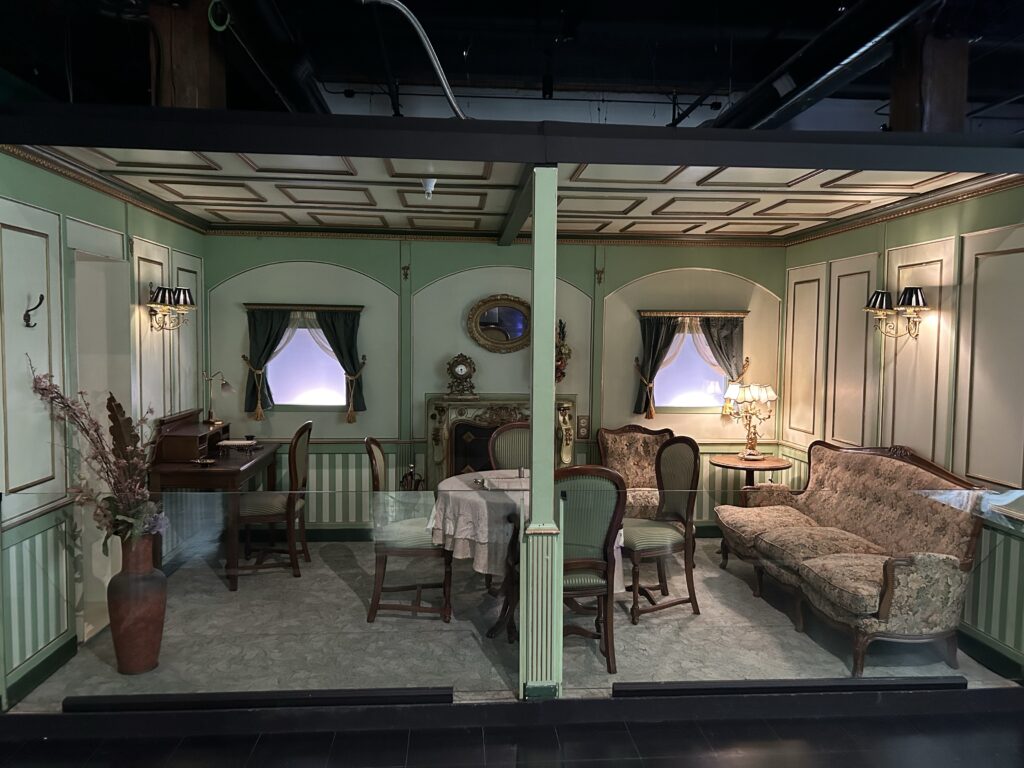
Although the Third Class passengers enjoyed none of the luxuries offered to First and Second Class passengers, the White Star Line’s provision was noticeably better than that of its competitors.
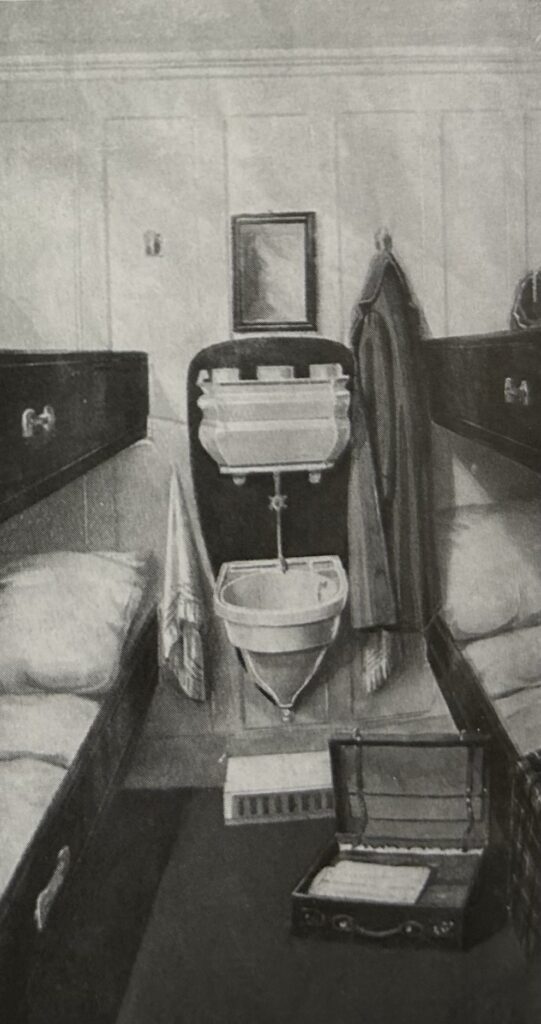
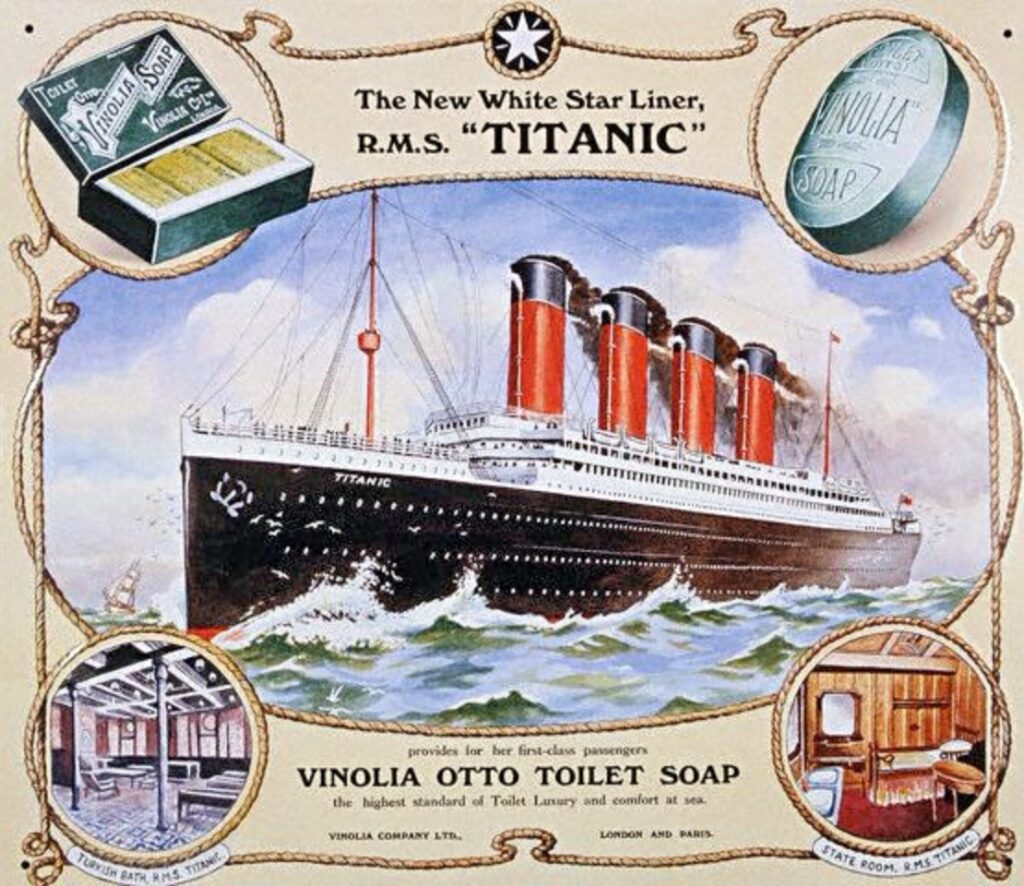
Titanic Music
The band on the Titanic, led by Wallace Hartley, was a quintet and a trio, which covered various areas of the ship, including first and second class.
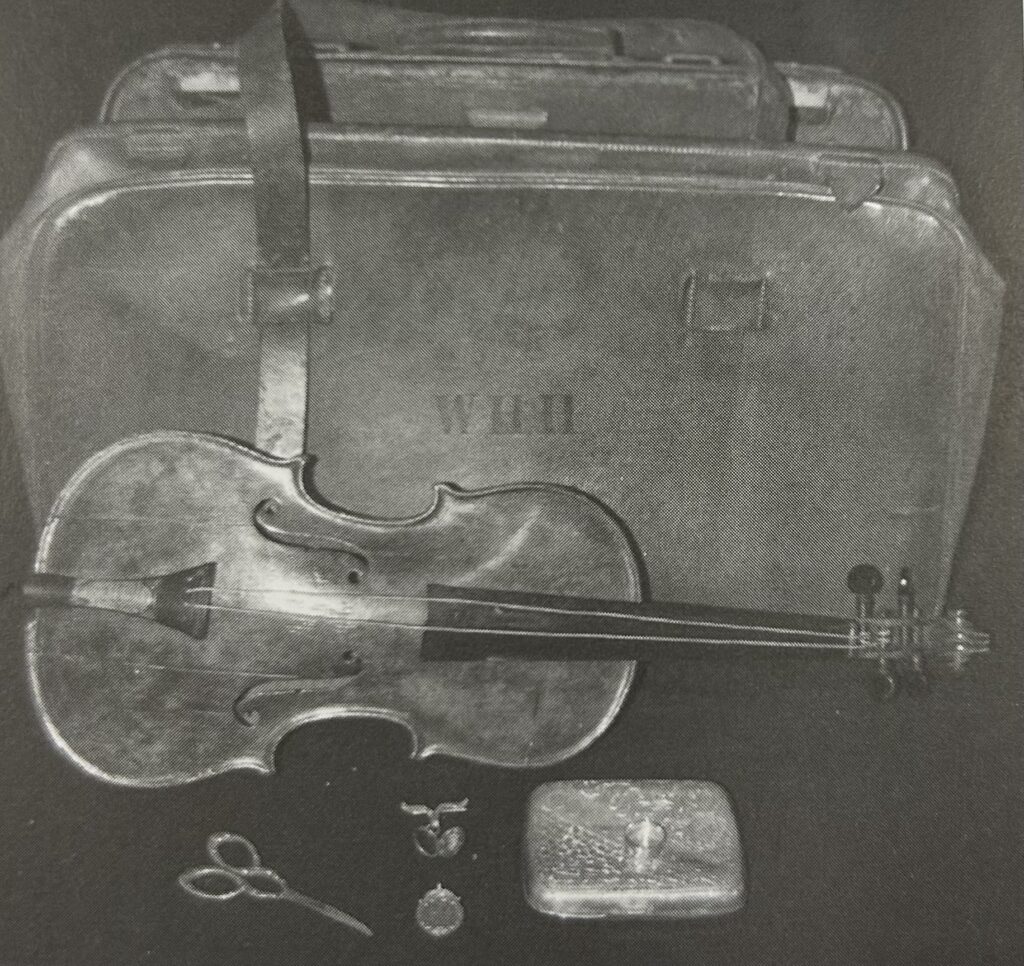
(Henry Aldridge & Son Ltd)
The band was known to play a variety of music, including classical pieces, waltzes, overtures, and popular music of the time.
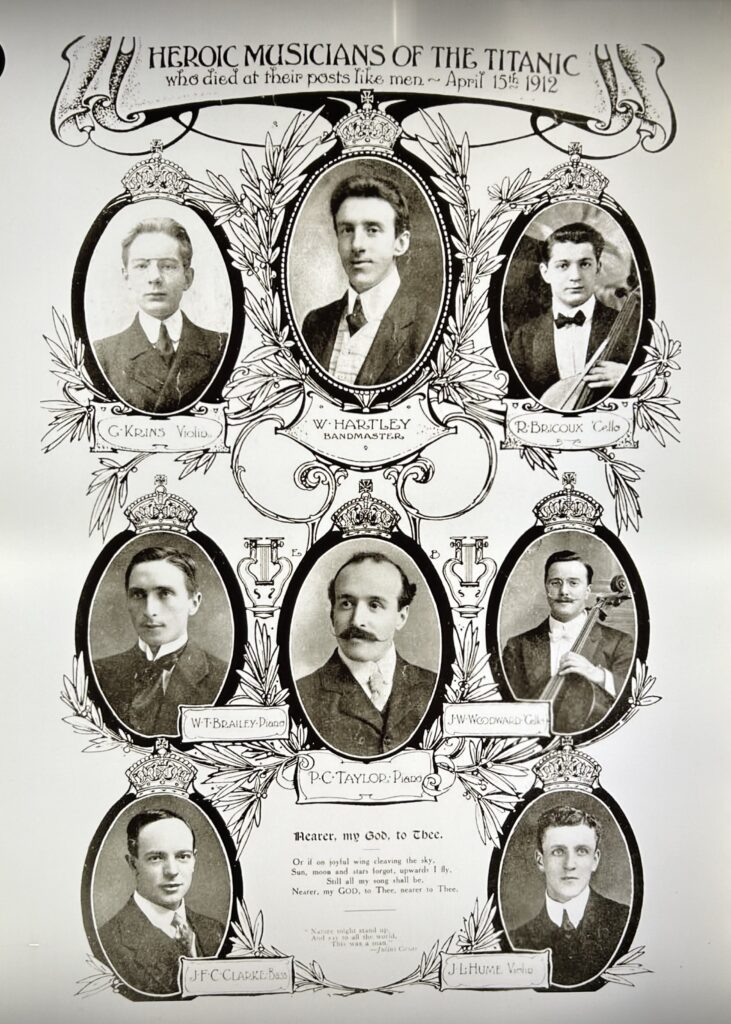
Some of the pieces played by the ship’s orchestra aboard the Titanic included:
- Il Barbiere di Siviglia – Rossini
- Zampa – Herold
- Semiramide – Rossini
- La Gazza ladra – Rossini
- Muta di Portici – Auber
- Italiana in Algeri – Rossini
- Tancredi – Rossini
- Guglielmo Tell – Rossini
- Morning, Noon and Night in Vienna – Suppè
- Pique Dame – Suppè
- Poet and Peasant – Suppè
- Raymond – A. Thomas
- Martha – Flotow
- Angel’s Serenade – Braga
- Anvil Chorus from Il Trovatore – Verdi
- Apple Blossoms – Roberts
- Amaryllis – Ghys
- Cavalieria Rusticana, Intermezzo – Mascagni
- Entre Act Gavotte from Mignon – Thomas
- Fifth Hungarian Dance – Brahms
- First Heart Throbs – Eilenberg
- Flower Song – Lange
- La Morsaria – Morse
- La Paloma. – Yradier
- Loin Du Bal – Gillett
- Love’s Dream
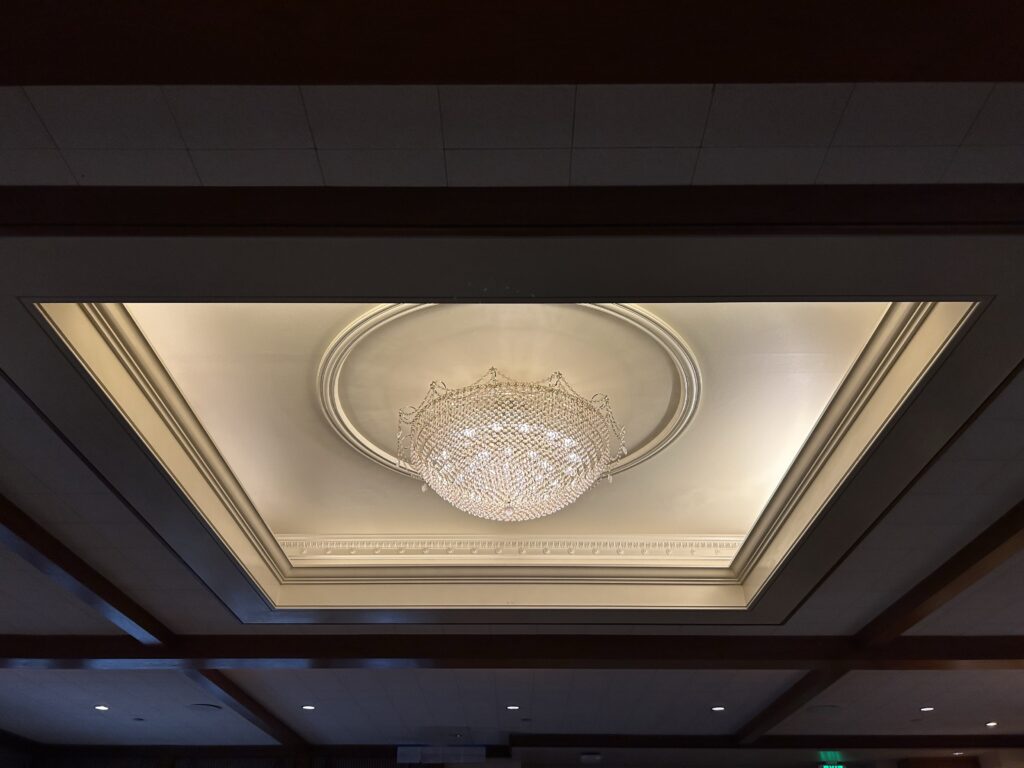
These pieces provide a glimpse into the musical repertoire that would have been played by the ship’s orchestra during the Titanic’s fateful voyage. The band’s story, including their dedication to playing music to calm passengers as the ship sank, has become legendary and is an enduring part of the Titanic’s history.
In 2024, former President Donald Trump’s campaign used Celine Dion’s iconic song “My Heart Will Go On” from the movie Titanic at several rallies, including one in Bozeman, Montana, without her permission. This unauthorized use led to criticism from Dion and her management team, who issued a statement expressing their disapproval and humorously questioning the choice of song with “And really, THAT song?“.
The choice of “My Heart Will Go On” as a campaign song was seen as ironic and inappropriate by many commentators, given its association with the tragic sinking of the Titanic. The song, a romantic ballad, does not align with typical campaign themes and has been interpreted as a tone-deaf choice, potentially signaling a need for rescue rather than success.
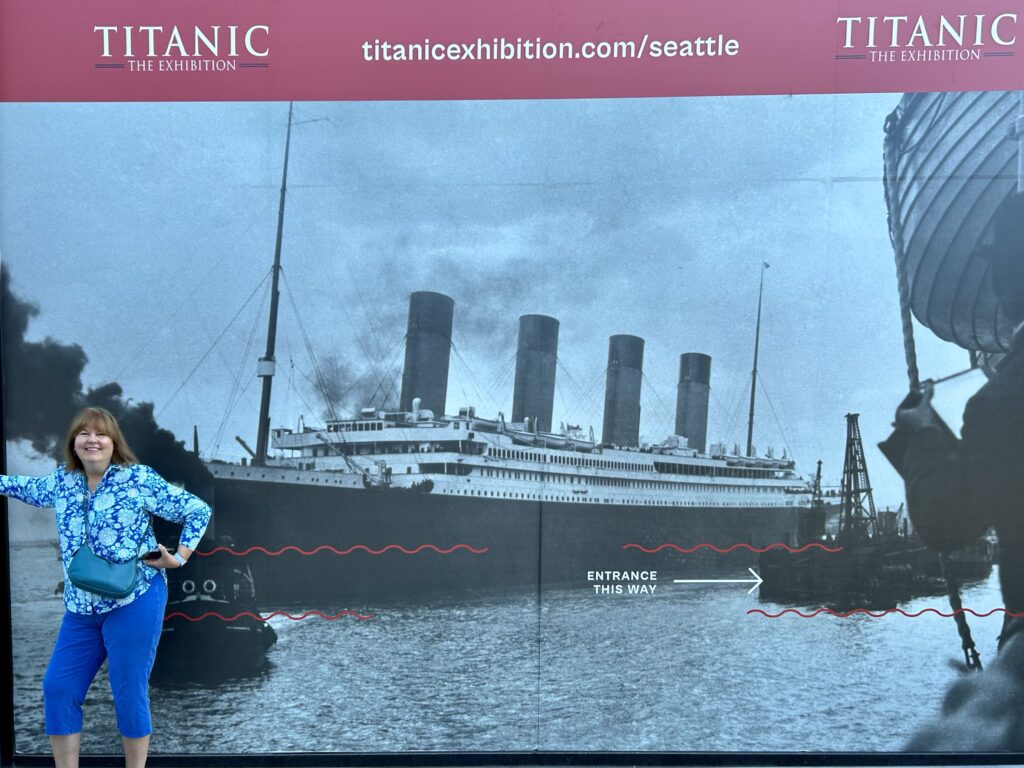
Celine Dion publicly criticized the Trump campaign for using her music without authorization and explicitly stated that she does not endorse this use or any similar application. Her management and record label, Sony Music Entertainment Canada, emphasized that they had not granted permission for the song’s use and were surprised to learn about it.
This incident is part of a broader pattern where various artists, including the Rolling Stones, Rihanna, and Neil Young, have objected to the Trump campaign’s use of their music at rallies without permission, often leading to public statements and legal warnings. Nonetheless, familiar songs are reflective of Pop Culture.
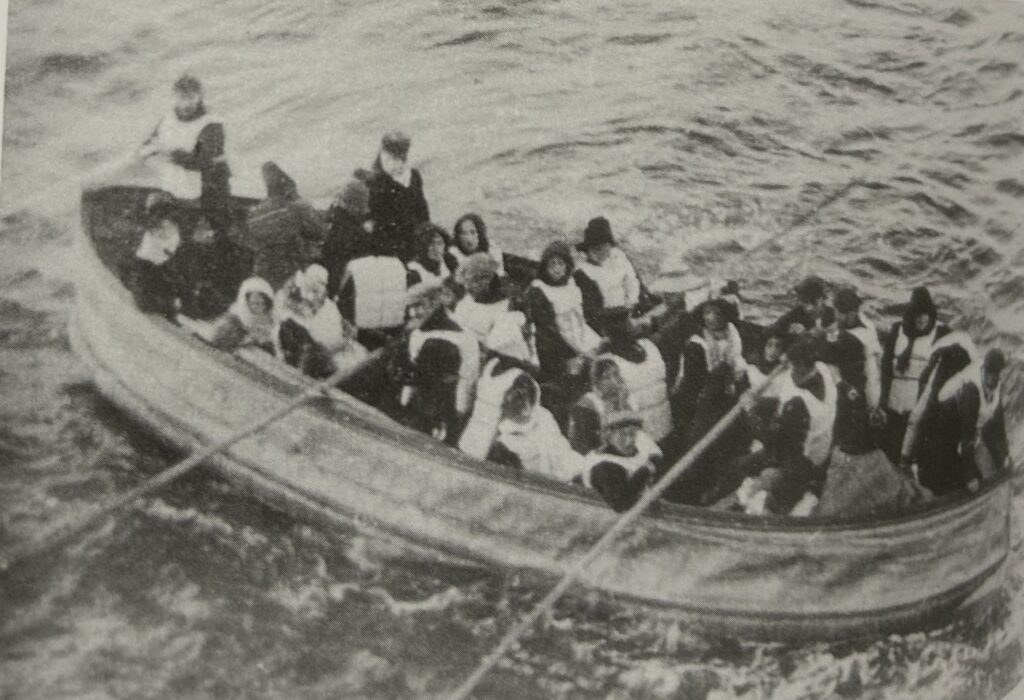
The Titanic film, directed by James Cameron, features a notable soundtrack with several hit songs. Some of the well-known songs from the film include:
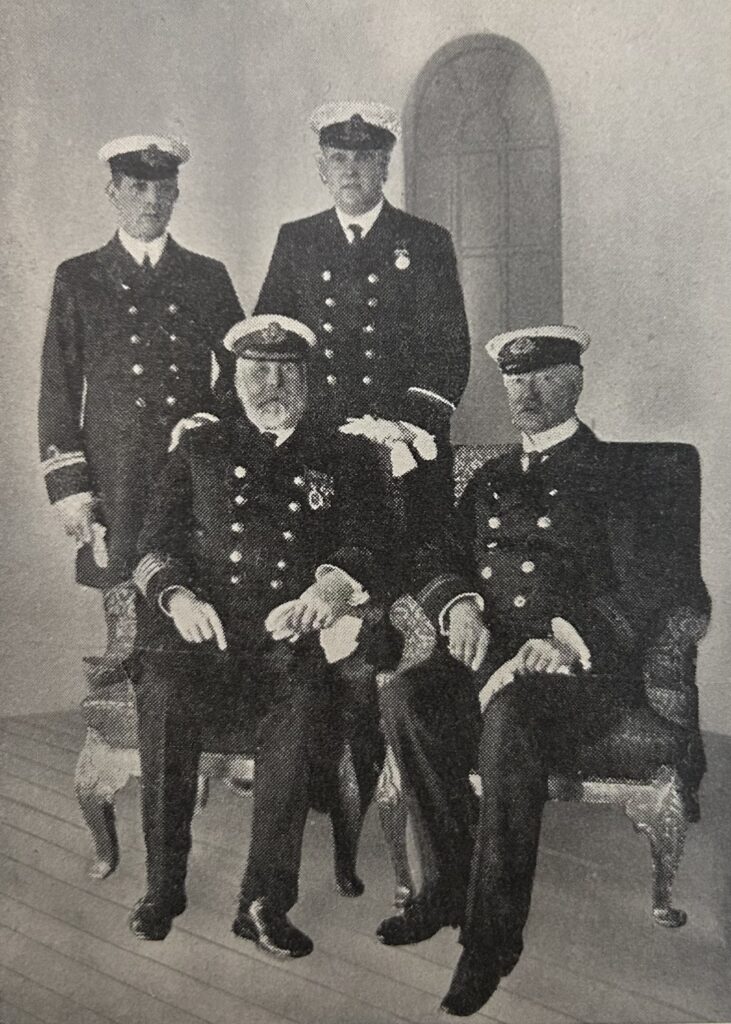
- “My Heart Will Go On” – Performed by Céline Dion
- “Take Her to Sea, Mr. Murdoch” – Composed by James Horner
- “Southampton” – Composed by James Horner
- “The Portrait” – Composed by James Horner
- “Unable to Stay, Unwilling to Leave” – Composed by James Horner
- “Hymn to the Sea” – Composed by James Horner
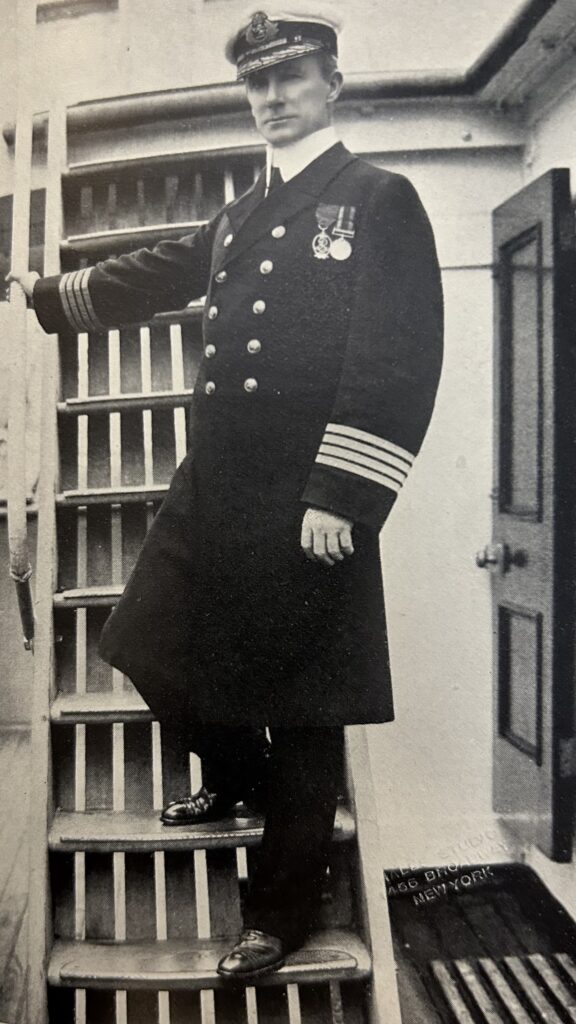
These songs, particularly “My Heart Will Go On,” which was performed by Céline Dion, became iconic and are strongly associated with the film. The soundtrack, composed by James Horner, contributed significantly to the emotional impact of the movie and remains popular among audiences.
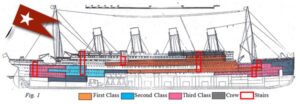
Titanic Morbidity

54 i
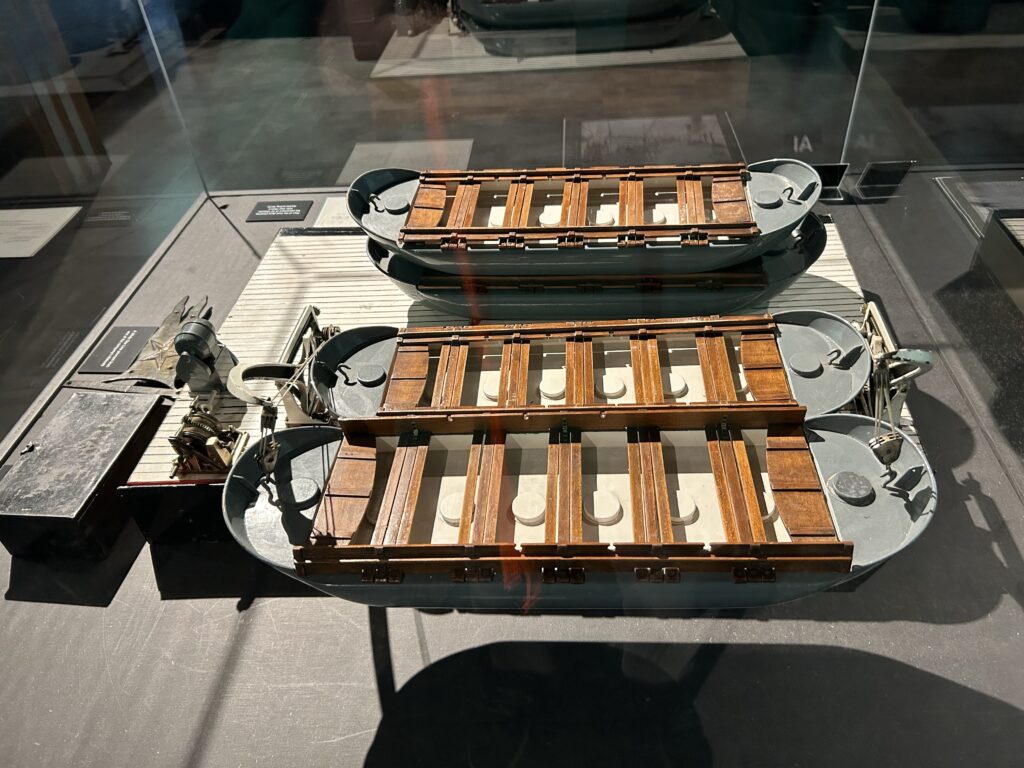
The “women and children first” protocol, also known as the Birkenhead drill, is a traditional code of conduct whereby the lives of women and children are to be saved first in a life-threatening situation at sea, typically when survival resources such as lifeboats are limited. However, it is important to note that there is no legal basis for this protocol in international maritime law. The concept was celebrated among Victorian and Edwardian commentators as a chivalric ideal, but it has no basis in maritime law1.

In the Boy Scouts of America’s Sea Scouting program, “Women and children first” is considered “the motto of the sea” and is part of the Sea Promise1.

Research has shown that in actual maritime disasters, there have been wide disparities between the survival rates of men and women. For example, in the sinking of the MS Estonia in 1994, only 5.4 percent of the women onboard survived, compared to 22 percent of the men. The research noted that men, thanks to their physical strength, have better chances of surviving than women, barring self-sacrifice5.

Therefore, while the “women and children first” protocol has been a longstanding cultural ideal, its application in actual maritime disasters has been inconsistent, and there is no legal basis for it in international maritime law.
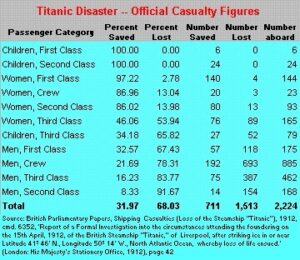
As mentioned, Titanic themed events sometimes involve attendees playing the survivors. Around Halloween, victims may be featured.

One of the misunderstandings about the Titanic’s sinking is that only women and children were allowed into lifeboats. Any men who survived, it has been wrongly assumed, either swam to a boat or entered one from the ship without permission. This was maintained at the time by some survivors, including First Class passenger Renée Harris, in their newspaper and magazine interviews. But it was untrue, gaining currency to the point that many people believe the myth today.
For the most part, female survivors who claimed male passengers weren’t permitted in lifeboats were those who escaped in port side boats. There, Capt. Smith’s order of “Women and children first” had indeed been garbled by Second Officer Lightoller into “Women and children only.”
Titanic’s Aft Lifeboats
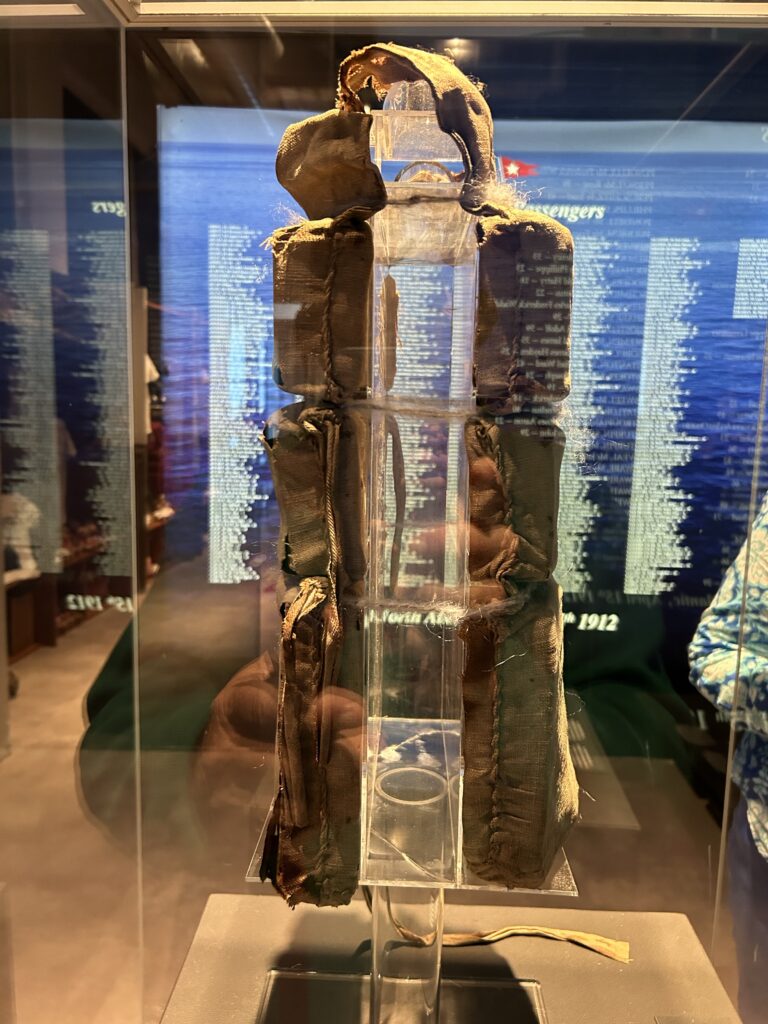
Despite the presence of life jackets, many passengers still perished due to the freezing temperatures of the North Atlantic. Most of those who ended up in the water died from cold shock or cardiac arrest within minutes, rather than from drowning or direct impact injuries. The life jackets, while intended to keep individuals afloat, were not sufficient to protect against the severe cold, which was the primary cause of death for those in the water.
The Titanic had a total of 885 crew members. Out of these, 214 crew members survived, which is approximately 24% of the crew.
The Titanic had a total of 324 first-class passengers when it sank. Out of these, 202 first-class passengers survived, comprising 57 men, 140 women, and 5 children. This means that approximately 62.3% of the first-class passengers survived the sinking.
For the other classes, out of 285 second-class passengers, approximately 41% survived, and out of 709 third-class passengers, approximately 25% survived12345.
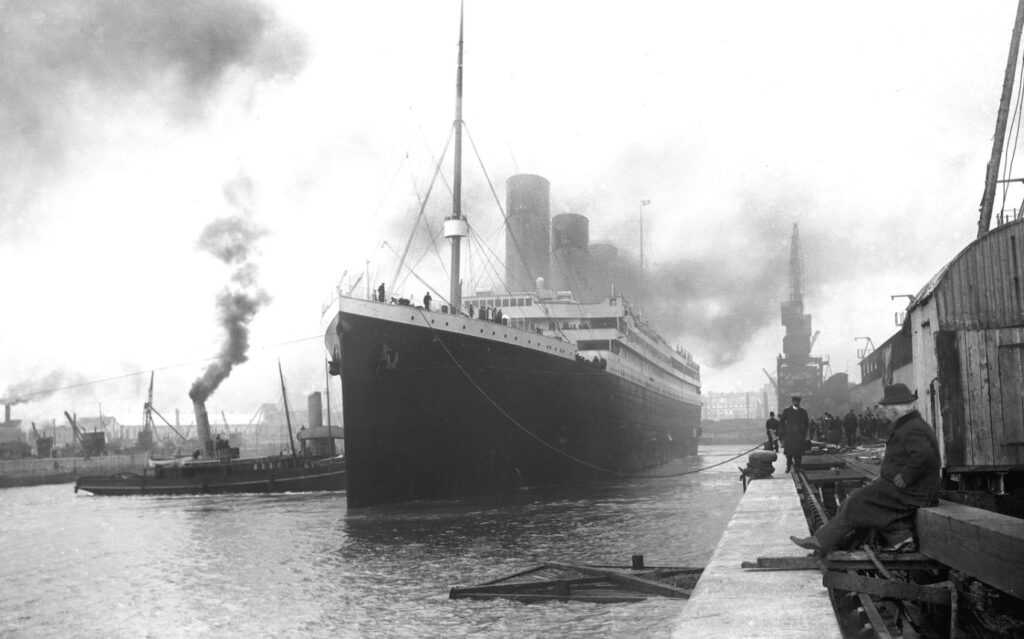
According to The Spruce Eats, the Titanic held thousands of pounds of meat, vegetables, fruit, and flour, as well as thousands of bottles of alcohol and 14,000 gallons of fresh water.
The RMS (Royal Mail Service) Titanic was a British luxury passenger liner that sank in the North Atlantic Ocean on April 15, 1912, during its maiden voyage from Southampton to New York City. It was carrying an estimated 2,224 passengers and crew, of which more than 1,500 died, making it the deadliest peacetime sinking of an ocean liner.
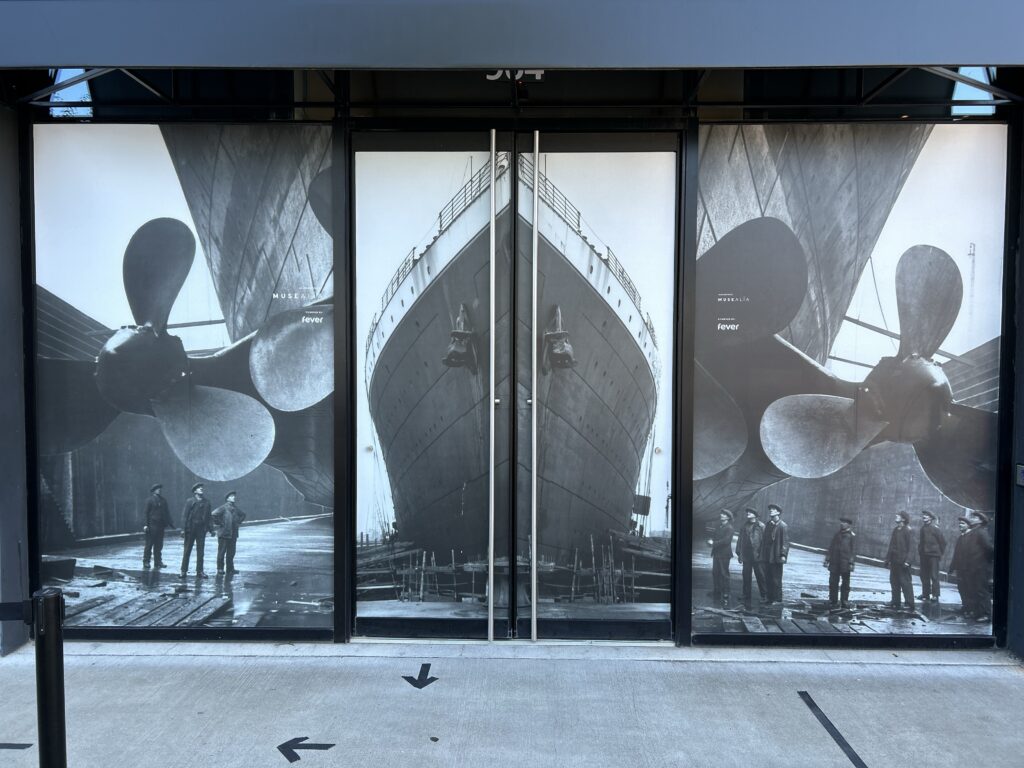
The ship’s sinking led to major changes in maritime safety regulations and inspired numerous artistic works. The wreckage of the Titanic was not discovered until 1985 by an American oceanographer named Robert Ballard. The ship’s tragic history has continued to captivate generations and has been the subject of numerous books, articles, and films12345.For more detailed information, you can visit the following links:
- R.M.S Titanic – History and Significance
- Titanic | History, Sinking, Rescue, Survivors, Movies, & Facts
- Titanic’s dark history has captivated generations | CNN
- The Westport Library Resource Guides: The Titanic: Home
- Titanic – Wikipedia
The Titanic’s last distress, sent in Intercontinental Morse Code, was:
CQD CQD SOS SOS CQD DE MGY MGY
“CQD” was the common international distress signal in use at the time; “SOS” was a newer distress signal. “DE” is the international code meaning “from”, adopted from the French preposition of the same meaning. “MGY” was the Titanic’s call signal. The signal was keyed by John G. Phillips, the Titanic’s chief Marconi operator, using a spark transmitter.
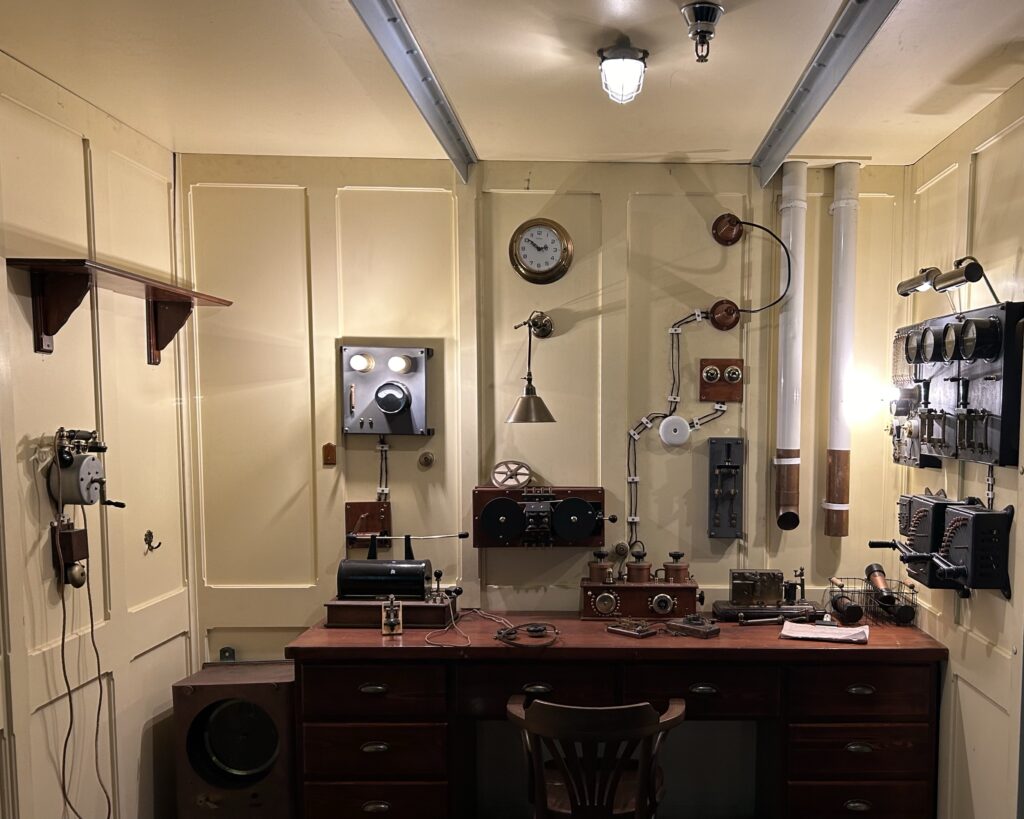
For general information on this aspect of the Titanic debacle, see Wireless communications and the Titanic disaster By David Barlow. For technical details of the Titanic’s wireless installation, see The wireless installation of R.M.S. Titanic by Douglas A. Kerr
Unsinkable
The architects of the Titanic were from the shipbuilding company Harland & Wolff, and the design of the Titanic was directed by William Pirrie, a director of Harland & Wolff and White Star Line.

The architects believed that the Titanic’s design, which included a double bottom (but not double sides) and 15 watertight bulkheads that extended higher than the required waterline, justified advertising the ship as “practically unsinkable.” These features were intended to enhance the ship’s safety and stability, making it one of the most advanced and secure vessels of its time.
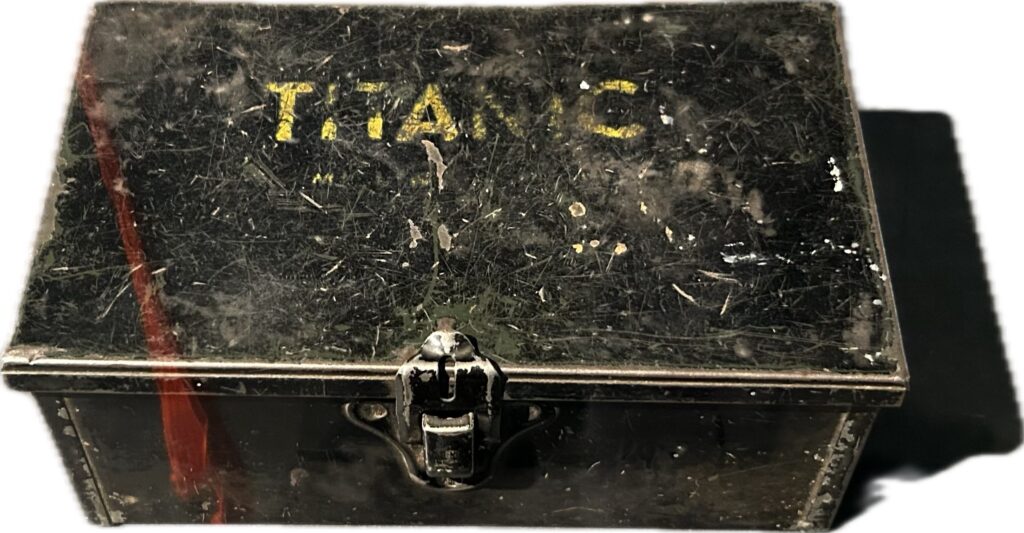
However, the ship’s tragic sinking following a collision with an iceberg on its maiden voyage in 1912 led to significant scrutiny and subsequent changes in maritime safety regulations. The architects were not held personally accountable for the Titanic sinking, as the investigations that followed focused on the ship’s design and safety regulations rather than individual culpability12.
In the USA, boats under 20 feet are required to have basic flotation to keep the boat afloat and upright in the event of a swamping. This regulation mandates upright, level flotation, but it does not necessarily require the boat to be “unsinkable” in the traditional sense.
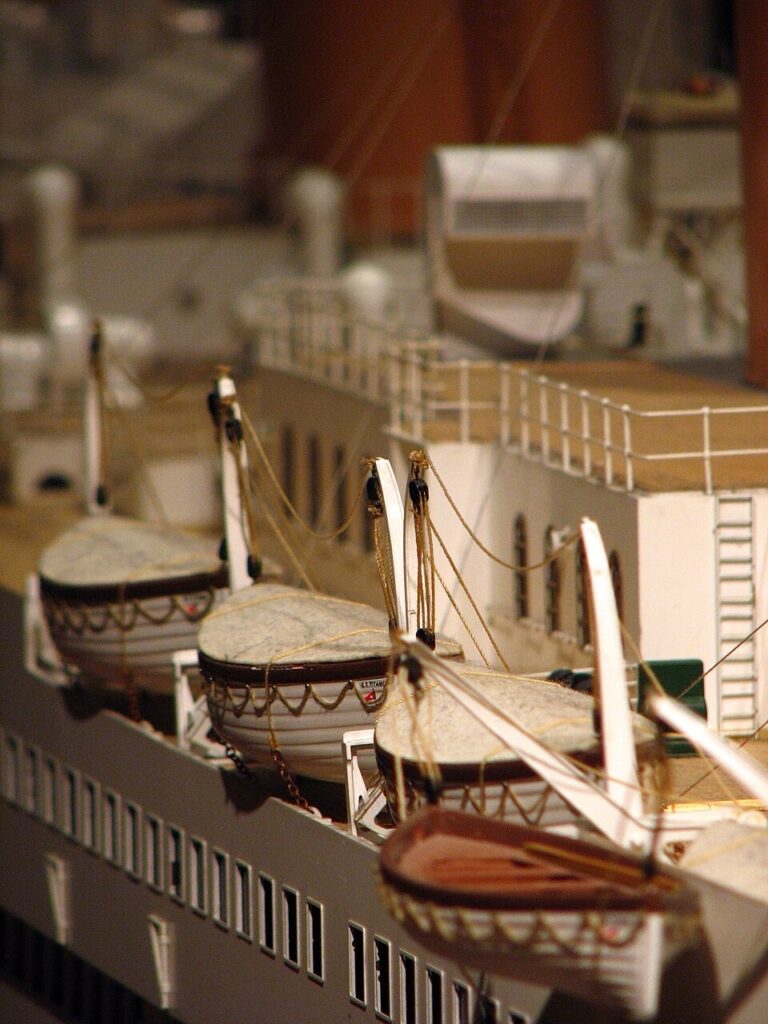
The Titanic was equipped with two emergency cutters, numbered No. 1 and No. 2, each measuring 25 feet 2 inches long, 7 feet 2 inches wide, and 3 feet deep. The cutters were situated immediately aft of the bridge, one to port and the other to starboard. While Titanic was at sea, they were slung outboard (as shown in the above photo) so that they could be launched quickly in the event of an emergency, such as a man overboard.
The cutters were smaller than the standard lifeboats, with a capacity of 40 people each. They were designed for maximum seaworthiness, with a double-ended design effectively having two bows, which reduced the risk that they would be flooded by a following sea.
The emergency cutters were equipped with a mast and sails, and their equipment was similar to that of the standard lifeboats, but they had no mast or sail, had eight oars apiece, and were steered using a steering oar rather than a rudder. The cutters were swung out at all times when the ship was underway, uncovered and with all their equipment, including a lighted oil lantern placed in the boat every evening. Therefore, the intended use for the cutters was to serve as emergency boats that could be quickly launched in the event of an incident requiring a boat, such as a man overboard. The cutters were designed to be smaller and more maneuverable than the standard lifeboats, allowing for a speedy descent when required.
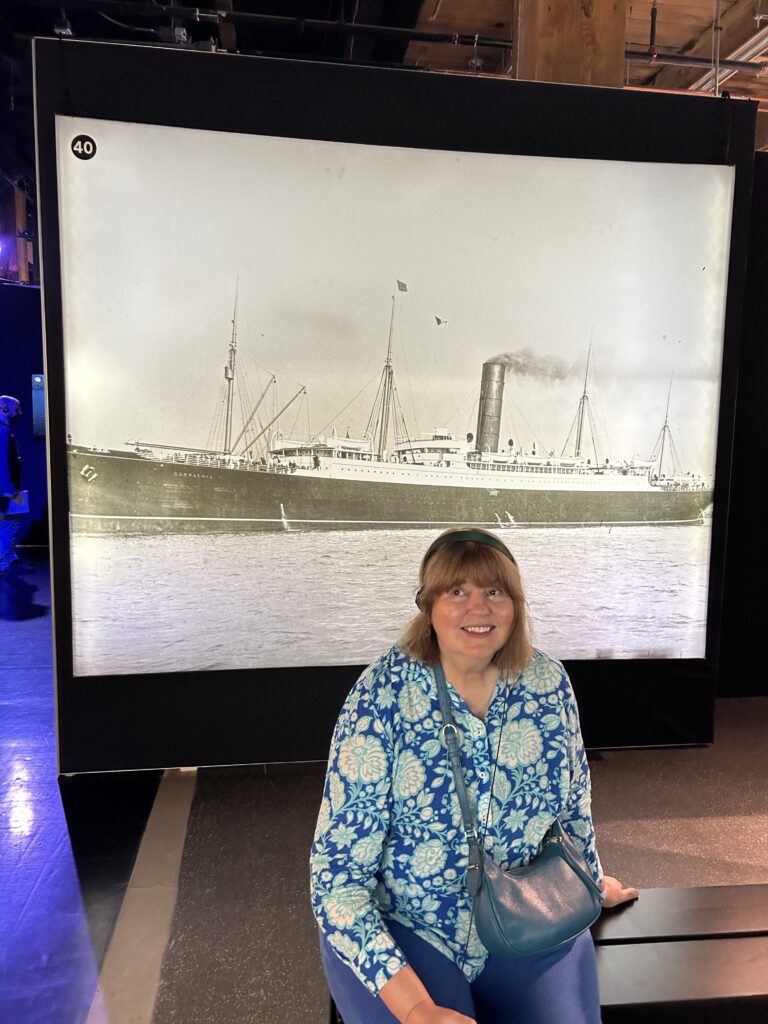
Boston Whaler is known for producing unsinkable boats. The company’s boats are built with a Unibond construction, which involves two precisely engineered molded hull pieces fitted together and filled with foam. This design makes the boats unsinkable, even when fully swamped or under the worst, repeated abuse. The unsinkable feature is a key selling point for Boston Whaler, and the company has built a reputation for producing boats with exceptional safety and reliability. All Boston Whaler boats are advertised as unsinkable, thanks to their Unibond construction, which provides smart design, high-quality construction, and forward-thinking technology, making them a popular choice for boaters seeking peace of mind on the water.

Boston Whaler’s unsinkable reputation is rooted in its innovative and revolutionary design. The company’s founder, Richard “Dick” Fisher, created the “Unsinkable Legend” with a daring launch in 1961, when he sawed a Boston Whaler boat in half and drove away in the remaining portion. This demonstration showcased the boat’s unsinkable nature, which was made possible by a cutting-edge foam-and-fiberglass construction process. The boats are built with a Unibond construction, involving two precisely engineered molded hull pieces fitted together and filled with foam, making them unsinkable even when fully swamped or under the worst, repeated abuse. This design feature has been a key selling point for Boston Whaler, and the company has built a reputation for producing boats with exceptional safety and reliability. The unsinkable nature of Boston Whaler boats has been put to the test in real-life situations and has consistently proven itself to be one of the safest boats on the water, contributing to its legendary status in maritime history. The company doesn’t make sailboats.
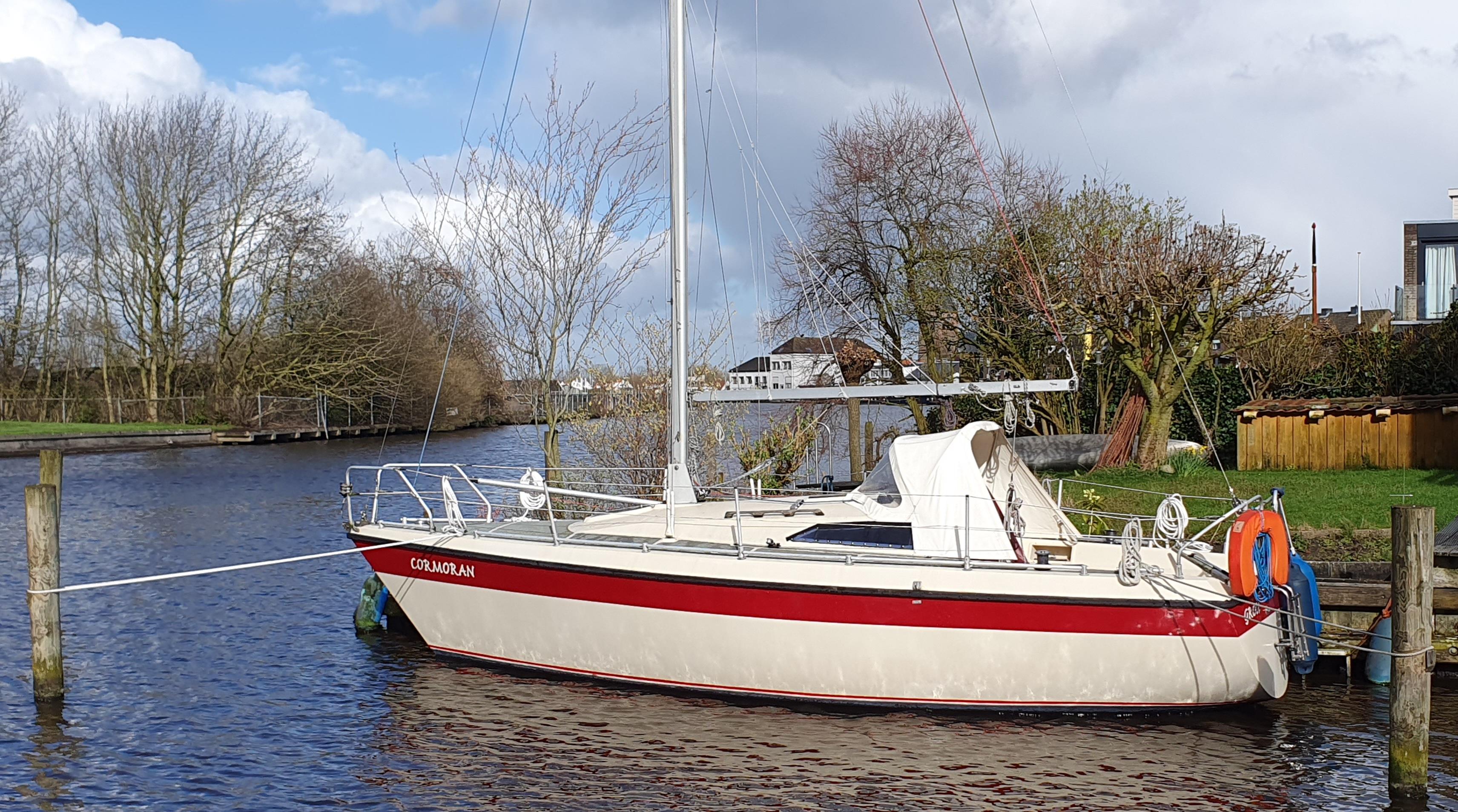
ETAP sailboats are advertised as unsinkable. ETAP Yachting, the builder of ETAP sailboats, is known for its double-skinned construction and foam-filled interiors, which provide the boats with unsinkable properties. This design feature has been a key selling point for ETAP sailboats, and the company has built a reputation for producing unsinkable vessels, particularly in the smaller size ranges.
The Macgregor 26 sailboats are often advertised as unsinkable due to its built-in foam compartments, which provide flotation and allow the boat to float. This feature is highlighted as a safety benefit, particularly for those concerned about the boat’s stability and the reassurance it provides, especially for children. However, it’s important to note that the unsinkable claim is based on the presence of built-in foam compartments rather than the same double-skinned construction and foam-filled interiors found in ETAP sailboats.
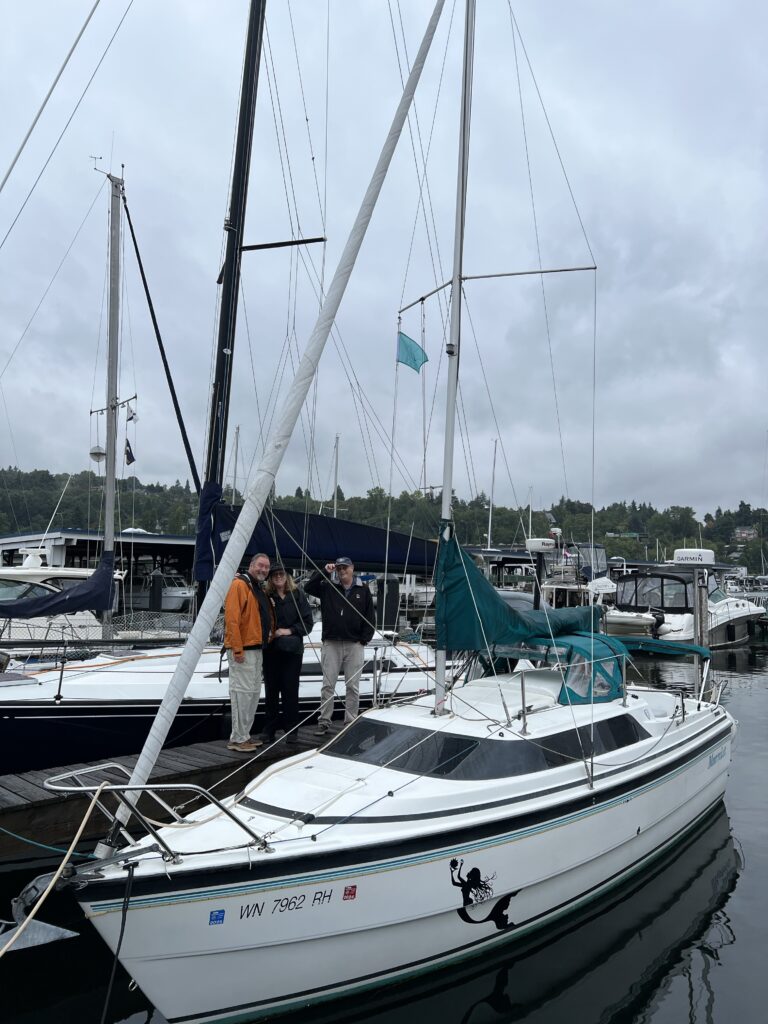
The Macgregor 26’s unsinkable feature is often cited as a unique selling point and a source of reassurance for potential owners. Rather than double-skinned construction the Macgregor 26s use a double hull. The boats have tanks used for water ballast that are essentially a second hull.
The Titanic was equipped with a total of 20 lifeboats, which can be split into three different types:

- Wooden Lifeboats: There were 14 standard wooden lifeboats, each measuring 30 feet long, 9 feet 1 inch wide, and 4 feet deep. These boats had a capacity of 65 persons each and were designed by Harland and Wolff Chief Draughtsman Roderick Robert Crispin Chisholm124.
- Engelhardt Collapsible Lifeboats: There were four Engelhardt collapsible lifeboats, each measuring 27 feet 5 inches long, 8 feet wide, and 3 feet deep, with a capacity of 47 persons each. These had collapsible canvas sides and could be stowed almost flat against a wall or bulkhead, taking up a relatively small amount of deck space124.
- Wooden Cutters: Additionally, there were two wooden cutters, each with a capacity of 40 persons3. During the evacuation, the efforts primarily focused on the standard lifeboats and the collapsible lifeboats. Therefore, the emergency cutters were not deployed for the purpose for which they were intended during the Titanic’s sinking12345.
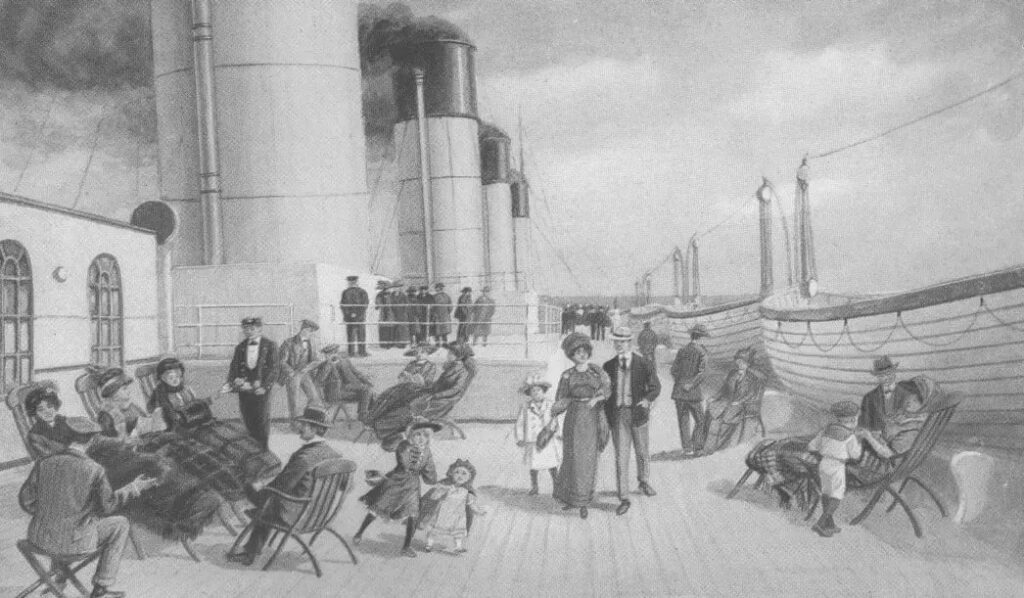
On May 6, 2006, Lillian Gertrud Asplund, the last American survivor of the sinking of the Titanic, died in Shrewsbury, Massachusetts, at age 99. Asplund lost her father and three brothers when the ship went down in the North Atlantic after hitting an iceberg.
The wooden lifeboats were clinker-built and the collapsible lifeboats had collapsible canvas sides. The wooden lifeboats were designed to carry 65 people each, and the collapsible lifeboats were designed to carry 47 people each. The total lifeboat capacity was 11,327.9 cubic feet, theoretically capable of taking 1,178 people4.

As for the sinkability of the lifeboats, the standard wooden lifeboats and the Engelhardt collapsible lifeboats were designed to be unsinkable. The wooden lifeboats were constructed with airtight buoyancy tanks incorporated into the boats’ hulls, and the collapsible lifeboats had collapsible canvas sides, which would have provided additional buoyancy in the event of swamping. Therefore, under normal circumstances, these lifeboats (like Boston Whalers, ETAPS, and Macgregor 26s of today) were not sinkable.
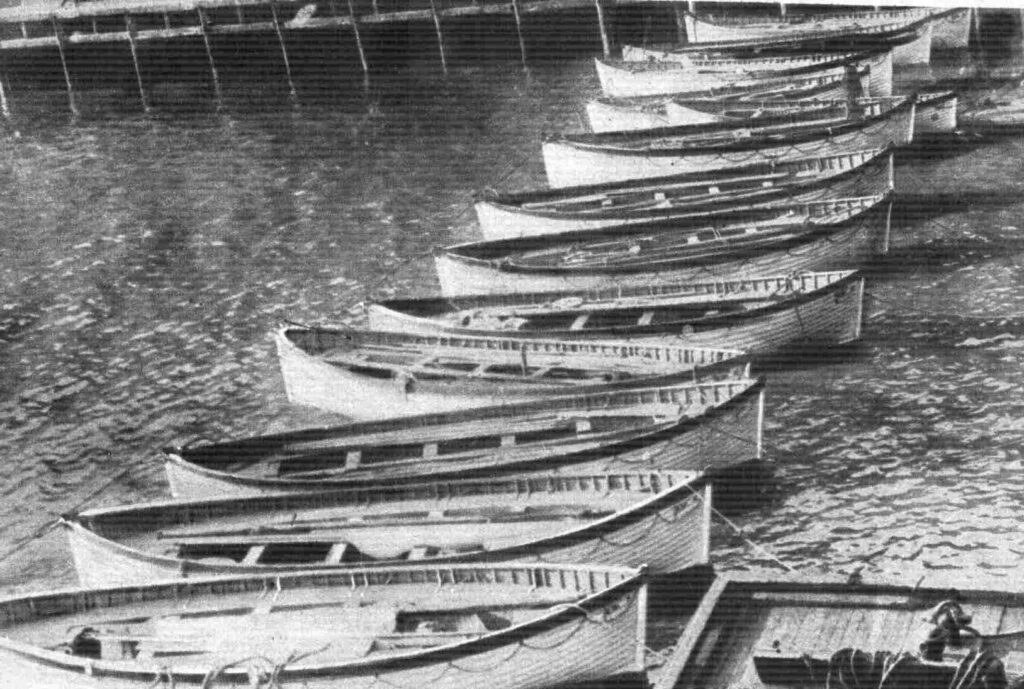
The standard wooden lifeboats, the collapsible lifeboats and the cutters were each equipped with eight oars for rowing and one for steering. The oars were likely around 12 to 14 feet in length, which was a common size for the oars used in the lifeboats of that era.
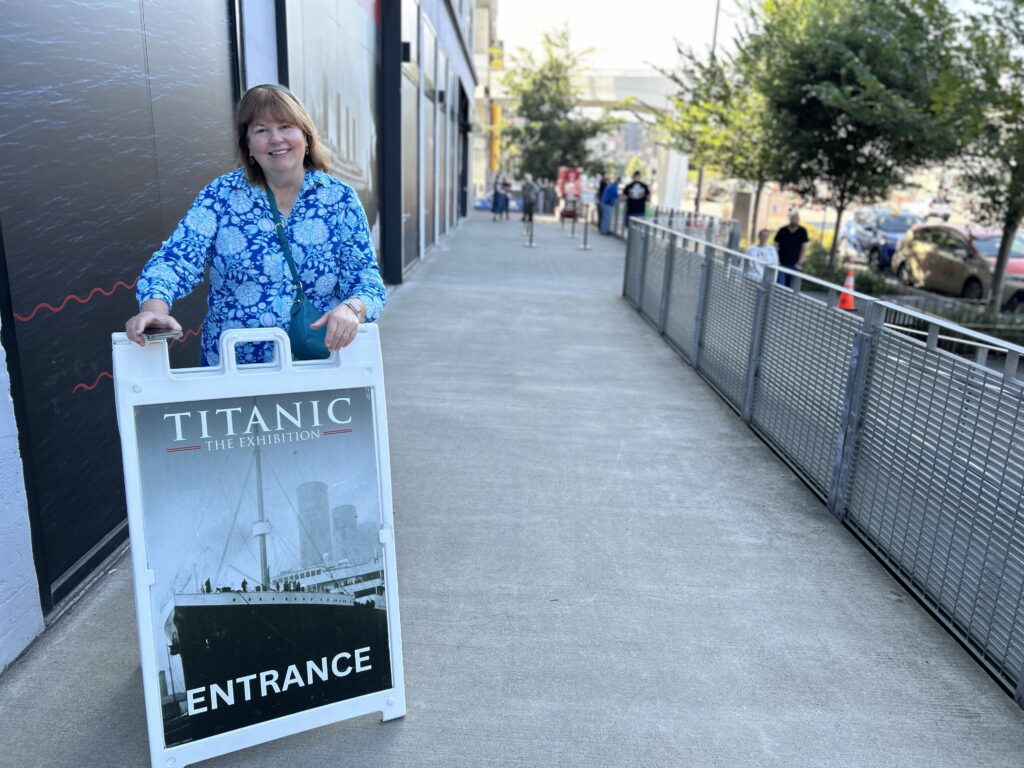
From Puget Sound to the North Atlantic: How Titan Linked Seattle to the Titanic
Key takeaway: A single submersible—built by a Seattle-area startup, using Boeing-sourced carbon fiber and first prototyped beside the University of Washington—created an unexpected bridge between Puget Sound and the Titanic wreck. Its 2023 implosion, Coast Guard findings and ensuing lawsuits now shape how deep-sea tourism will be regulated.
1. Seattle’s Fingerprints on Titan
Seattle’s involvement in the Titan submersible project is evident through multiple key connections.
- OceanGate, the company behind Titan, was founded in Seattle in 2009 and later established its headquarters on the Everett waterfront.
- The University of Washington contributed significantly; its Applied Physics Laboratory helped co-design OceanGate’s initial steel prototype, Cyclops 1, and conducted pressure testing on one-third-scale carbon-fiber models for Titan around 2015 to 2016.
- Boeing’s role came through the supply chain, as OceanGate purchased “past-shelf-life” carbon fiber from Boeing’s 787 program at a discounted price for use in Titan’s hull, although Boeing confirmed it had no design involvement.
- Additionally, Stockton Rush, OceanGate’s CEO and co-founder, lived on Mercer Island after relocating to Seattle in 1990, while fellow co-founder Guillermo Söhnlein later moved away from the area to Northern Virginia and eventually Barcelona.
Collectively, these ties show that much of the engineering talent, materials sourcing, and early testing of the Titan submersible had strong roots in the Seattle and Puget Sound region, even though the tragedy occurred 3,800 km away in the North Atlantic.
2. How a Skagit County Hull Ended Up in Court
- Builder: Janicki Industries of Sedro-Woolley, WA filament-wound, cured and autoclave-bonded Titan’s second-generation 5-inch-thick carbon-fiber cylinder1112.
- Lawsuit: After the implosion, the family of Titanic expert Paul-Henri Nargeolet sued OceanGate, Janicki and others for more than $50 million. Janicki petitioned in August 2024 to move the case from Washington Superior Court to U.S. District Court; the motion is still pending131415.
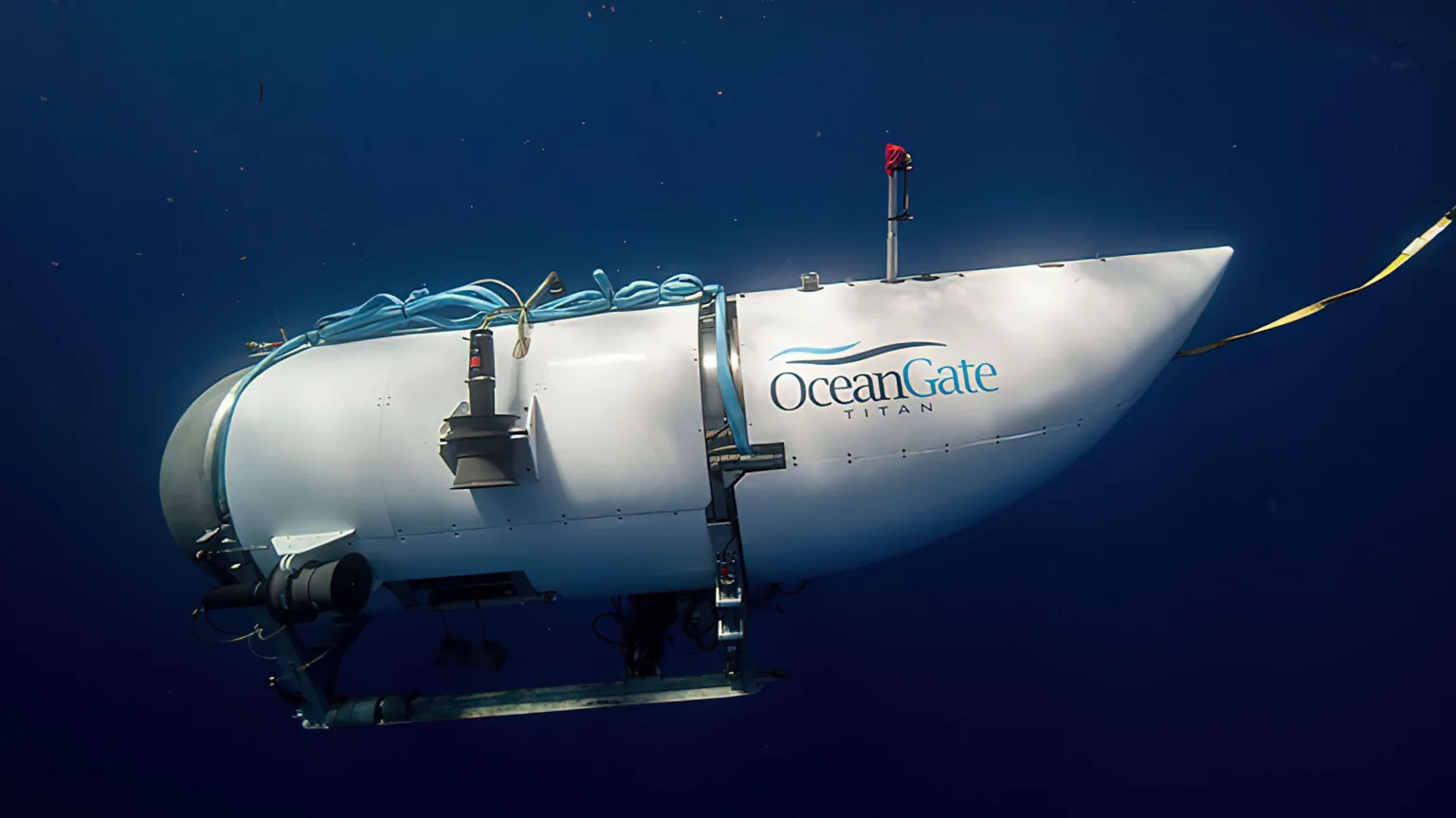
3. Coast Guard Findings (August 2025)
The Marine Board of Investigation’s 335-page report called the loss of Titan “preventable.” Core conclusions16171819:
- Design & certification gaps: Carbon-fiber pressure hull never met any class-society rules; tested to only 1.09× expected pressure (standard is 1.25–1.5×).
- Manufacturing defects: Wrinkles, voids and porosity found in recovered hull sections trace back to lay-up and cure process2021.
- Flawed safety culture: Leadership ignored repeated internal and external warnings and relied on unproven acoustic monitoring in lieu of non-destructive testing.
- Regulatory vacuum: Commercial tourist subs operating beyond 300 m fall outside most flag-state rules, prompting calls for new U.S. and IMO standards.
4. The Story on Screen
Netflix’s 2025 feature documentary “Titan: The OceanGate Disaster” premiered at Tribeca and streams globally22232425. Critics praise its whistle-blower interviews and Coast Guard-hearing footage for illustrating how Seattle-based ambition, venture-capital urgency and lax oversight converged to seal Titan’s fate. HBO’s “Implosion: The Titanic Sub Disaster” offers a parallel deep-dive with exclusive inquiry video26.
5. Carbon Fiber: Great for Explosions, Poor for Implosions
How Carbon Fiber Performs Under Different Pressure Conditions:
1. Under Internal Pressure (e.g., explosions, gas tanks, airplane fuselages):
- Carbon fibers experience tensile loading—meaning they are pulled apart, not crushed.
- Carbon fiber performs exceptionally well in this mode due to its extremely high tensile strength (up to 7 gigapascals, about four times stronger than steel).
- Applications like airplane fuselages, scuba tanks, and rocket bodies benefit from this strength and durability.
2. Under External Pressure (e.g., implosions, deep-sea submersibles):
- Carbon fibers face compressive loading—meaning they are being crushed.
- The fibers are much weaker in compression than in tension, with compressive strength typically only 30% to 60% of their tensile strength.
- Compression stresses can cause microscopic flaws (such as delamination or voids) to grow rapidly and unpredictably.
- This makes carbon fiber unreliable under conditions like deep-sea implosion, where the external pressure compresses the hull inward.
Conclusion:
Carbon fiber excels under tension (such as with internal explosions or pressurized vessels) but struggles with external compression (such as in ocean-depth submersibles), where structural failure can happen suddenly with little warning. Unlike metals—which may deform gradually before failing—carbon composites can shatter abruptly due to hidden flaws under compressive stress.
Stated simply, carbon fiber is a champ in tension but a weakling in compression. Internal explosions push outward, keeping fibers taut; abyssal water loads push inward, crushing the laminate like a soda can. Metals deform before failing, giving warning; composites can shatter without notice28.
6. Lasting Impacts for Washington State
- Research reset: UW has distanced itself from carbon-fiber hull work, emphasizing that its agreement covered only shallow-water prototypes29.
- Aerospace cautionary tale: Boeing composite engineers now cite Titan when teaching compression-critical design limits for 787 barrel sections630.
- Legal and regulatory cloud: The Janicki suit will test whether suppliers must independently validate experimental deep-sea designs; Coast Guard recommendations aim to close loopholes before the next startup dives deep.
Seattle’s aerospace know-how, academic labs and composite fabricators enabled Titan’s birth—and, tragically, helped expose the material and cultural shortcomings that doomed it. The Pacific Northwest is now central to rewriting the rulebook for human ventures into the hadal depths.



Historic SS United States departs from Philadelphia at last
https://www.axios.com/local/philadelphia/2025/02/19/ss-united-states-departs-philadelphia?utm_source=flipboard&utm_content=AxiosNews/magazine/Axios+Local:+Philadelphia
Major N.J. bridges to close as an ocean liner is towed out to sea
https://www.nj.com/news/2025/02/major-nj-bridges-to-close-as-an-ocean-liner-is-towed-out-to-sea.html?utm_source=flipboard&utm_content=topic/pennsylvania
The **SS United States** is a retired ocean liner that holds a significant place in maritime history. Built between 1950 and 1951 by the Newport News Shipbuilding and Drydock Company for United States Lines, she was designed by the renowned naval architect William Francis Gibbs. The ship was launched on June 23, 1951, and embarked on her maiden voyage on July 3, 1952[1][2].
### Record and Achievements
The SS United States is celebrated for her speed and engineering prowess. She set the transatlantic speed record on her maiden voyage, completing the journey from New York to England in just three days, ten hours, and 40 minutes, and she still holds the Blue Riband for the fastest transatlantic crossing[1][2]. The ship was capable of reaching speeds of up to 38.32 knots (44 mph), making her the fastest ocean liner ever built[2][4].
### Design and Features
The SS United States was designed with both luxury and safety in mind. She was constructed almost entirely out of fireproof materials, with the exception of her grand pianos, which were made from fire-resistant mahogany[2]. The ship was also built to be converted into a troop transport if necessary, capable of carrying 14,000 troops over 10,000 miles without refueling[2]. Her design included a double hull and extensive fireproofing, making her one of the safest passenger ships of her time[4].
### Restoration Attempts and Current Status
Since being retired from service in 1969, the SS United States has faced numerous challenges regarding her preservation. She has been docked in Philadelphia since 1996, where she remains to this day[2][4]. The SS United States Conservancy, which acquired the ship in 2011, has been actively fundraising and seeking partners to restore and repurpose the vessel as a museum, hotel, and event space[1][3].
Despite these efforts, the future of the SS United States remains uncertain. The ship has been stripped of much of her interior, and while she remains structurally sound, the cost of restoration is substantial. There have been ongoing discussions and proposals, but as of now, no definitive plans have been finalized[3][4].
### Potential for Scrapping
The possibility of scrapping the SS United States has been a looming threat due to the high costs associated with her maintenance and restoration. However, the SS United States Conservancy continues to work towards finding a viable solution to preserve this iconic piece of maritime history[1][3]. The ship’s fate hinges on securing sufficient funding and a sustainable plan for her future use.
In summary, the SS United States is a remarkable vessel with a storied past and a record of unparalleled speed. While her future remains uncertain, efforts to restore and repurpose her continue, driven by a desire to preserve this symbol of American innovation and maritime achievement.
Sources
[1] SS United States – Wikipedia https://en.wikipedia.org/wiki/SS_United_States
[2] Fast Facts – SS United States Conservancy https://www.ssusc.org/fast-facts
[3] The Ship — SS United States Conservancy https://www.ssusc.org/the-ship
[4] SS United States – Great Ocean Liners https://www.greatoceanliners.com/ss-united-states
[5] SS United States https://united-states-lines.org/ss-united-states/
[6] The SS United States: Philadelphia’s Abandoned Ocean Liner https://www.abandonedamerica.us/ss-united-states
[7] SS UNITED STATES | MARAD – Maritime Administration https://www.maritime.dot.gov/multimedia/ss-united-states
[8] Our Yard History: Docking the Liner SS United States – DVIDS https://www.dvidshub.net/news/433766/our-yard-history-docking-liner-ss-united-states
[9] History: Retirement – SS United States Conservancy https://www.ssusc.org/history-retirement
[10] Record-Breaking SS United States to Be Restored to Its Former … https://observer.com/2016/02/record-breaking-ss-united-states-may-be-restored-to-its-former-grandeur/
[11] The work being done to save historic SS United States … – YouTube https://www.youtube.com/watch?v=NRrVLe-41wY
[12] Is there any reason why the SS United States has just been … – Reddit https://www.reddit.com/r/Oceanlinerporn/comments/16kjz3d/is_there_any_reason_why_the_ss_united_states_has/
[13] SS United States Conservancy https://www.ssusc.org
[14] Anyone Know Where to Park the S.S. United States? https://www.curbed.com/2024/01/ss-united-states-ship-redevelopment-rxr-new-york.html
[15] Is this the end of the road for the SS UNITED STATES? https://forum.gcaptain.com/t/is-this-the-end-of-the-road-for-the-ss-united-states/68772
[16] Iconic Ocean Liner SS United States Ordered to Leave Berth by … https://maritime-executive.com/article/iconic-ocean-liner-ss-united-states-order-to-leave-berth-by-september
[17] Historic SS United States is evicted. Where can America’s flagship go? https://www.usatoday.com/story/news/nation/2024/06/21/ss-united-states-evicted-americas-flagship/74170961007/
[18] Historic ‘SS United States’ Faces Eviction from Philadelphia Pier https://gcaptain.com/historic-ss-united-states-faces-eviction-from-philadelphia-pier/
Based on the search results provided, I can offer the following information about the current condition of the SS United States at her location in Philadelphia:
1. The SS United States is currently docked at Pier 82 on the Delaware River in South Philadelphia, where she has been berthed since 1996[3]. As of 2024, the ship has been in this location for approximately 28 years[1][2].
2. Despite her long period of inactivity and faded exterior appearance, the SS United States is reported to remain structurally sound. This is considered a testament to her original design, materials, and workmanship[3].
3. However, the ship has been stripped of much of her interior over the years. The current state of the interior is not detailed in the provided search results, but it’s likely that significant work would be needed to restore or repurpose the internal spaces[1][2].
4. The vessel is currently incapacitated and unable to move under her own power. This complicates any potential relocation efforts[2].
5. While the ship’s exterior may show signs of age and weathering, she remains an impressive sight at 990 feet long (about five city blocks) and 101 feet wide[3].
6. The SS United States Conservancy, which owns and maintains the ship, has been working to preserve her and transform her into a museum, hotel, or entertainment venue. However, these efforts have faced numerous challenges[1][2].
7. As of June 2024, the ship is facing eviction from her current berth due to a legal dispute with the landlord, Penn Warehousing. A federal judge has ordered the SS United States to vacate her current location by September 12, 2024[1][2].
In summary, while the SS United States remains structurally sound, her current condition reflects years of disuse and exposure to the elements. The ship faces an uncertain future as she must find a new berth and secure funding for her preservation and potential repurposing.
Sources
[1] SS United States Conservancy https://www.ssusc.org
[2] Historic SS United States is evicted. Where can America’s flagship go? https://www.usatoday.com/story/news/nation/2024/06/21/ss-united-states-evicted-americas-flagship/74170961007/
[3] Fast Facts – SS United States Conservancy https://www.ssusc.org/fast-facts
[4] SS United States – Great Ocean Liners https://www.greatoceanliners.com/ss-united-states
[5] Historic SS United States is ordered out of its berth in Philadelphia https://apnews.com/article/united-states-historic-ship-philadelphia-rent-dispute-3f2bd92e9a0e563f1bdf8935450a217e
[6] Historic SS United States is ordered out of its berth in Philadelphia … https://abcnews.go.com/US/wireStory/historic-ship-ss-united-states-ordered-berth-philadelphia-111191950
[7] Iconic Ocean Liner SS United States Ordered to Leave Berth by … https://maritime-executive.com/article/iconic-ocean-liner-ss-united-states-order-to-leave-berth-by-september
[8] SS United States future uncertain as owners push to repurpose amid … https://www.fox29.com/news/ss-united-states-future-uncertain-as-owners-push-to-repurpose-amid-court-fight
[9] SS United States – Wikipedia https://en.wikipedia.org/wiki/SS_United_States
[10] The SS United States: Philadelphia’s Abandoned Ocean Liner https://www.abandonedamerica.us/ss-united-states
[11] SS United States https://united-states-lines.org/ss-united-states/
[12] The work being done to save historic SS United States … – YouTube https://www.youtube.com/watch?v=NRrVLe-41wY
[13] Redevelopment — SS United States Conservancy https://www.ssusc.org/redevelopment
[14] Anyone Know Where to Park the S.S. United States? https://www.curbed.com/2024/01/ss-united-states-ship-redevelopment-rxr-new-york.html
[15] Redevelopment Plan Released for Iconic Ocean Liner SS United … https://maritime-executive.com/article/redevelopment-plan-released-for-iconic-ocean-liner-ss-united-states
[16] Record-Breaking SS United States to Be Restored to Its Former … https://observer.com/2016/02/record-breaking-ss-united-states-may-be-restored-to-its-former-grandeur/
[17] Real estate firm advances plan to restore SS United States https://professionalmariner.com/real-estate-firm-advances-plan-to-restore-ss-united-states/
[18] Is this the end of the road for the SS UNITED STATES? https://forum.gcaptain.com/t/is-this-the-end-of-the-road-for-the-ss-united-states/68772
The **SS United States** is a retired ocean liner that holds a significant place in maritime history. Built between 1950 and 1951 by the Newport News Shipbuilding and Drydock Company for United States Lines, she was designed by the renowned naval architect William Francis Gibbs. The ship was launched on June 23, 1951, and embarked on her maiden voyage on July 3, 1952[1][2].
### Record and Achievements
The SS United States is celebrated for her speed and engineering prowess. She set the transatlantic speed record on her maiden voyage, completing the journey from New York to England in just three days, ten hours, and 40 minutes, and she still holds the Blue Riband for the fastest transatlantic crossing[1][2]. The ship was capable of reaching speeds of up to 38.32 knots (44 mph), making her the fastest ocean liner ever built[2][4].
### Design and Features
The SS United States was designed with both luxury and safety in mind. She was constructed almost entirely out of fireproof materials, with the exception of her grand pianos, which were made from fire-resistant mahogany[2]. The ship was also built to be converted into a troop transport if necessary, capable of carrying 14,000 troops over 10,000 miles without refueling[2]. Her design included a double hull and extensive fireproofing, making her one of the safest passenger ships of her time[4].
### Restoration Attempts and Current Status
Since being retired from service in 1969, the SS United States has faced numerous challenges regarding her preservation. She has been docked in Philadelphia since 1996, where she remains to this day[2][4]. The SS United States Conservancy, which acquired the ship in 2011, has been actively fundraising and seeking partners to restore and repurpose the vessel as a museum, hotel, and event space[1][3].
Despite these efforts, the future of the SS United States remains uncertain. The ship has been stripped of much of her interior, and while she remains structurally sound, the cost of restoration is substantial. There have been ongoing discussions and proposals, but as of now, no definitive plans have been finalized[3][4].
### Potential for Scrapping
The possibility of scrapping the SS United States has been a looming threat due to the high costs associated with her maintenance and restoration. However, the SS United States Conservancy continues to work towards finding a viable solution to preserve this iconic piece of maritime history[1][3]. The ship’s fate hinges on securing sufficient funding and a sustainable plan for her future use.
In summary, the SS United States is a remarkable vessel with a storied past and a record of unparalleled speed. While her future remains uncertain, efforts to restore and repurpose her continue, driven by a desire to preserve this symbol of American innovation and maritime achievement.
Sources
[1] SS United States – Wikipedia https://en.wikipedia.org/wiki/SS_United_States
[2] Fast Facts – SS United States Conservancy https://www.ssusc.org/fast-facts
[3] The Ship — SS United States Conservancy https://www.ssusc.org/the-ship
[4] SS United States – Great Ocean Liners https://www.greatoceanliners.com/ss-united-states
[5] SS United States https://united-states-lines.org/ss-united-states/
[6] The SS United States: Philadelphia’s Abandoned Ocean Liner https://www.abandonedamerica.us/ss-united-states
[7] SS UNITED STATES | MARAD – Maritime Administration https://www.maritime.dot.gov/multimedia/ss-united-states
[8] Our Yard History: Docking the Liner SS United States – DVIDS https://www.dvidshub.net/news/433766/our-yard-history-docking-liner-ss-united-states
[9] History: Retirement – SS United States Conservancy https://www.ssusc.org/history-retirement
[10] Record-Breaking SS United States to Be Restored to Its Former … https://observer.com/2016/02/record-breaking-ss-united-states-may-be-restored-to-its-former-grandeur/
[11] The work being done to save historic SS United States … – YouTube https://www.youtube.com/watch?v=NRrVLe-41wY
[12] Is there any reason why the SS United States has just been … – Reddit https://www.reddit.com/r/Oceanlinerporn/comments/16kjz3d/is_there_any_reason_why_the_ss_united_states_has/
[13] SS United States Conservancy https://www.ssusc.org
[14] Anyone Know Where to Park the S.S. United States? https://www.curbed.com/2024/01/ss-united-states-ship-redevelopment-rxr-new-york.html
[15] Is this the end of the road for the SS UNITED STATES? https://forum.gcaptain.com/t/is-this-the-end-of-the-road-for-the-ss-united-states/68772
[16] Iconic Ocean Liner SS United States Ordered to Leave Berth by … https://maritime-executive.com/article/iconic-ocean-liner-ss-united-states-order-to-leave-berth-by-september
[17] Historic SS United States is evicted. Where can America’s flagship go? https://www.usatoday.com/story/news/nation/2024/06/21/ss-united-states-evicted-americas-flagship/74170961007/
[18] Historic ‘SS United States’ Faces Eviction from Philadelphia Pier https://gcaptain.com/historic-ss-united-states-faces-eviction-from-philadelphia-pier/
The Titanic wasn’t capable of setting speed records. This ship was
https://media.npr.org/assets/img/2024/03/11/ss-united-states-at-sea_4_custom-2d1be8ebea4a50c051e2eddb77393769f7de7cac-s1600-c85.webp
The fastest ocean liner to ever cross the Atlantic – in both directions – has been languishing at a pier in south Philadelphia for more than twenty-five years. However, the days of the rusting SS United States calling at Pier 82 in the City of Brotherly Love are likely numbered. The 990 ft. ship that’s bigger than the Titanic is facing eviction.
On her maiden voyage in 1952, the SS United States won the coveted Blue Riband from Great Britain. What came to be called “America’s Flagship” crossed the Atlantic in 3 days, 10 hours, and 40 minutes – besting the time set by the RMS Queen Mary by 10 hours. To this day, the SS United States holds the record.
https://www.npr.org/2024/03/11/1237529064/the-fastest-ocean-liner-to-cross-the-atlantic-faces-eviction-from-pier